14 Pros and Cons of Being a Tour Guide
Home / Pros and Cons / 14 Pros and Cons of Being a Tour Guide
Get information on Travel Agent Training programs by entering your zip code and request enrollment information.

Trending Careers

So many people around the world love to travel and wish they had a job where they could do both simultaneously.
One such way to do so is to become a tour guide, which allows you to travel locally, domestically, or internationally and get paid to do so!
While this may sound like a glamorous dream job, there are some drawbacks as well as it is not just adventure and excitement every day.
To learn more about becoming a tour guide, it is important to consider the pros and cons before deciding. Keep reading to learn about this interesting career!
Table of Contents
1. Can Work in Different Locations
2. improve people skills, 3. interesting work, 4. learn about different destinations, 5. learn new languages, 6. no traditional office, 7. work with a variety of people, 1. deal with difficult people, 2. immediate changes in schedule, 3. low job security, 4. not lucrative, 5. reliant on seasons, 6. subjected to inclement weather, 7. work holidays and weekends, pros and cons of being a tour guide – summary table, should you become a tour guide, pros of being a tour guide.
Becoming a tour guide has numerous excellent benefits, with the best being:
Depending on the tour guide type, you could work in a variety of locations.
Some tour guides offer walking tours around the town or city, others manage tourists going on day trips to sites further away.
Some tour guides are involved with multi-day trips around their country while others travel internationally with groups.
The best tour guides get to embark on international trips with larger tourist groups.
As a tour guide, you really get to work on your soft skills through various interactions with tourists, other guides, and employees at different attractions.
Throughout your daily routes, you encounter countless individuals, some pleasant, some quiet, some difficult, some loud, and you learn how to deal with distinct types of people.
Since you get the opportunity to gain experience about all types of sites, attractions, and cultures, being a tour guide presents a variety of interesting experiences and interactions that lead to beautiful journeys.
No day will ever be boring or the same and there is a spontaneous aspect to being able to visit various locations.
As a result of these travels, you get to learn about different destinations.
Given that the tour company will give you specifics on what they want you to cover in the tour, you will likely master all the interesting details about your town or city first.
Next, you may move on to one day or multi-day trips, where you will learn about additional destinations and finally, you can graduate to the international circuit to learn about other countries, all of which make you a more well-rounded tour guide and individual.
Since you are meeting a variety of people, you pick up bits and pieces of different languages.
Some companies, they will pay for you to learn other languages since it is such a valuable skill that helps with the customer service you provide.
Other companies may not foot the bill, but there are plenty of apps and free online learning opportunities that can help you improve your tour guide service.
One of the best aspects of being a tour guide in the world is your office.
Many people are not built to sit in cube farms all day for their entire careers.
Some love being outside and looking at beautiful sites.
Best of all, you can work without a boss or colleagues watching over you, which can really take the stress off your back.
The final major benefit of becoming a tour guide is the opportunity to collaborate with people from different locations, countries, and backgrounds, with a variety of experiences.
Although you may only be together for a short time, you develop friendships and relationships with your clients.
This also allows you to gain experience more about different religions, languages, and cultures.
Learning more about your clients is an excellent way to cater the sites to them while providing exceptional customer service!
Cons of Being a Tour Guide
While there are many benefits to becoming a tour guide, it is important to also understand the drawbacks.
Whether you are a tour guide in your local city or a traveling tour guide, you will have to deal with different people with unique needs and personalities every day you work.
Sometimes, there are problematic and difficult individuals who are not well-behaved, complain about everything, or are generally miserable and want everyone to know.
To deal with this individual type, you must have excellent patience, professionalism, and customer service.
In many instances, being a tour guide is spontaneous, meaning there is little to no notice of schedule changes.
This is because clients’ schedules changes, there are cancellations, and often no-shows.
This can be incredibly frustrating when you need to make rent payments or have a major purchase approaching.
Being a tour guide has low job security, which can last for an extended period.
Tour guides can easily be replaced, especially if not great at their job.
There are many others in cities and towns across the world that can replace a tour guide.
If you are laid off or fired, it can be difficult to find another job.
Even in the largest cities, there are only so many tour companies, so word gets around about different employees within the industry.
One of the greatest issues of becoming a tour guide is it does not pay well.
As a result, you may need a second job to keep up with your payments and necessities.
This is especially the case in high cost of living areas.
That second job could be mundane and really not something that interests you.
Also, due to the low salaries, elderly poverty is an issue for many who can only afford to live, but do not have enough money to save for old age.
That means, you cannot be a tour guide your entire life, you need to have other skills.
The “high” travel season is typically over the summer between the end of May and the middle of September, depending on the location.
This is because children are out of school and teachers are off for the summer.
That means for tour guides, this is the busiest time of the year, and lucrative.
However, the remaining seasons are likely to be slow, so many companies temporarily lay off tour guides to save on costs.
Therefore, it is critical to have a second job as a backup for the offseason.
As a tour guide, you will spend most of your time outside, escorting groups to see beautiful natural landscapes, ancient monuments and architecture, and other local attractions.
That means, during inclement weather, you and your tour group may not get to see specific attractions, and you are subjected to rain and snow.
Aside from the tourist complaints about not being able to see a site, you could fall ill with constant exposure to the elements.
The final major drawback of becoming a tour guide is you will likely have to work holidays and weekends.
Your schedule is dependent on when tourists decide to book your services.
Most tourists are going to book in the summer, on weekends, and over holidays.
This could disrupt trips you want to take with your friends or family.
Instead, you must focus on strangers and ensuring they are having a good time.
Deciding whether to become a tour guide is a personal decision based on your individual preferences.
As a college student, this seems like a wonderful way to make money to put yourself through college.
However, as an older and more seasoned employee in any field, it may not be the best to make the career change, unless retired and looking for an interesting activity.
In any case, it is critical to weigh the pros and cons of becoming a tour guide before you decide.
Can you deal with a low salary for the rest of your life, or is this just a temporary, fun job?
Do you value knowledge and experience more than money?
While many of these questions relate to earning money.
It is a critical aspect of this job.
While there are many perks, if you cannot pay your bills then you will need to consider getting a second job, which you may hate.
Like with deciding upon any career path, many choices and considerations must be made to ensure you have a fruitful and enjoyable career!
Related Resources
- How to Become a Tour Guide
- 14 Pros and Cons of Being a Travel Agent
- 14 Pros and Cons of Being a Historian
- 14 Pros and Cons of Being a Flight Attendant
4 thoughts on “ 14 Pros and Cons of Being a Tour Guide ”
The role of a tour guide encourages continuous learning. You’re always researching, staying updated on local history and current events, which deepens your understanding of the destination.
Handling difficult situations can be challenging. Dealing with difficult tourists, emergencies, or unexpected situations can be stressful. Tour guides need to stay composed and handle situations with grace and professionalism.
Good read! Tour guides play a significant role in educating people about history, art, and local customs. This intellectual engagement can be personally satisfying.
Many tour guides enjoy the flexibility of their schedules, allowing them to pursue other interests or spend time with family and friends when there are no tours to conduct. It’s like a remote work.
Leave a Reply Cancel reply
Your email address will not be published. Required fields are marked *
Travel Guides, Info & Tips Blog
The Top 25 Qualities of an Effective Tour Guide-Guiding the Way
Are you passionate about travel and enjoy sharing your knowledge with others? Becoming a tour guide might be the perfect career path for you. Being a practical tour guide requires a unique set of skills and qualities that go beyond simply knowing the facts about a destination. In this article, we will explore the 25 qualities of a practical tour guide and how they contribute to creating memorable and enriching travel experiences.
Being an effective tour guide is not just about knowing the destination but also about possessing a range of qualities that enhance the overall experience for travelers. From excellent communication skills to a deep passion for the subject matter, a practical tour guide can make all the difference in creating memorable and meaningful experiences for their guests.
In this article, we will explore 25 essential qualities for any tour guide looking to excel in their profession. Whether you are already a tour guide or aspiring to become one, this comprehensive guide will provide valuable insights and tips to enhance your skills and become an exceptional tour guide.
Table of Contents
What Qualities Do I Need To Be A Tour Guide?
To be a successful tour guide, there are several essential qualities that you should possess.
- Firstly, strong communication skills are vital. As a tour guide, you will need to convey information to your clients clearly and engagingly effectively. Excellent verbal and written communication skills will help you effectively communicate historical facts, local customs, and interesting anecdotes.
- Secondly, a deep knowledge and passion for the subject matter is crucial. Whether you are guiding tourists through a historical city, leading a nature hike, or conducting a food tour, you should have a thorough understanding of the area’s history, culture, and attractions. This knowledge will not only enhance your credibility as a guide but also enable you to answer questions and provide interesting insights to your clients.
- Lastly, being personable and friendly are essential qualities for a tour guide. You will interact with people from various backgrounds and cultures, so being approachable and adaptable is critical. Your enthusiasm and positive attitude will not only make the tour more enjoyable for your clients but also help create a welcoming and inclusive environment.
In conclusion, to be a successful tour guide, you should possess strong communication skills, a deep knowledge and passion for the subject, and be personable and friendly. These qualities will help you effectively engage and connect with your clients, making their experience memorable and enjoyable.
What Skills Make A Tour Guide With 5-Star Quality?
Regarding being a tour guide with 5-star quality, several critical skills are essential. Firstly, excellent communication skills are crucial. A tour guide must effectively convey information, engage with their audience, and answer questions. Clear and concise communication is essential to ensure tourists have a memorable and enjoyable experience.
In addition to communication skills, a tour guide should also have extensive knowledge and expertise in the area they are guiding. This includes historical facts, cultural insights, and local tips and recommendations. A 5-star tour guide is well-prepared and can provide accurate and exciting information, enhancing the tour experience.
Furthermore, a tour guide with 5-star quality must possess exceptional customer service skills. They should be friendly, approachable, and able to create a positive and welcoming atmosphere. A great tour guide understands the importance of personalizing the experience for each tourist and goes above and beyond to ensure their satisfaction. From anticipating needs to providing an exceptional level of service, these skills are vital in creating a memorable tour experience.
What Is The Most Important Quality Of Becoming An Effective Tour Guide?
When it comes to becoming a practical tour guide, several qualities are important to possess. However, one of the most crucial qualities is knowledge. A tour guide must have extensive knowledge about the destination they are guiding tourists through. This includes knowing about the history, culture, landmarks, and other important aspects of the place. Being well-informed allows the tour guide to provide accurate and interesting information to the tourists, enhancing their overall experience.
In addition to knowledge, communication skills are also essential for an effective tour guide. Communicating clearly and concisely is important in delivering information to the tourists. A tour guide must be able to articulate their thoughts and ideas in a way that is easily understandable to a diverse group of people. Good communication skills also involve listening to the tourists’ questions and feedback and being able to respond appropriately.
Lastly, enthusiasm and passion for the job set apart a great tour guide from an average one. A tour guide who is genuinely excited about the destination and their role in showcasing it will be able to create a positive and engaging atmosphere for the tourists. Their enthusiasm will be contagious, making the tour more enjoyable and memorable for everyone involved.
What Are The 5 Roles Of A Tour Guide?
A tour guide plays multiple roles in ensuring a successful and enjoyable travel experience for their guests. Here are the five primary roles of a tour guide:
1. Informer: The primary role of a tour guide is to provide accurate and relevant information about the destination. They should be knowledgeable about the history, culture, landmarks, and other significant aspects of the place. Tour guides should be able to answer questions, share interesting facts, and engage their guests in informative discussions.
2. Interpreter: Tour guides bridge the gap between different cultures and languages. They act as interpreters, translating information and conversations for their guests. They ensure effective communication between locals and visitors, enhancing the understanding and appreciation of the destination.
3. Organizer: Tour guides are responsible for planning and organizing the itinerary. They arrange transportation, accommodation, and activities, ensuring a smooth and efficient travel experience. They handle logistics, such as coordinating schedules, managing reservations, and running any unforeseen circumstances that may arise during the trip.
25 Qualities Of An Effective Tour Guide Pdf
To view a PDF document that provides more detailed information on these 25 qualities of a practical tour guide, please click the link below: 25 Qualities of an Effective Tour Guide PDF.
25 Qualities Of An Effective Tour Guide Ppt
https://www.slideshare.net/jen199629/qualities-of-an-ideal-tour-guide
Skills Of A Tour Guide
- Communication Skills:
- Clear and confident speaking voice
- Appropriate language for the audience
- Ability to engage and connect with travelers
- Responsive to questions and concerns
- In-Depth Knowledge:
- Strong understanding of the destination’s history, culture, and attractions
- Staying updated on current events and changes in the area
- Organization and Time Management:
- Creating well-planned itineraries
- Efficient coordination of transportation and accommodations
- Handling unexpected situations effectively
- Interpersonal Skills:
- Building rapport with clients
- Friendliness and approachability
- Patience and attentiveness
- Sense of Humor:
- Creating a relaxed and enjoyable atmosphere
These skills and qualities collectively contribute to a tour guide’s ability to offer travelers an exceptional experience during their journey.
Characteristics of an Exceptional Tour Guide
- Knowledgeable: Possesses in-depth knowledge of the destination’s history, culture, and attractions.
- Excellent Communication Skills: Communicates information clearly and effectively to travelers.
- Enthusiastic: Inspires excitement and engagement among tour participants with their passion for the subject matter.
- Flexible: Adapts easily to unforeseen situations and changes in the itinerary.
- Organized: Ensures a smooth and efficient tour experience through careful planning and preparation.
- Problem-Solving Abilities: Capable of finding solutions quickly and efficiently, especially in challenging situations.
- Multilingual: Speaks multiple languages to cater to a diverse group of travelers.
How to Become an Effective Tour Guide
- Gain Extensive Knowledge: Conduct thorough research to acquire a deep understanding of the destination you’ll be guiding.
- Develop Communication Skills: Practice and consider attending public speaking courses to improve your ability to convey information effectively.
- Cultivate Enthusiasm: Stay curious and continuously learn about new attractions and experiences to maintain a high passion for your subject.
- Enhance Adaptability: Seek opportunities to work in different environments and practice handling unexpected situations to become more flexible.
- Improve Organizational Skills: Create detailed itineraries and proactively plan logistics for a well-organized tour.
- Sharpen Problem-Solving Abilities: Participate in scenario-based training programs or seek advice from experienced tour guides to become a more effective problem solver.
- Learn Additional Languages: Consider taking language courses or participating in immersion programs to become multilingual.
10 Characteristics Of A Tour Guide
- Knowledgeable
- Communication skills
- Flexibility
- Organizational skills
- Interpersonal skills
- Problem-solving
- Professionalism
- Sense of humor
As A Tour Guide, How Will You Manage Tourist With High Expectations?
Strategies for Managing Tourists with High Expectations
1. Listen Actively: Listen to tourists’ expectations, interests, and preferences.
2. Manage Expectations: Be transparent about what the tour can realistically offer and set clear expectations.
3. Provide Detailed Information: Ensure tourists have comprehensive information about the tour itinerary, attractions, and activities.
4. Be Knowledgeable and Professional: Demonstrate expertise in destinations, history, culture, and local customs.
5. Offer Personalized Experiences: Tailor the tour to cater to individual preferences, arranging special interests-based activities.
6. Maintain Effective Communication: Keep tourists informed about changes and provide alternative options.
7. Handle Complaints Professionally: Address dissatisfaction empathetically, offering solutions to resolve concerns.
8. Seek Feedback: Encourage tourists to provide feedback after the tour to improve future experiences.
What makes a great tour guide and host? | Rick Steves | TEDxSeattleSalon
In conclusion, a practical tour guide is vital in crafting unforgettable travel experiences. With extensive knowledge, excellent communication, and adaptability, they enrich journeys and create lasting memories. Beyond information, they foster a sense of camaraderie and storytelling, making them essential for exceptional adventures.
In conclusion, an effective tour guide plays a vital role in crafting unforgettable travel experiences. With qualities such as extensive knowledge, excellent communication, and adaptability, they enrich journeys and create lasting memories. Beyond information, they foster a sense of camaraderie and storytelling, making them essential for exceptional adventures.

The Pros and Cons of Guided Tours
As travel bloggers, we face a very real dilemma: Do we try to see and experience as much as possible during our trip, or do we allow ourselves more time to explore and wander at our leisure?
Both approaches have their own unique benefits and drawbacks – and if you find yourself wondering which is right for you, this blog will help you decide!
The Pros of Guided Tours
1. you get to see all the major points of interest. .
We took a tour bus to Mount Rainier National Park and were able to see all the items on our bucket list:
- Mt. Rainier (of course)
- Grove of the Patriarchs
- Reflection Lake
- Christine, Myrtle and Narada Falls
2. You always have someone to take your photo.

What’s more annoying than getting home from your trip only to realize all you have on your camera are selfies of your giant face with few recognizable details in the background?
Gone are the days of the selfie stick and, with them, all the semi-decent shots of you and your fellow traveler(s). But fear not! When traveling in a group, you can ask your tourmates to snap a few shots for you.
Disclaimer: OK, so the photos might not always be great, but at least they show more than your right arm and face.
3. [For extroverts only] You get to meet other travelers.

There’s something special about sharing an adventure with a bunch of strangers. During a guided tour to the Loire Valley in France, we ate a private, family-style meal at Château de Nitray with our tourmates, and it ended up being one of our favorite parts of the entire trip!
4. You don’t have to worry about transportation.
There are few things more terrifying than navigating public transportation in an unfamiliar destination, especially one in which you don’t know the local language.
We found ourselves in Paris trying to navigate the RER for a trip to Versailles. Though we successfully purchased our train tickets at the kiosks, the digital screens didn’t show any trains going to Versailles. Turns out, the announcements they were playing on the overhead speakers (in French) alerted travelers that there would be no trains to Versailles that day.
When we got back to the land of free wifi (thank you, Hotel Regina!), we booked a coach bus. We were thankful to have reliable – and air conditioned – transportation on this trip and many others!
5. You get the inside scoop.
With a local tour guide, you get more than just what’s written on the brochure. You get an insider’s perspective and opinion on the locale’s history, impact, people, traditions, celebrations and more. You discover the hidden gems and the funny stories that give each destination its character.
The Cons of Guided Tours
1. it always feels rushed..

No matter what tour you take or how long you’re at your destination, a guided tour always feels rushed. We’ve missed out on photo ops and off-the-beaten-path adventures by taking guided tours during which there’s no time to stop for these last-minute detours.
The photo above was taken through a bus window during a guided tour. We wanted to beg the driver to please pull over and stop so we could capture this beautiful scene, but we were on a time budget and couldn’t afford to do so.
2. There are usually people in your footage.
If you’re traveling with a large group, chances are that some of your tourmates will photobomb you. In Mount Rainier National Park, Mike was carefully setting up a shot of me walking across a bridge, under which was a beautiful waterfall.
As I was “acting” my way to the other side of the bridge, a group of our tourmates thought I was lost and swiftly entered the shot to guide me to a different location. Bye bye, dreamy footage. Hello, photobombers.
3. [For introverts only] You have to spend time with other travelers.
For some travelers, being with a group of strangers all day is a nightmare. It really depends on the crowd – we’ve had wonderful tourmates and we’ve had loud, obnoxious ones (who you can hear in every video we shot).
If you have time, call the tour company in advance and ask about the size of the tour group. This will help you decide which tour to take – or whether to take one at all.
4. Certain tours might not be worth your investment.
Guided tours range in price, but some can be pretty expensive depending on your destination. In some cases, they might not be worth your investment at all.
Consider this: We booked our Mt. Rainier day trip in advance and figured the weather probably wouldn’t be great. What we didn’t know is that when the weather isn’t great, it affects your chances of seeing the mountain at all, which was the main reason we booked the day trip.
When I asked our tour guide what our chances were of seeing Mt. Rainier, he wouldn’t even say. For a tour that cost $130 per person, that was a pretty risky gamble!
Read more about our hunt for Mount Rainier .
5. Guided tours can be exhausting.

I know, I know – first-world problems. But guided tours can seriously take a toll on you!
Most of our tours have been 12-hour day trips. We get up at the crack of dawn, head to the meet-up spot with nothing but a cup of coffee in our stomachs and set off on a long and often draining tour.
This is usually the trade-off when you decide that you want to see everything on your bucket list.
Whether you’re booking a guided tour or not, we wish you happy travels and hope this blog post helps you plan your next adventure!
We’re going to spend some time roaming on our own during our next vacation in Anaheim, California. Be sure to subscribe for updates and follow us on Instagram at @travtwogether .
Share this:
- Click to share on Pinterest (Opens in new window)
Emily Malott
3 responses to “The Pros and Cons of Guided Tours”
So true about yours. I’ve always felt rushed and exhausted. So I book time a few days before and after your in the country I toured!
[…] Guided tours that are included in packages afford you the opportunity of exploring the surrounding area. As useful as it is to have a local tour guide showing you the sights, it can limit where you can go. Pre-booked excursions are particularly applicable to first-time visitors, as they can experience the best of the local attractions on offer. However, returning visitors may find it rewarding to add a window of flexibility in their itinerary to do some of their own exploring. […]
thanks for the pros and cons about tour .
Discover more from Traveling Twogether
Subscribe now to keep reading and get access to the full archive.
Type your email…
Continue reading

Advantages and Disadvantages of Being A Tour Guide
Looking for advantages and disadvantages of Being A Tour Guide?
We have collected some solid points that will help you understand the pros and cons of Being A Tour Guide in detail.
But first, let’s understand the topic:
What is Being A Tour Guide?
A tour guide is a person who helps visitors explore and understand new places. They share interesting facts, stories, and directions. They make sure visitors are safe and enjoy their trip.
What are the advantages and disadvantages of Being A Tour Guide
The following are the advantages and disadvantages of Being A Tour Guide:

Advantages of Being A Tour Guide
- Meet people from around the world – Being a tour guide lets you interact with folks from various corners of the globe, enriching your understanding of their unique backgrounds and perspectives.
- Learn about different cultures – You can delve into diverse cultures, learning about their traditions, customs, and ways of life, which broadens your worldview.
- Improve communication skills – As a tour guide, your communication skills get a boost. You learn to convey information effectively, handle queries, and manage groups.
- Explore new places – You get the opportunity to discover new places. This not only satiates your wanderlust but also makes every working day an adventure.
- Boost your knowledge about history – Your understanding of history expands as you delve into the past of different places, enhancing your knowledge and making you a better storyteller.
Disadvantages of Being A Tour Guide
- Long working hours – Being a tour guide often means working beyond the typical 8-hour shift, which can lead to fatigue and burnout.
- Low pay for hard work – Despite putting in a lot of effort and energy, tour guides may not always be compensated fairly, which can be demotivating.
- Dealing with difficult tourists – Tour guides frequently encounter challenging tourists, which can test their patience and interpersonal skills.
- Lack of personal time – Personal time is scarce in this profession as guides are usually busy ensuring a good experience for tourists.
- Stress from constant travel – Constant travel, though exciting at first, can become a source of stress over time due to frequent adjustments to different environments and schedules.
- Advantages and disadvantages of Being A Teenage Mother
- Advantages and disadvantages of Being A Teacher
- Advantages and disadvantages of Batteries
You can view other “advantages and disadvantages of…” posts by clicking here .
If you have a related query, feel free to let us know in the comments below.
Also, kindly share the information with your friends who you think might be interested in reading it.
Leave a Reply Cancel reply
Your email address will not be published. Required fields are marked *
Save my name, email, and website in this browser for the next time I comment.

National Trust for Historic Preservation: Return to home page
Site navigation, america's 11 most endangered historic places.
This annual list raises awareness about the threats facing some of the nation's greatest treasures.
Join The National Trust
Your support is critical to ensuring our success in protecting America's places that matter for future generations.
Take Action Today
Tell lawmakers and decision makers that our nation's historic places matter.
Save Places
- PastForward National Preservation Conference
- Preservation Leadership Forum
- Grant Programs
- National Preservation Awards
- National Trust Historic Sites
Explore this remarkable collection of historic sites online.
Places Near You
Discover historic places across the nation and close to home.
Preservation Magazine & More
Read stories of people saving places, as featured in our award-winning magazine and on our website.
Explore Places
- Distinctive Destinations
- Historic Hotels of America
- National Trust Tours
- Preservation Magazine
Saving America’s Historic Sites
Discover how these unique places connect Americans to their past—and to each other.
Telling the Full American Story
Explore the diverse pasts that weave our multicultural nation together.
Building Stronger Communities
Learn how historic preservation can unlock your community's potential.
Investing in Preservation’s Future
Take a look at all the ways we're growing the field to save places.
About Saving Places
- About the National Trust
- African American Cultural Heritage Action Fund
- Where Women Made History
- National Fund for Sacred Places
- Main Street America
- Historic Tax Credits
Support the National Trust Today
Make a vibrant future possible for our nation's most important places.
Leave A Legacy
Protect the past by remembering the National Trust in your will or estate plan.
Support Preservation As You Shop, Travel, and Play
Discover the easy ways you can incorporate preservation into your everyday life—and support a terrific cause as you go.
Support Us Today
- Gift Memberships
- Planned Giving
- Leadership Giving
- Monthly Giving
10 Tips for Being a Good Tour Guide
- More: Preservation Tips and Tools
- By: Emily Potter
In the spring of 2013, when a hint of warmer weather got us ready to think about being outside, we put together a toolkit with ideas to help you organize a tour in your community . But don’t let the current chilly winter season stop you from giving―or going on―tours.
Instead, use these 10 tips, compiled by Johns Hopkins, Executive Director of Baltimore Heritage , to help you be the best tour guide you can be. (Not a tour guide? These tips can also give you insight into being a good tour goer.)
1. Face the crowd, not what you’re talking about. Tour guides often get so wrapped up in their subject they forget to face the people they are addressing. One secret to avoid this is to designate somebody in the crowd to interrupt you if they can’t hear you.
2. Be personal. No matter how much we love buildings, it’s a fact that people connect with people. So it’s good to have a few personal anecdotes ready, even if they’re just about past tours you've done. You’ll build a more personal connection to your group and create a memorable tour.
3. Tell a story (historical or contemporary). Make sure you have a few fun and compelling stories to tell about the buildings and sites you’re looking at. People are more likely to feel engaged when they are listening to a story, rather than a list of dates and names.

photo by: Marcin Wichary, Flickr
Tell a story, share your passion, get your tour group engaged in the places and sites you're excited about.
4. Get moving right away. Tours often get bogged down before they ever begin with tour guides doing the “big wind-up”―introductions, setting the theme, providing context, etc. Plan to scrap 90% of it.
Hint: If you have a script, the first line should tell you: “Move thirty feet up the street before you say anything.”
5. Don’t worry about being perfect. People don’t expect you to be perfect. Set the stage for human imperfection by acknowledging that people who may know more than you should speak up and share their knowledge with the group. The more interactive the tour is, the better!
6. Get help to get organized. Try to get a volunteer to check people in so you can chat with tour goers. People give tours for many reasons, but a big one is to meet new people, and the time before the tour is a great chance to get to know your group.
Hint: If you don’t have a volunteer beforehand, ask somebody on the spot. (They’ll love it!)
Stay connected with us via email. Sign up today.
Sign up for email updates, sign up for email updates email address.
7. End on time. (Or try very hard to.) Try like crazy to end on time. Nobody wants to feel like they are in tour jail. Tours on paper always seem too short and on the ground are always too long. Two hours is the absolute maximum. An hour to an hour and a half is better.
8. Limit your number of speakers. It’s hard to talk for just five minutes, so when you have multiple guides talking about different subject areas, it’s easy to lose track of time. Avoid it if you can, but, if you do have several different guides with you, designate one as the lead guide and the others as experts in a specific area.
9. Send a follow-up email. Follow up with an email―it can be as simple as a “thank you” note. If you can follow the tour with another contact, by email or otherwise, that’s another step towards creating a better link between the tour taker and your organization.
10. Avoid these traps:
- “12 (or 20…) people on the tour is the max.” Rather, let the space and tour guide set the scene.
- “You MUST plan everything out ahead of time.” In fact, a little spontaneity is good.
- “Don’t do outdoor tours in the winter.” People will still come, even in the snow.
- “Always have a backup plan in case it rains.” Don’t worry, people will come out in the rain, and it’s much easier than rescheduling.
A version of this story was published on 1/5/2016.
Donate Today to Help Save the Places Where Our History Happened.
Donate to the National Trust for Historic Preservation today and you'll help preserve places that tell our stories, reflect our culture, and shape our shared American experience.
Like this story? Then you’ll love our emails. Sign up today.
Related Stories

The Mother Road turns 100 years old in 2026—share your Route 66 story to celebrate the Centennial. Together, we’ll tell the full American story of Route 66!
What are the golden rules of tour guiding? 10 tips to help you shine
By Erick Tomaliwan
Share this article:
- Facebook icon
- LinkedIn icon
- Twitter icon

Most tour and activity providers find themselves embracing a career in the travel industry through an appreciation for certain cultures or destinations. But to be successful in this role, you need to know which tour guide rules to keep in mind.
As a tour guide, you have a profound impact on how a guest interacts with their surroundings. And you also have the power to offer guests a life-changing experience through your charm and wit.
Sure, you don’t have to become the expert on the komodo dragon or shark mating rituals, but does it hurt to have a few fun facts at the ready?
Nope!
Ultimately, a skilled tour guide will know when to turn up the charm and dial the facts back to match the bandwidth of their audience. And as a tour guideline, you should adjust your performance based on the feedback and social cues you receive from your audience.
TL; DR: To be a fantastic tour guide, you should be full of enthusiasm, knowledge and kindness.
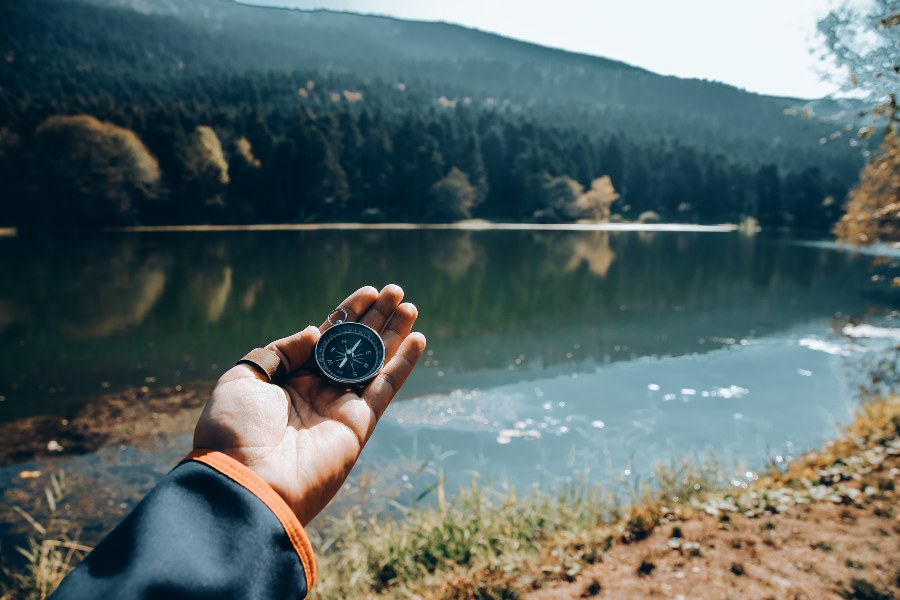
What are the golden rules of tour guiding
For many, guiding tours is an ideal way to see the world while getting paid to travel.
However, the role of a tour guide can be highly impactful, if you focus on making it fun and entertaining. Not only do you have endless opportunities to meet fascinating people from all over the globe, but you’ll never stop learning.
It makes sense that some of the best tour guides are hungry to connect with new people and enjoy reciting fun facts about what makes a place special. And whether you’re a pro or just starting out, it helps to know which tour guidelines to follow.
1. Be present, punctual and full of personality
There are few things worse than a tour guide who isn’t engaging, especially when guests arrive with high expectations. Show a vested interest in your guests during the first meeting — especially if you have a few early bird arrivals.
And since this role is equal parts education and entertainment, people with big personalities tend to do well as tour guides. This is a credit to having the ability to add a little extra zest to an experience.
Personalize the experience
The reason why people still book live tours is that in-person delivery is better than reading a guidebook. Ultimately, you have the power to transform an ordinary encounter into something more memorable. To do this, you’ll want to become a storyteller.
Do you know what’s worse than being a tour guide without a funny bone? Being hard to hear! If guests are straining to follow what you’re saying, they’ll likely tune you out.
And, even better if you can drum up fodder that travelers will not be able to find in a guidebook. Whether it’s because it’s new, insider knowledge or off-the-cuff — fun facts can send your guests into a fit of laughter and keep them engaged.
2. Know your stuff — as a tour guide rule
What do travelers often rave with tour guides? Approachability and good candour tend to show up in 5-star reviews, highlighting how a good attitude goes a long way.
You’ll need to stay up-to-date on the subject matter because guests are going to expect you to have all of the answers. With that said, you do not need to fib if you receive a curveball question. Instead, invite the audience to chime in if they have an answer or commit to finding out and responding at a later time.
Still, no matter how much you prepare, some travelers will throw some quizzical questions your way. Lean into your ability to charm and dazzle people with your local knowledge to escape these encounters unfazed.
Take time to prepare
Understandably, tour guides should have all of their ducks in a row once the tour starts. Dedicate time to doing a dry-run of your tours in advance to avoid potential hiccups that might pop up en route.
Typically, guides know where they are going, have a good sense of direction, anticipate when local restaurants and popular landmarks will be open and busy while also gauging optimal times for travel overall.
3. Engage with guests while sharing tour guidelines
Get to know your guests by striking up a conversation. There’s something known as the “third thing”. I learned about it from a brilliant architect friend who shared that wherever two people can find an item or topic they are familiar with, it helps to strike up a conversation.
In reviews, tour guides who are engaging and entertaining receive high praise. We know that becoming a 5-star tour guide takes work, but the added effort will pay off through reviews and word-of-mouth referrals.
Becoming a skilled communicator
Guests want a tour guide is confident and fun to be around. You’ll want to conduct the tour at a pace and tone that’s easy to follow. What does this sound like?
Use inclusive language to make guests feel welcome. The best way to brush up on your communication skills is to use them on a regular basis. Invite discussion and provide context for your guests to ask questions.
4. Offer helpful and timely insight
When leading a tour group, you’ll likely be commenting on things you’ve seen many times before. Imagine yourself in the shoes of a traveler.
So while you may find yourself constantly searching for new ways to talk about the same thing, it’s the first time for many — if not all — of your guests. When you share stories or recite unconventional facts, small details like these kick the experience up a notch.
Try changing up your route or focusing on different sensory receptors to offer fresh and fun ways of re-visiting the same places.
You want to create an inclusive guided experience that welcomes all types of travelers — including kids, visitors with mobility challenges and slower-paced adventurers.
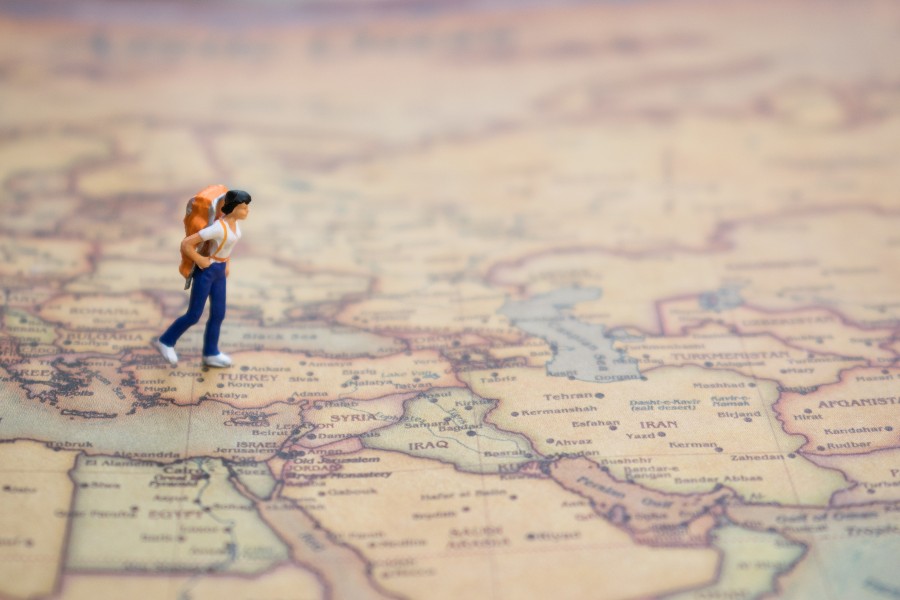
5. Address guests and answer questions
Some travelers might initially be nervous to ask you questions because they will yet to have a rapport with you.
Think about common questions guests have and aim to proactively address them with your guests. And determine which facts you believe will be most advantageous for guests to know, then share them — openly.
To combat this, position yourself as a friendly and approachable guide who’s here to do just that — guide their experience. Reiterate how the tour is theirs alone, but your role is to facilitate the best experience possible.
Speak loud and proud
Annunciate. Broadcast. Project. This is not a time to use your library voice. I mean, there’s a balance, but aim to be vocal enough that passersby find themselves eavesdropping on what you’re sharing.
An added benefit is if your tour heads somewhere quiet, guests will be tuned in to your voice and more likely to lean in if you’ve been using inflection to command their attention.
Aim to be full of charisma
While hard to define — charisma is a core element of becoming a successful tour guide.
It can be summarized as one part charm, one part knowledge and one part wit with a dash of humour for good measure.
6. Demonstrate good time-management and organizational skills
Leading by example is one of the most effective ways of gaining the trust of your audience. Sure, you’ll probably contend with a few latecomers on tours — but don’t let this derail the entire group.
For visitors arriving at a new location, they tend to have a lot of questions. On your tour, aim to proactively answer them and allow space to respond to your curious followers.
To better frame the experience, give your tour a dry-run. Without the pressure of a tour group, you can see when certain dining spots, viewpoints or transportation routes will be busy, and adjust your plans to maximize the visitor experience.
7. Infuse storytelling as part of your tour guide rules
There are plenty of advantages to becoming a skilled storyteller. First, as travelers, we thrive on stories. They help to forge new neural pathways and turn ordinary encounters into something more relatable.
And second, while it can feel intimidating to share personal anecdotes and memories, storytelling elevates the tour for your guests. Plus, you can ad lib and you’ll have guests who are none the wiser.
Peter Syme shares something called the Peak Design Rule , where he suggests tour guides identify elements throughout your tour that is most helpful, entertaining and valuable, and design your tour around that.
Travelers develop a greater capacity to recount their adventures in a favourable light with personalized tours.
8. Keep things moving
When you step into the role of tour guide, you assume the responsibility of educator and entertainer .
There will be times when you have a restless audience member or guests that tune you out. Don’t panic — instead, aim to keep a consistent pace throughout your tour.
Account for buffer time throughout your route, giving consideration to guests of all ages and mobilities. And once a tour begins — keep that trust going by letting visitors know what to expect next and offering reasons behind each stop you have planned along the route.
9. Offer breaks
If you’re leading a scenic tour, note a few stopping points en route where guests can expect to have a few minutes to snap photos and take in the view. Allow ample time for breaks while on tour. They allow guests to feel refreshed and ready for the next stop on the tour.
In addition, short pauses help guests rest up, so they have the capacity to mentally digest more information.
Bring some snacks along
Instead of waiting until the eleventh hour to lead your guests to a dining location, bring snacks and water as a safety mechanism. This is especially useful for guests traveling with young children. And while it’s not expected, it can absolutely save the day for a family who just needs a little extra support.
Food can act as a bridge between cultures. You’ve probably heard the term “hangry” or been on the receiving end of a guest who’s coping with low blood sugar.
Ultimately, you’ll have some guests who are keen to see the next vantage point and a handful of tour guests that are more inclined to take their time meandering along the route.
10. Start and end tours on time
There will always be guests who misgauge timing or location and show up late to a tour. And while travelers might visit a location for the first time and find themselves running behind, this should not take away from your fellow guests who arrived on time.
One thing you should have control over is whether your tour or activity ends on time. Instill a walking pace that accounts for little ones and more mature travelers, by building in some buffer into your schedule.
This way you can feel good about pausing to talk more in depth throughout your tour.
Research proves people tend to remember negative experiences more readily than positive encounters. It could be that guests are hardwired to weigh bad encounters differently than positive ones, but it’s also a way of keeping them safe from repeating the same mistake in the future.
Helpful tour guide rules to keep in mind
Ideally, you want to create opportunities for guests to feel included and listened to throughout your tour. If it works for your style, ask questions in advance and help them to feel involved in the experience.
But, one thing to keep in mind is that your job isn’t done when the tour ends — you’ll want to bookend the tour for guests with options for learning more along with prompts for a review.
- Guests don’t know what you know — overshare information to keep visitors in the loop
- Include a safety overview whether it’s related to gear, the location or the route
- Provide guidelines for what to expect and how they can expect to interact with you/others
- Let guests know where to find washrooms en route
- Build in buffer timing in case guests are late
As a general tour guide rule, the greater amount a guest pays, the more they will expect from the lead tour guide. You may find that tipping is activity and location-dependant.
But with guests visiting from all over the world, make sure you share how tips indicate that you’ve done a great job and while not required, are greatly appreciated.
Set a tone of curiosity, competency and confidence early on. This way, travelers arriving bright-eyed and bushy-tailed — will be ready to trust you to show them the world.
Want to become a top-notch tour guide?

Subscribe to the Checkfront Newsletter
Read new tips on how to get more bookings every month.
Related Articles

Defining your value proposition: standing out against the competition
You’re not the only one vying for the attention of your ideal customers Demand for epic experiences is growing —…
- Business Tips
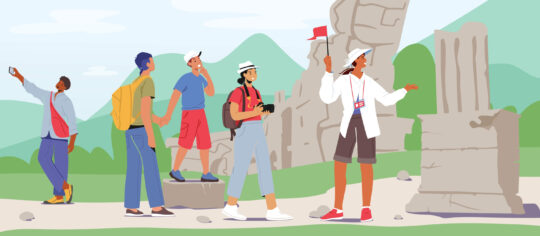
How to start a Tour Operator business in 2024: A step-by-step guide
Dreaming of running a successful tour company? Check out these strategies!
Search Blog
Subscribe to our newsletter.
Get tips and strategies to grow your business and impress your guests.
Blog Categories
- Booking Management
- Guest Experience
- Marketing Strategies
- Operator Highlights

Traveling Without a Passport

8 Reasons Why Being a Tour Guide is the Best Job

Everyone is telling you to quit your day job, live the dream, escape your office cubicle and travel the world, right? You’re sitting at your desk reading this, dreaming of open roads and stunning sights, but probably wondering ‘how the hell can anyone afford that?’
The answer, my friends, is to earn while you’re travelling.
There’s a number of different paths to earning as you travel; teaching English overseas, working remotely for your company, becoming a virtual assistant or even travel blogging – but only one option that will enrich your travel experience. Becoming a tour guide is one of the most rewarding and exhilarating ways to see the world, learn about a country’s culture and history while sharing your love of travel with people just like you.
Here’s 8 reasons why being a tour guide is the best way to travel the world and still earn a living.
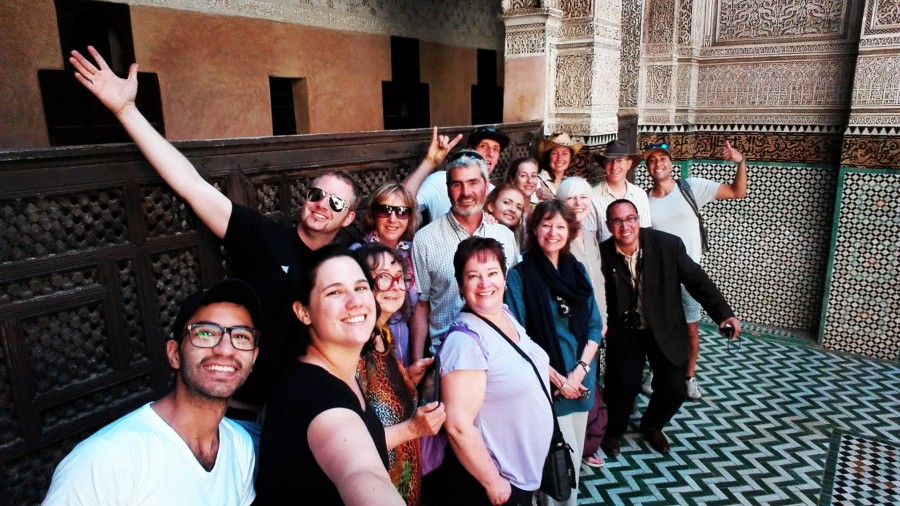
1. You’ll learn a valuable skill set for a future career
Tour Guides wear multiple ‘hats’ while running a trip. It may look like your guide is having a relaxed holiday alongside the group, but the reality is that a tour guide is a travel agent, therapist, accountant, event manager, historian, conflict resolution manager, tax and currency expert and professional public speaker. All skills which carry across impressively to any future career.
Depending on what types of tours you decide to lead, you’ll also be required to become certified in a few different core competency areas which are irreplacable skills to possess for your own travels as well.
2. You will see more countries & cities than you ever thought possible
In most cases, a tour guide does not just do the same tour loop for an entire season. A fully trained tour guide will have the opportunity to guide many different itineraries for their tour company – meaning you will visit, study and experience new destinations multiple times! Start racking up that country count, you’re about to become a professional full-time traveller.
See Also: The Truth About Being a Tour Guide: Exposed
3. You will be living the dream
You will be paid to travel. Your job, every day, will be to show first-time travellers their way around a new destination. As a tour guide, ‘work’ means being a part of someone’s happiest holiday memories. You are actually required to have fun for a living while travelling! Be warned – most of your friends back at their desk jobs will be insanely jealous of your daily updates from Monaco, Barcelona and Bali.

4. You’ll become an expert on history, art and architecture
To be a truly excellent tour guide, you need to know your stuff, which means studying up on architectural styles, historical fun facts and the best places to eat, drink and party. This isn’t your boring old history teacher studying – think researching the funniest stories of a royal family or the perfect recipe for goulash to share with your groups.
Pretty soon you will be an expert in Corinthian columns, traditional eating habits in multiple countries and the hilarious history of inter-country grudges. Your pub quiz score is going to go through the roof once you’ve become a tour guide!
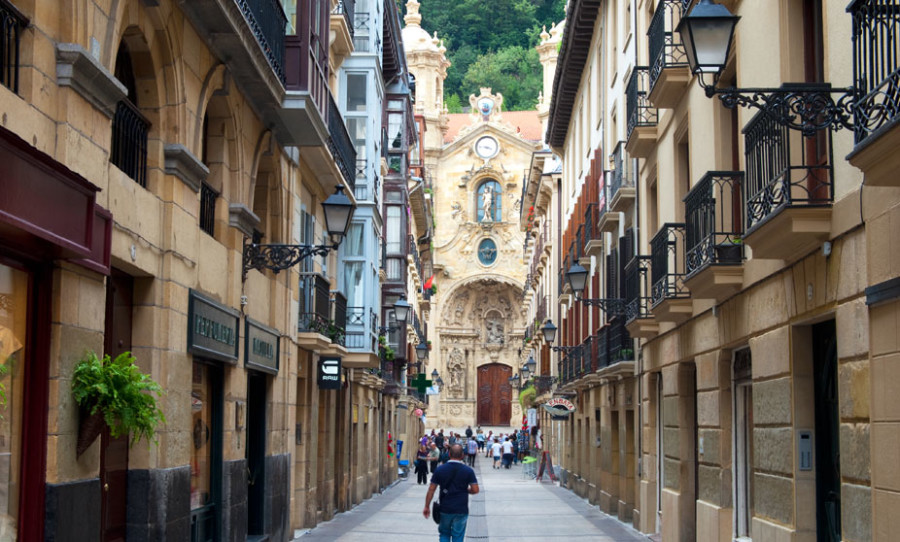
5. Your colleagues will be just like you!
Forget trying to make friends with Steve from HR who just doesn’t understand your wanderlust obsession. When you work in the travel industry, all your colleagues are as crazy about travel as you are! You will finally be surrounded by people who understand and encourage your need to see the world and experience new cultures. It will be a relief and inspiration all at once. (Sorry Steve)
See Also: The 11 Best Travel Jobs In The World
6. You can save while travelling
When you are guiding, your transport expenses, accommodation and some meals are all covered – meaning half of what you earn can be saved. With no rent, car payments or gas bills, you can accrue a decent amount in savings while you travel. This means that at the end of a season of guiding you will have some cash stashed for your own travel adventures!

7. You will become a destination expert
Knowing a destination inside out means you’ll know all the best restaurants, bars, cafes and insider tips to maximize the fun you’ll have while also getting the best possible price on meals and drinks.
8. You’ll have friends all over the world
Just like anyone who takes a tour, at the end of a trip you are best friends with the other people who shared the experience with you. That means, as a tour guide, you will have hundreds of best friends who were on your tours scattered across the world.
Next time you go backpacking in Australia, Mexico, South Africa or Canada you’ll have local friends from your tours ready to show you their home towns, and maybe even a free couch to crash on. What an excellent excuse to do even more travelling!
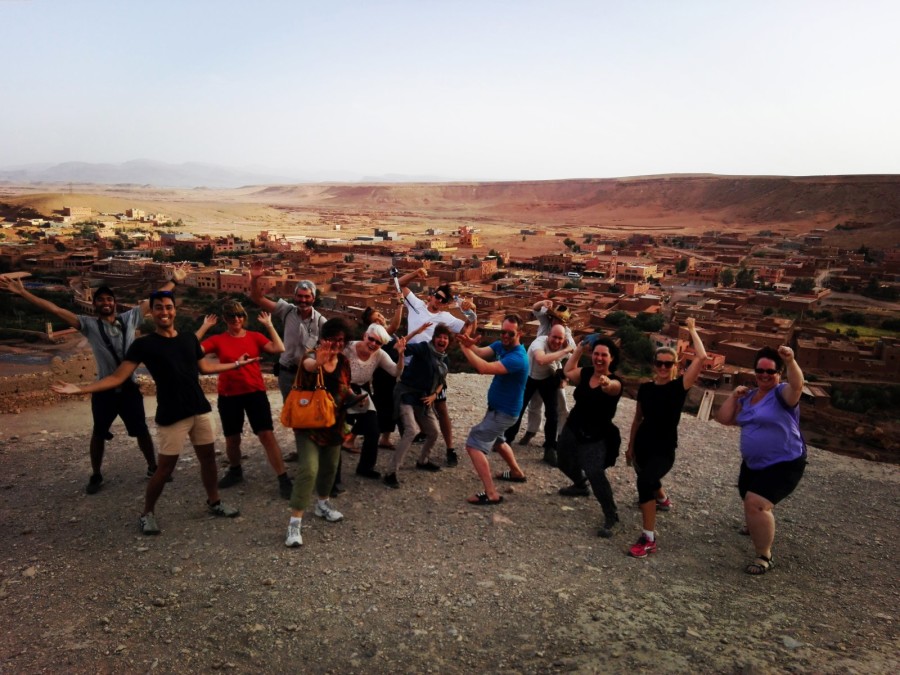
Becoming a tour guide isn’t easy, there are some intensive training and a long interview process, but if you manage to score the job, it is undoubtedly the best way to travel the world and still earn the cash you need to enjoy it!
So, are you ready to abandon the 9 to 5?
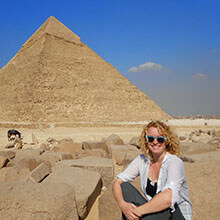
Carly Hulls
Carly Hulls writes at Austrian Adaptation about her expat life in Vienna and the places she discovers on her part-time travels. She is an Australian writer, traveller, brunch-fiend and book-nerd who can’t resist a good castle or historic monument. After 5 years travelling to over 34 countries she currently calls Vienna home, facing the daily struggle of the German language! You can follow her adventures on Facebook , Twitter and Snapchat @CarlyHulls.
Related Articles
- Central America
- Tips & Tricks
Is Costa Rica Safe to Visit Right Now?
Costa Rica, known for its stunning beaches, lush rainforests, and abundant...
- Destination Guide
- North America
- South America
Your 4 Must-Visit Inclusive Destinations
Nothing connects people from different parts of the world and disparate...
How Vacationing Can Significantly Improve Your Well-Being
Each May, we recognize Mental Health Awareness Month, aiming to remove...

How to Make the Most Out of Luscious Laos
Get unlimited access to the world's best travel stories. subscribe now., privacy overview.
How to look for the qualities of an effective tour guide operator when hiring
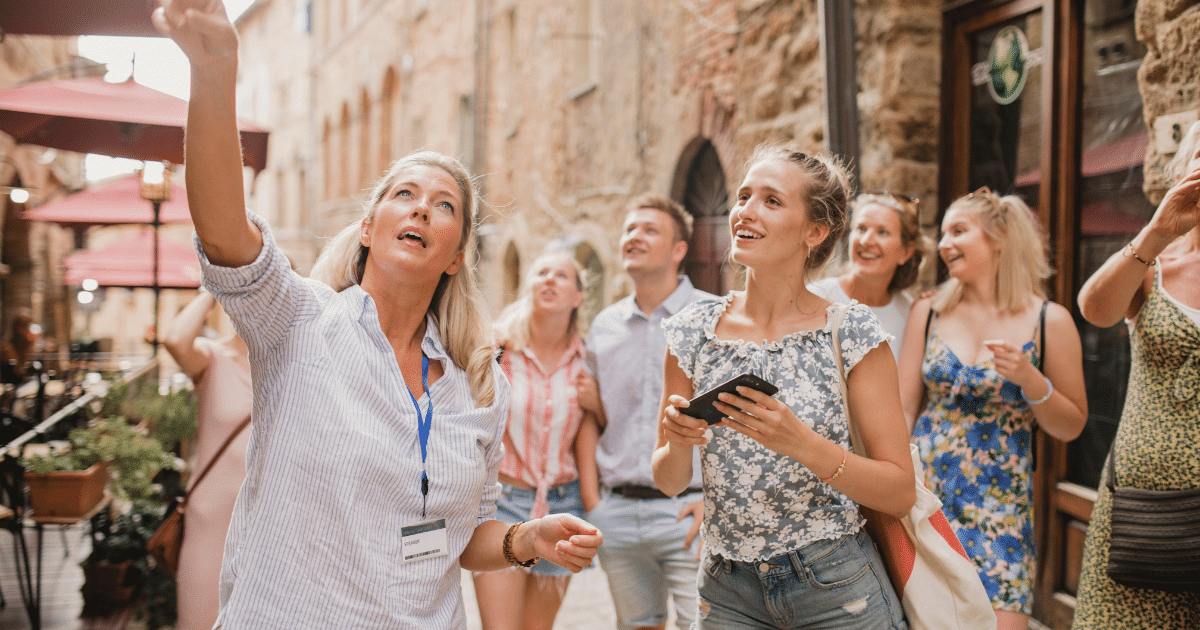
By Kevin Tjoe — 24 Jun 2018
amadeus tips tour guide tour operator
Updated June 2022 – Raise your hand if you’ve ever felt like giving up on hiring your next tour guide. When you on-board new hires, you’re hit with the realization that they’re just not a good fit, killing any sense of confidence you had about finding the best person for the job. It’s daunting enough finding a new hire – never mind going through the on-boarding process all over again when it doesn’t work out.
Well, there’s good news: selecting your next tour guide role doesn’t have to be that hard. With the right set of criteria of tour guide skills at your disposal, you could easily find the best tour guide for your business, all without the hassle that comes with having it not work out.
Wondering what personality traits do tour guides have that will reveal their future success or failure? To help you answer this, we’ve outlined 10 important qualities of a good tour guide.
With these tour guide characteristics tips, you’ll know exactly what makes a good tour guide and have the proper tools in place to hire someone who will exceed customer expectations and customer satisfaction.
1. Enthusiasm
One of the most fundamental tour guide characteristics is enthusiasm.
Customers can tell if a tour guide doesn’t want to be there. Considering that nobody wants to feel like their presence is a nuisance, it is impossible to provide customers with a fun and engaging tour if it’s obvious that their guide would prefer to be at home.
On the other hand, enthusiasm is contagious. If a customer notices that their tour guide is as excited to be there as they are, they’ll feel a lot more satisfied with their overall experience. Enthusiasm fosters an authentic connection between the tour guide and customers. It’s also the backdrop of all of the other essential characteristics of a good tour guide. An enthusiastic tour guide will be not only willing but excited to grow their skills and engage with the customers.
2. Organization and punctuality
Besides dressing themselves well, this involves setting expectations prior to the tour – informing customers of location, time, and length of tour, what they need to bring, and any rules or special considerations (if your online booking system doesn’t automate this for you). Your tour guide needs to have organisational skills to be able to run through the structure for each tour in advance.
Ultimately, one of the key characteristics of a good tour guide is effective time management skills and punctuality. They shouldn’t make customers wait for them, and they should end the tour on time.
How punctual are they when it comes to their appointments with you during the interview process? This is a good indicator of how they will be when running your tours.
The speed with which they speak and move the tour along should also be just right – it can’t be too fast or too slow. You don’t want your customers to get bored or feel rushed through certain parts of the tour.
3. Prepared for anything

A good tour guide is adept at improvising, no matter whether it’s responding to hiccups in the tour’s timing, unexpected customer questions, or responding to crises. It’s key that your tour guides are capable of efficiently detecting and responding to any crisis, no matter how big or small. They should also have a comprehensive understanding of your company’s tour guide insurance policies and how this may relate to their work.
Unexpected situations can crop up where medical assistance is needed. Every guide should know First Aid and carry the appropriate equipment. Can your candidate attend to the injured using this equipment? If not, are they willing to attend First Aid training prior to starting?
4. Can read the room
A good tour guide will take the initiative to learn about customers on the tour, then include universally relevant information to tailor the examples they use to make it more personal. They need to be aware of who they’re speaking to, the audience needs to see that your tour guide engages with all the attendees.
5. An engaging storyteller
Obviously, you don’t want people to become disinterested whilst on your tour. Your guide’s personality is a huge part of that. Can they make the tour more interactive? They should be able to invite questions and use demonstrations to help tourists to learn by themselves.
One of the most essential qualities of a good tour guide is a great customer service experience and the ability to hold good conversations. It’s also important that they have a passion for travel as this will keep the audience interested and engaged .
Make sure that they themselves are interested in the subject matter, because they need to be enthusiastic about what they’re saying.
6 . Knows their stuff

Another one of the most important characteristics of a tour guide is their ability to retain information.
Your guide must be able to recite facts from memory and be clear in delivering them. Facts have to be accurate – otherwise, they should be able to say they aren’t sure and get back to the customer asking.
Of course, you can’t expect your tour guide to know everything from day one. But hiring a tour guide who demonstrates an enthusiasm for learning and has clearly researched your tour company prior to their job interview, is key to ensuring that your staff are committed to learning and understanding the tours they provide.
7. Multilingual
While it may not be a necessity, speaking multiple languages is an excellent and particularly useful quality of a good tour guide. A multilingual tour guide will dramatically broaden your target audience and help welcome people from varying backgrounds to your tour.
A tour guide doesn’t need to be fluent in dozens of languages for their lingual skills to be handy. All tour guides should at least have a conversational grasp of commonly encountered languages. This knowledge becomes extremely useful if someone has an emergency.
8. Leadership and initiative
Since they’re managing a group of people, the ability to have a certain level of authority is crucial. Tour guides must be able to lead a group of people without being condescending, snobby, or aggressive. If something unexpected happens on the tour, a good tour guide will be able to take charge in an assertive manner to ensure that all customers receive the right directions.
9. A good sense of humor

Whilst they don’t have to be total comedians, tour guides need to be quick witted so they can throw in friendly jokes or light banter with the customers. Again, it’s not a stand-up routine, so they should also know when to be quiet. You can gauge this aspect of their personality when they interview for the job.
10. Willingness to learn
A key part of your tour should be collecting feedback and using it to make it better. Your tour guides should be open to change based on customer criticism – without taking it too personally.
Of course, the ideal tour guide will look differently for each tour operator company as some traits are necessary for certain activities but not others. However, there are certain qualities of a good tour guide that transcend time and place: enthusiasm, a willingness to learn, leadership skills, and punctuality.
Now that you’ve found what makes a good tour guide, it’s time to ensure that your newly hired tour guides are given the right tools they need to succeed.
Rezdy’s all-in-one online booking software simplifies the management of your tour company so you can ensure that your customers receive a satisfying experience. Curious to see how Rezdy can help your tour guides succeeds? Start a FREE 21-day trial or book a demo so you can experience first-hand the benefits of automated activity booking websites.
If you enjoyed this article then make sure to follow the Rezdy blog . There are a lot of marketing tools and tour operator tips designed with businesses like yours in mind.
Start your free trial today
Enjoy 21 days to take a look around and see if we are a good fit for your business.
No obligations, no catches, no limits, nada
Effortless booking
Maximize online conversions with the most intuitive checkout online.
Expand revenue with our powerful Automated E-commerce tools.
Upgrade your website to industry’s best. Fresh websites. Fresh revenue.
Amplify visibility and expand earnings with integrated OTAs and local partners.
Streamline check-ins, limit risk, and amplify customer data with built-in digital waivers.
Transform data into insights. X-ray reporting gives you customer and business intelligence.
Manage high-volume walk-up customers effortlessly with POS, ticketing, and gated entry.
Automate management of staff schedules, assignments, and staff communications
Control your business precisely the way you want with endless yet easy configurability.
Allocate equipment used in various products. Prevent overbookings and maximize profits.
Grow with Xola in our constantly expanding universe of integrations and apps.
Harness customer data to drive marketing campaigns and generate repeat business.
Transform your guests into passionate brand advocates. Perfect your products & services.
Manage your business with the most powerful mobile suite in the industry.
Perfect the guest experience by giving your staff the industry’s most intuitive software.
Efficiently manage guest flow, minimize wait times, and ensure maximum satisfaction.
Ticketing & Entry
Revolutionize your guest experience: Effortless check-ins, interactive displays, secure payments.
Boost revenue with automated rave reviews, actionable insights, and loyal customer engagement.
Efficient ticketing, digital waivers, and fast check-ins enhance on-site operations and guest satisfaction.
Explore Xola Universe: 80+ apps, limitless integrations, endless growth opportunities.
Simplify check-in and boost your marketing efforts with our integrated automated digital waivers.
With SOC 2 Type II and CCPA compliance Xola exceeds industry security standards and insures your data protection.
Access real-time insights for business growth with our powerful reporting.
Remarkable and hassle-free guest experiences with waitlist and virtual queuing.

AI dynamic pricing use cases for tours and attractions
- Xola University
- Business Operations
13 Tips To Be a Better Tour Guide
Being a tour guide is a fun, exciting, and rewarding job. You spend your days sharing your knowledge and chatting with guests.
While you will improve your skills naturally with every tour you provide, there are some things you can to more proactive build your skills.
In this post, we’re sharing 13 tips to help you be a better tour guide, including:
- What is a tour guide?
- What are the different types of tour guides?
What Are the Key Job Responsibilities for a Tour Guide?
13 top tips to be a better tour guide, what is a tour guide .
A tour guide is a professional who leads groups or individuals through tourist attractions, providing them with information, stories, and insights about the location, its history, culture, and significance.
Tour guides are responsible for ensuring that the tour is informative, engaging, and enjoyable for participants.
They often have expertise in specific areas such as historical sites, natural landmarks, museums, or cultural experiences, and they use this knowledge to enhance the visitors’ understanding and appreciation of the places they visit.
Additionally, tour guides handle logistical aspects of the tour, such as managing schedules, coordinating with other service providers, and addressing any questions or concerns from the participants.
What are the different types of tour guides?
Here are some of the different types of public and private tour guides across the tourism industry.
- Historical Tour Guides – Specialize in guiding tourists through historical sites, monuments, and museums. They provide detailed information about the history, architecture, and significance of the locations.
- Adventure Tour Guides – Lead tourists on adventurous activities such as hiking, rafting, or wildlife safaris. They are knowledgeable about outdoor survival skills, safety protocols, and the natural environment.
- Cultural Tour Guides – Focus on the cultural aspects of a location, including traditions, customs, festivals, and local lifestyles. They often guide tourists through cultural landmarks, markets, and festivals.
- City Tour Guides – Conduct tours within a specific city, highlighting its landmarks, neighborhoods, historical sites, and popular attractions. They provide insights into the city’s history, architecture, and modern-day life.
- Museum Guides – Work within museums to provide in-depth information about the exhibits, artifacts, and artworks. They often conduct guided tours, educational programs, and workshops.
- Eco Tour Guides – Specialize in ecotourism and sustainable travel. They guide tourists through natural environments, focusing on conservation, wildlife, and the ecosystem while promoting responsible travel practices.
- Special Interest Guides – Cater to niche interests such as food tours, wine tours, ghost tours, or photography tours. They have specialized knowledge in their area of interest and provide unique, themed experiences.
- Tour Managers: – Oversee the entire tour experience, often for longer trips or multiple destinations. They handle logistics, coordinate with local guides, manage schedules, and ensure the overall success of the tour.
- Driver Guides – Combine the roles of driver and guide, offering guided tours while driving tourists to different locations. This is common in regions where driving between sites is necessary.
Tour guides have to manage various responsibilities throughout their day to provide memorable experiences for guests. Successful tour guides enjoy working with people, are excellent storytellers, and solve problems independently.
Tour guides have to manage multiple responsibilities throughout their day, including:
- Greeting visitors and interacting with them before the start of the tour
- Letting participants know about the tour’s itinerary and rules
- Planning and managing the itinerary
- Learning and memorizing interesting details and facts and turning them into stories
- Having a strong understanding of your tour’s layout and location
- Setting up and maintain equipment before the start of a tour if necessary
- Being prepared in case of an emergency
- Ensuring guests remain safe and follow all proper protocols
Successful tour guides continuously build and improve their skills throughout their careers to provide memorable and engaging experiences. Learning new information and skills also helps keep the tours and experiences you deliver engaging and fresh for you. Your enthusiasm and enjoyment will show to guests and help capture their attention.
So whether you’re just starting out as a tour guide or have been working in the field for a while, here are 13 ways you can continue to build your skills as a tour guide.
1. Skip lengthy introductions or setups at the beginning of the tour
Introductions to the tour and a review of rules can help provide structure and context for your guests. That said, you don’t want the introduction information to go on so long that you lose your guests’ attention.
When planning what to say at the start of the tour, look for ways to provide the necessary information while keeping guests engaged and maintaining their enthusiasm for the tour or activity.
Depending on the type of tour you provide, you may have to first cover safety measures before moving visitors to a location, so use your judgment. If you’re unsure whether your introduction is too long, consider asking a fellow guide to listen to your opening. They can provide you with feedback on what it’s like from a visitor’s perspective.
2. Bring information to life through a story
People love stories. Your guests are more likely to remember, understand, and appreciate the information you share when you can tell it through a story. The stories can be historical or contemporary. This strategy increases the likelihood that guests will ask questions and engage with you, making the experience more fun for everyone.
You don’t have to tell everything as a story, but sprinkle them in throughout the tour to maintain everyone’s attention. If you feel uncomfortable telling stories, you can build your storytelling skills. You can listen to audiobooks or podcasts of famous or popular storytellers or take a public speaking course.
3. Face guests when sharing information
When you’re discussing something, it’s natural to point and look at the object. As a tour guide, you’ll engage your audience better by facing them. This strategy allows them to see your gestures and hear you better.
You can teach yourself to turn toward the group. To help learn this habit, consider identifying one person in the group that you will look at when you first start talking. To ensure the whole group feels engaged, be sure to move your gaze to other visitors soon after you start talking.
This strategy provides you with a consistent cue to help you develop the habit of turning towards the group when you start talking. After a while, you’ll naturally turn toward the group when you’re giving your tours.
4. You don’t have to know everything
As a tour guide, you purposefully try to learn everything you can about the locations on your tour. That said, you don’t have to know everything. You may have a guest who has unique expertise or insider’s experience. Let them share with the group. Everyone will have a richer experience, and you can potentially incorporate this information into future tours.
5. Avoid exaggerating information
You want your tours exciting and engaging, but you also want to be known as a credible and knowledgeable expert. Therefore, resist the urge to exaggerate information. Your guests won’t trust what you say or recommend the tour if they discover you’ve provided inaccurate details or facts.
Sometimes exaggeration can sneak in when telling stories, so make sure your stories are based on facts and verifiable information.
6. Provide anecdotes when possible
Telling personal anecdotes can provide a special touch and experience for your guests. These can make the tour more engaging and help you connect with visitors.
While you can plan ahead of time what anecdotes you will tell, being able to spontaneously provide anecdotes and insights tailored to the group can help enhance the overall experience. You can take a local improv class to help practice this skill.
7. Be punctual (and ideally early)
When people are on vacation, they often have carefully orchestrated plans. If one part starts late or goes too long, they may miss another planned opportunity. Your guests will appreciate you starting and ending your tours on time. Being punctual will help build their confidence in you as a professional and expert.
When it’s possible, try to arrive early for tours. This strategy will give you time to get to know participants before the tour starts. This strategy helps you build rapport and start learning what types of information they want so you can tailor the experience to their needs. You’ll also be able to answer any questions people have about the area before the tour begins.
8. Be attentive to guests’ needs
Being attentive to your guests’ needs is about more than just guiding them from one point to another. It’s about creating a comfortable and enjoyable experience. For instance, if you notice guests looking tired, suggest a short break or a slower pace. If a particular topic sparks interest, consider diving deeper into that subject. This adaptability shows that you’re not just following a script but are genuinely committed to providing a fulfilling experience.
Moreover, being attentive means being prepared to answer questions or provide solutions to unexpected issues. Whether it’s a question about local dining options or needing assistance with accessibility, your readiness to help can significantly enhance guest experience.
9. Be passionate
Your enthusiasm and passion for the subject matter are infectious and can enhance the tour experience. When you speak about the history, culture, or landmarks with genuine excitement, it engages your guests and makes the information more compelling. This enthusiasm can transform an effective tour guide into a truly 5-star tour guide.
However, it’s important to balance your enthusiasm with the ability to read your audience. Some guests may prefer a more subdued approach, while others might enjoy high energy. Tailoring your enthusiasm to suit the group’s dynamics is key.
10. Use humor
A well-timed joke or a witty remark can lighten the mood and enhance the overall experience. It helps in breaking the ice and making even the most difficult customers feel more comfortable. However, it’s crucial to exercise guest discretion. Tailor your humor to the audience and avoid jokes that could be misunderstood or that touch on sensitive topics. The goal is to add a light-hearted touch to your tour, not to make anyone uncomfortable.
11. Offer personal recommendations
Take a nod from hotel concierges by offering personal recommendations towards the end of the tour. This adds a special touch to the experience. Sharing your favorite local spots, eateries, or hidden gems provide guests with insider knowledge they might not find in guidebooks. These recommendations should be tailored to the interests of the group and can range from the best places to catch a sunset, to a local café known for its specialty dishes.
12. Invite feedback and follow-up
Inviting feedback at the end of the tour is a great way to show that you value your guests’ opinions and are committed to improving your service. Encourage them to share their thoughts and suggestions. This feedback can be invaluable in refining your tours and making them more enjoyable for future guests.
Additionally, offering to stay in touch for any further questions or recommendations can leave a positive lasting impression. It shows that you’re not just interested in providing a service but are genuinely invested in their experience. This openness to feedback and follow-up can lead to more positive reviews and recommendations, which are essential for a successful tour guiding career.
13. End with a memorable conclusion
Summarize the key points of the tour and leave your guests with a final thought, story, or anecdote that encapsulates the essence of the experience. This could be a poignant story, a surprising fact, or a humorous observation. A strong conclusion ties the entire tour together and gives your guests something to remember and talk about long after the tour has ended.
Moreover, a memorable conclusion is an opportunity to not only thank your guests, but it gives you an easy opportunity to ask for a review. This can not only increase the chance that you’ll get a nice tip but you can also wind up with more customers from the 5-star reviews they leave.
In sum, being a tour guide is a fun and interesting job that allows you to interact with various people. Like many professions, the more you practice and work on building your skills, the better everyone’s experience, including yourself.
Incorporating these strategies and tips can help you elevate your tour from good to great, making your visitors more likely to tell others about your tours.
Pro Tip: Not a customer but interested in checking out Xola? Explore all of the features including guide management.
Writer Jessica Malnik
Related Articles

Bookings vs. recognized revenue – what’s the difference
While your booking volume is an important metric to watch, it’s not the only factor that ensures your company’s financial

How to calculate capacity utilization
Is your attraction operating at its full design capacity potential? Key performance indicators, like your capacity utilization metric can help
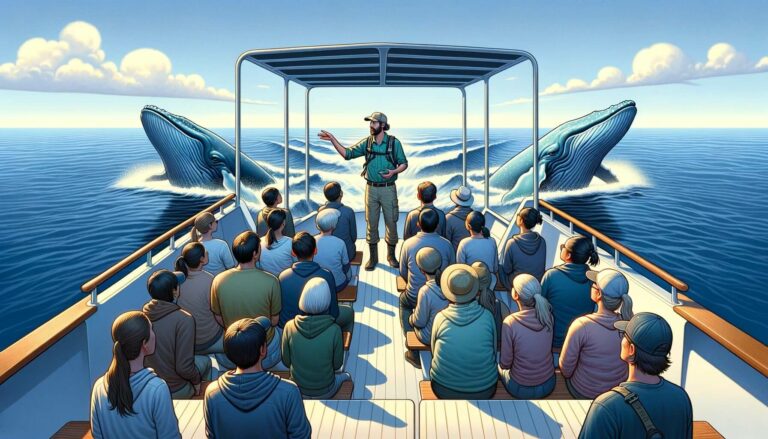
7 Skills That All Great Tour Guides Possess
When your business is growing, the thought of hiring, vetting, and managing tour guides can be daunting. In an earlier
Get the latest news and resources.
For tours and attractions delivered straight to your inbox each week.
Transform your business now.


- Tourism Best Practices
How To Be A Better Tour Guide

As a tour guide, you are a part of the hospitality and customer service industry and we know it isn’t always easy. We’ve all heard the horror stories; demanding clients, late arrivals, unsatisfied customers, and troublemakers.
We wanted to help you out, so we’ve come up with a useful guide that will help you deal with “eccentric” customers and, overall, be a successful tour guide.
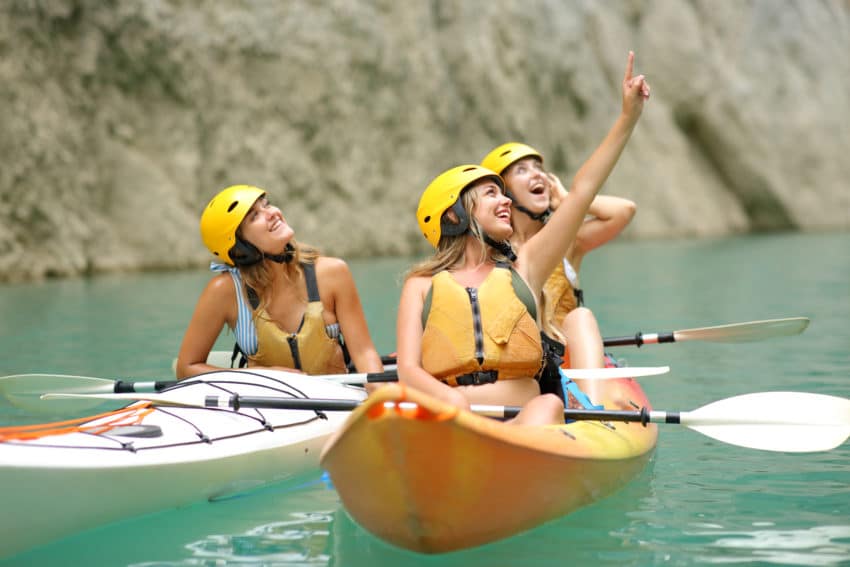
Don’t Just Be a Good Tour Guide, Be a Great Tour Guide
There are thousands of good tour guides out there, but don’t just be ordinary, be extraordinary! Learn what the difference is between a good tour guide and great tour guide.
1. Introduction
A Good Tour Guide: Introduces themselves, welcomes you to the tour, and gives a brief breakdown of the schedule.
A Great Tour Guide: Gets to know their tour group.
Action Step: Ask where your group is from, why they’re visiting, and what their interests are.
Get the group to get to know each other
Action Step: Play a game of Elimination Rock, Paper, Scissors, where you get everyone to pick someone to play against. The loser stops playing while the winner continues to play with another winner until their are only two people left. This is a great way to break the ice in a short time, without too much small talk. Maybe even think of a small prize to award the winner.
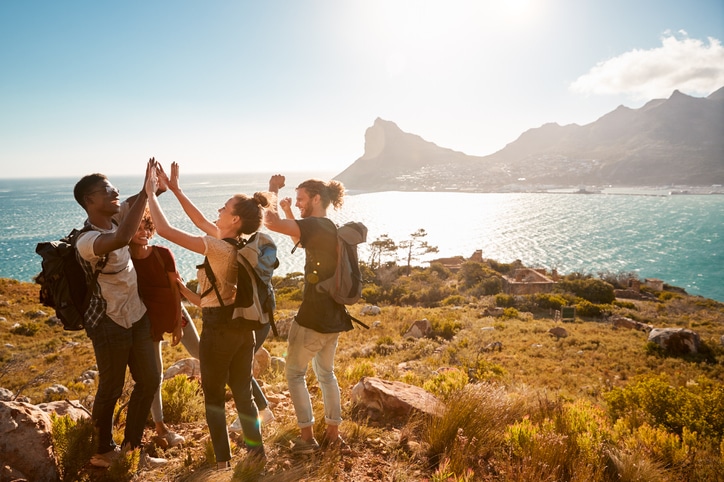
2. Sight-Seeing
A Good Tour Guide: Shows his/her group all the sights on the tour.
A Great Tour Guide: Maximizes enjoyment on the tour
Action Step: Do some research to map out when the best sights will be the least crowded.
Listens to what his/her group wants
Action Step: At the request of one of your group members, show any additional sights that they want to see.
Recommend the best places to eat, shop, and buy souvenirs
Action Step: Recommend the best places to eat shop and buy souvenirs. Don’t base your recommendation off of a commission you may receive from a store. Travellers have a good sense for when they are being pushed into a retail situation that benefits the guide. Emphasize quality and experience.
3. Time Management
A Good Tour Guide: Will make sure that you stick to the schedule and see all the sights on time.
A Great Tour Guide: Is Flexible
Action Step: Be aware of the start and end time of the tour but if your customers are enjoying a particular sight, let them stay a while.
Doesn’t Rush
Action Step: Don’t rush your customers, remind yourself that you are on their time.
4. Commentary
A Good Tour Guide: Gives a basic historical and cultural background of the sights.
A Great Tour Guide: Is a story teller
Action Step: Be passionate about your story telling – Use arm gestures, a high speaking volume, and facial expressions.
Watch this video on how to be a great story teller
Integrates personal anecdotes
Action Step: Tell your group your personal thoughts on the good, the bad, and the ugly of your city – trust me, they’ll laugh!
5. Local Knowledge
A Good Tour Guide: Is familiar with the city and/or country of the tour.
A Great Tour Guide: Is a traveller
Action Step: Include stories from your own traveling adventures.
Really understands the city and/or country they are guiding
Action Step: Highlight the uniqueness of the city and/or country compared to other cities and countries.
6.Conclusion
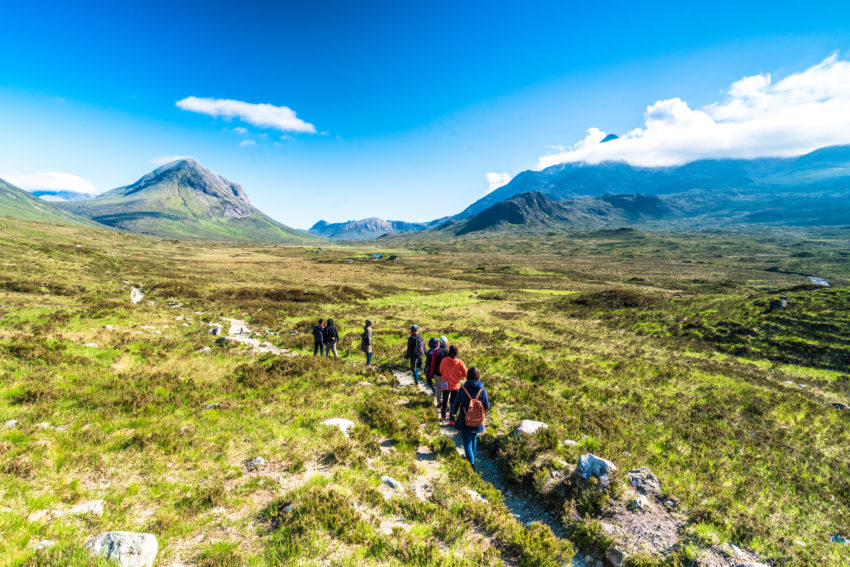
A Good Tour Guide: Says his/her closing remarks and thanks you for coming.
A Great Tour Guide: Cares about the rest of his/her group’s trip
Action Step: Reccomend other sights, restaurants, etc. that you didn’t get to show them on the tour.
So there you have it- the difference between a good tour guide and a great tour guide.
Another factor of how to be a great tour guide is how you deal with difficult customers.
How to deal with customer complaints and late guests – two very common occurrences on tours.
How To Deal With Complaints
Working as a tour guide in the hospitality industry means that the customer is always right, even if they’re wrong.
Learn how to deal with customer complaints as democratically as possible with these tips and tricks.
Run a Great Tour
Instead of putting out fires, prevent them! Right from the start, be a professional, organized, and fair tour guide. Don’t give your customers anything to complain about!
Be Clear About Your Complaint Policy
During the introduction of your tour, be clear about your complaint policy.
- That you will do your best to make everyone on the tour happy.
- That you are willing to hear what everyone has to say.
- That you will respond as quickly and fairly as possible to the complaint.
- The procedure the guest has to follow to file a complaint.
- How you and your team will respond to the complaint.

Be Professional
Since it can be difficult to deal with angry guests, train your staff ahead of time so that they are familiar with the procedure on how to deal with complaints.
Here are a few good rules of thumb to follow:
- Respond quickly: The guest will want to feel like you heard them and that you care about their complaint. Dealing with the complaint quickly also means the customer is less likely to post their complaint on a site like TripAdvisor.
- Show your guest that you are listening: Use your body language to show the guest that you are actively listening to their complaint – Nod your head, keep eye contact, and verbalize that you understand.
- Thank your guest: Thank your tour guests for raising their concerns.
- Be patient, calm and empathetic: The guest may be acting unreasonable, but that doesn’t mean that you should too – If you remain patient, calm and empathetic then they will likely mimic your approach.
- Verbalize how you will manage the complaint: Letting the guest know what your plan is to manage the complaint will make them feel satisfied. Breakdown what happens next and when.
- Involve your guest in the solution: Ask them if there is anything that they would like you to do to solve the problem.
- Update your guest on the status of their complaint: Let your guest know that you haven’t forgotten about them and where their complaint is in the filing process.
Send a follow-up email asking your guest how they are doing – If necessary, send a discount or promotional offer.
Remember that your reputation is on the line and unhappy customers will likely share their tour experience – So deal with complaints as best as you can!
Another difficult situation that can arise when running tours is late guests.
How To Deal With Late Guests
Organizing a large group of customers comes with a set of challenges – late guests being one of them.
Learn how to deal with late guests with these 5 tips and tricks!
Set Precedent
Set a time that the tour starts and make sure the tour actually starts at that time – As the tour guide you should be there about 15 minutes early to prepare anyways.
Being at the start location on time and starting on time shows your guests that you are taking your job and the tour seriously.

Set Reminders
Communicate as much as possible with your guests – Along with the tour’s itinerary, send text or email reminders 3-4 hours before the tour reminding your guests of the time and the location.
Be Strategic
Choose a strategic location for the start of the tour – Choosing a place that is difficult to find will increase the likelihood of late guests.
Send a map with a clearly marked route to the start location.
Be Prepared
Prepare a system for your late guests – Let them know where they can reach you or the tour office to find out your next location
Or send them the times and locations of all the spots on the tour so that they can meet you there.
If there is a crucial time and place that all the guests must be – for example, if the van leaves at 8:30 sharp, be clear and emphasize this point!
Remind them a few times that if they aren’t there on time, they will be left behind, but in the nicest way possible, of course.
Check out these 5 resources that can help you be an even better tour guide .

Written By | Rezgo
Rezgo helps experience providers grow their businesses with flexible online booking tools and personalized support. Focus on what you love and let us take care of the rest.
Previous Article Social Media Cheat Sheet
Next Article 11 Extra Tips to Be a Better Guide
Related Posts

Articles , Increase Online Bookings , Tourism Trends
17 innovative tourism business ideas and trends for 2024.

Articles , Increase Online Bookings , Tourism Best Practices
Advantages and disadvantages of online travel agencies (otas).

Articles , Increase Online Bookings , Marketing Strategies
Your marketing mix: the 7 ps of travel and tourism marketing, search the blog.
- All Categories
Most Popular Articles
- 17 Innovative Tourism Business Ideas and Trends for 2024 85 views
- Your Marketing Mix: the 7 Ps of Travel and Tourism Marketing 48 views
- Advantages and Disadvantages of Online Travel Agencies (OTAs) 31 views
- How to Create and Promote Amazing Tour Packages 12 views
- How to Create a Business Plan for Your Tour or Travel Company 10 views
I have read and agree to the Rezgo Privacy Policy
GET STARTED
Sign-up for a free demo.
Lorem ipsum dolor sit amet, consectetur adipiscing elit, sed do eiusmo tempor incididunt ut labore et dolore magna aliqua.
Schedule A Demo

When To Take a Guided Tour (and When Not To)

As a tour guide, I will be the first to admit that there’s a lot of stereotypes about guided tours that are true. Good and bad. They definitely aren’t for everyone.
But there are plenty of reasons why taking a tour is the perfect way to travel. It all depends on what you prefer and how you like to travel. Since I’ve been a tour guide for the past four years (at one of the best tour companies ), I’m here to break it down for you. In this post, I’ll cover pros and cons of guided tours, including when you should take a tour and those times when it’s better to go it alone and skip the tour.
When to take a guided tour
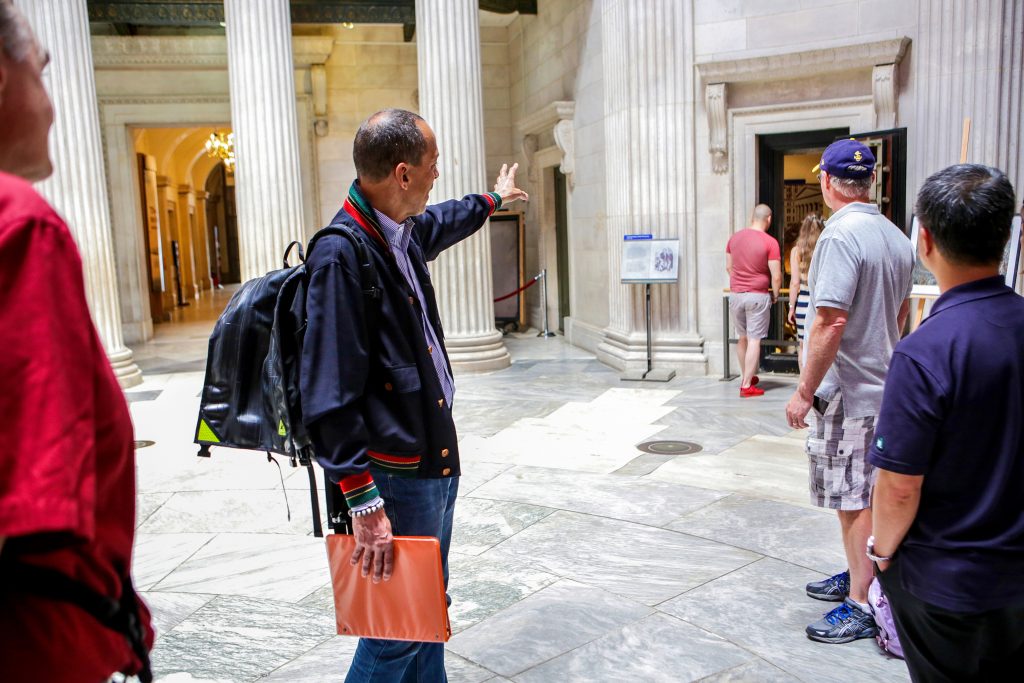
It’s your first time in a new place
Traveling to a new city for the first time can be daunting. You’re not used to the people, the streets, or the best way to get around. If you’re a solo traveler, you might also be concerned about safety in a big city like LA or Paris .
Joining a tour takes care of a lot of these concerns. A reputable tour company would never bring you somewhere that isn’t safe, and a well-trained guide will have lots of expert (and free!) advice about how to get around the city. Plus, you can use the time on the tour to learn more about where to go, the best way to travel, and places you should avoid.

Statue of Liberty and Ellis Island Guided Tour
Guide tip: If you’ll be in a city for a few days and plan to do a guided tour, schedule it for early in your trip. We hear it from our guests time and again — taking one of our tours on the first or second day makes the rest of their trip better because they get an intro to the destination.
You like to learn as much as you can
It’s one thing to see a beautiful building. It’s a whole other thing to see the building while learning about its history and all the people whose lives are connected to it. Understanding the places and people of the city you’re visiting deepens your experience while traveling. You’ll appreciate what you’re seeing even more.
At the end of the day, my goal as a guide is that everyone will learn at least one fact that they find interesting enough to share with a friend or family member. I feel good knowing I’ve given them a fun memory and a good story. Plus, it’s so much better to hear surprising true tales from a guide than to read dry facts online.
You’re looking for local recommendations
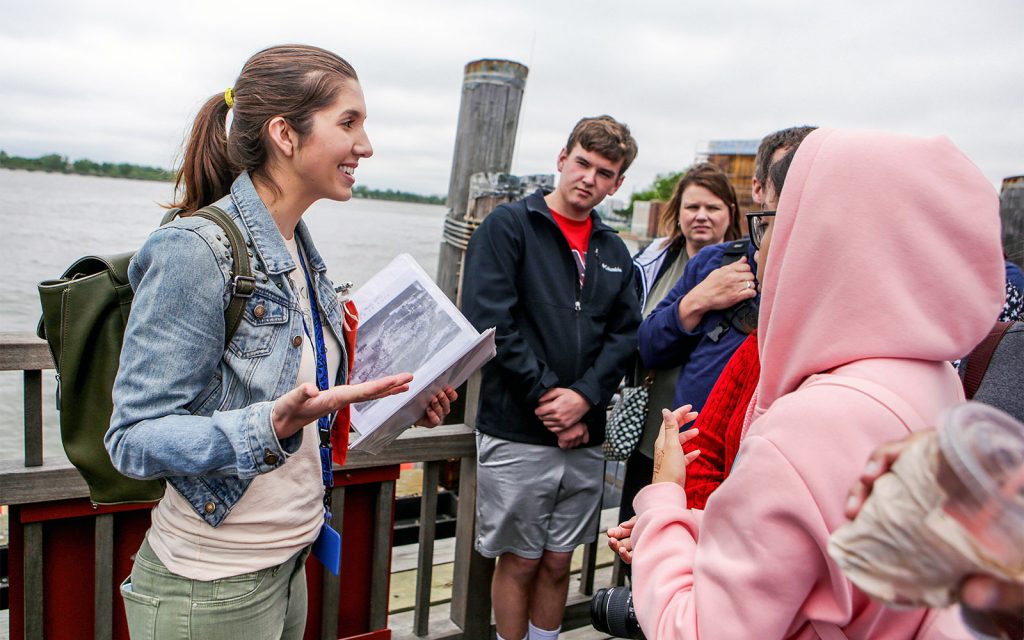
Like discovering hidden gems or the popular joints locals like to hang out? Nothing beats getting in-person advice from your local tour guide. You can ask them for recommendations on what to do and see, customized for you or your group.
I always tell my guests — take advantage of our time together! We usually have at least a couple of hours with each other, and my job is to serve you in any way I can. Even if I don’t have personal experience with a particular place, chances are I’ve heard about it or know someone who does. There’s a lot you can learn from just talking to a tour guide and asking them about what they enjoy doing in the city.
Timing is limited
Let’s just say there’s a reason we offer an express tour for places like the Statue of Liberty and the Vatican .
Any time you take a trip, it seems impossible to be able to do everything you want, especially in a huge city.
A tour gives you the opportunity to see a lot in a little bit of time. Most tours try to cover as much ground as possible, so it’s a great way to travel if you’re looking for the best and most convenient way to hit the really important stuff.
Guide tip: If you’re looking for tours that cover the best things to see in the city, look for tours billed as “highlights” or “in a day.” We offer these in most of our cities:
- New York in a Day Walking Tour
- Paris in a Day Guided Tour
- Dallas Highlights Tour
- San Francisco in a Day Walking Tour
- Private LA Highlights Tour
Highlights tours may be touristy, but they’re intensely practical — and loads of fun.
Plus, tours that cover crowded places like the Louvre and the Colosseum tend to have perks like skip-the-line tickets or quick entry. No one wants to spend their vacation stuck in a line for hours.
You want to let someone else take the reins for a bit
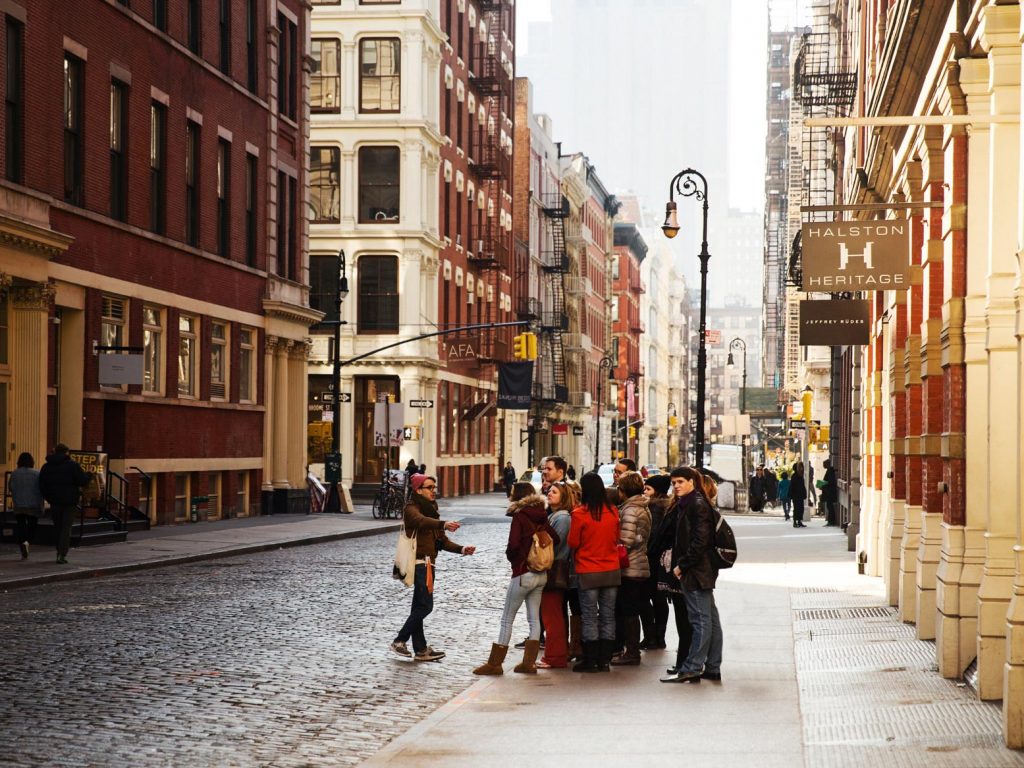
Traveling can be really stressful, and not everyone enjoys planning it. The beauty of a tour is that once you’ve picked it, it’s now up to the guide to entertain you and organize your next few hours.
If something goes wrong, it’s up to the guide to handle it. If you need to get from point A to B, the guide has to get you there.
As a traveler, it can be a huge relief to just sit back and let someone else take over your vacation for a while.
When NOT to take a guided tour
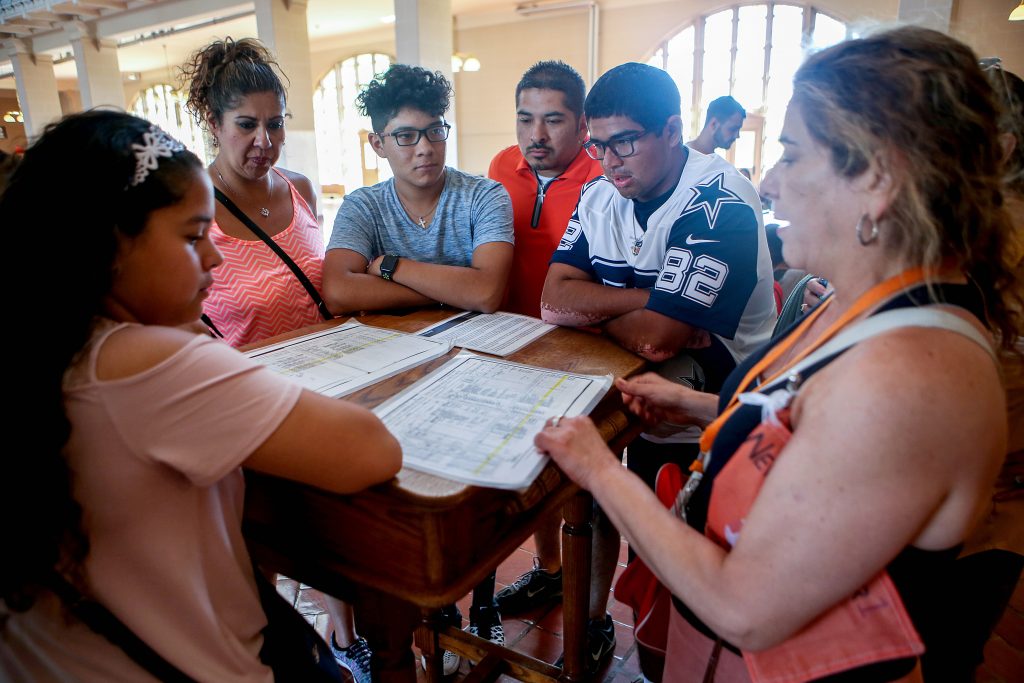
You want to be spontaneous
Since a tour has planned stops and talking points, there’s less room for flexibility.
If you’re someone who likes to stumble upon something special or just wander around without any real goal in mind, you probably wouldn’t enjoy the structure that a tour provides.
While a good tour will certainly have surprises and you’ll discover things you didn’t know before, there’s not too much spontaneity involved since you’ll have a general idea of where you’re going and what you’ll be seeing.

Eiffel Tower Guided Climb
You don’t want to commit to a time and place.
If you’re that spontaneous type mentioned above, you might prefer not to plan any part of your vacation ahead of time. But with most guided tours, that tends to be something you need to do.
You don’t necessarily need to plan out all the details, but you will need to commit to getting to the meeting point on a specific day on time. (Or 15 minutes early, which is what we recommend for our guests. If you’re late to the check-in point, you might not be able to catch up with your tour group!)
Now, not every tour company will turn you away if you try to book last-minute, but it’s a lot more likely that the award-winning tour you really wanted is filled up. So touring takes a little planning ahead.
You have somewhere you need to be
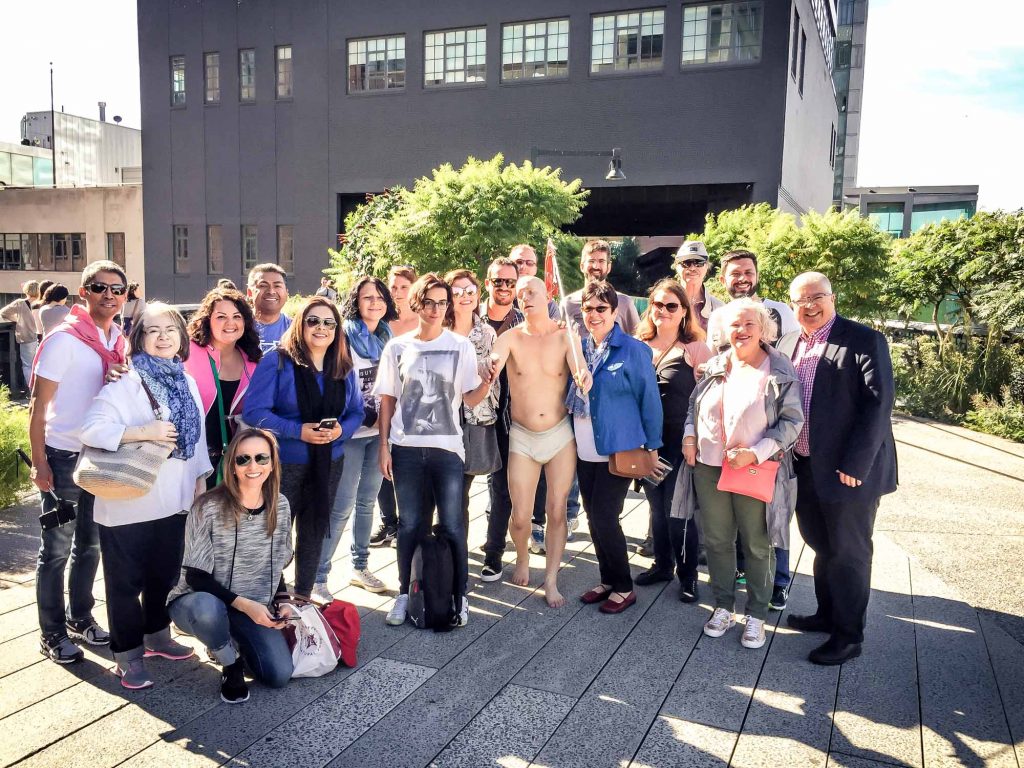
You can’t always squeeze a tour into a busy schedule. And it’s especially a bad idea if you have a flight (or train or ferry) to catch right after the tour.
For example, if your plane leaves at 4 p.m., it’s best not to start a two-hour tour at noon. Of course, you can always leave early from the tour, but then you’ll end up missing things and not getting the full experience you paid for.
You’re also likely to be stressed about making sure you get to the next place on time, and you might have to worry about bringing luggage with you — and quite a few big attractions don’t allow people to bring luggage inside. Plus, who wants to be toting extra stuff around on a walking tour?
You’re a budget traveler
Pretty much everyone traveling is on a budget of some sort, and there’s usually a tour that can fit with what you’re looking for. We’ve done tours from $25 all the way up to customized private tours for groups that reach into the hundreds.
But if your main goal is to travel as cheaply as possible, tours probably aren’t a great fit.
Guide tip: Keep in mind, sometimes booking a tour will actually save you money. If you’re looking to visit a ticketed attraction anyway, many companies will include the ticket with your tour at a discounted rate.
You have limited mobility or health concerns
This definitely doesn’t apply to every tour, but it’s relevant for walking tours, one of our favorite offerings here at ExperienceFirst. If the tour involves a lot of steps (like the Catacombs ), hiking (like Griffith Park ), or another physical activity, such as biking, it might not be something you’re up for. And that’s absolutely fine!
If you’re interested in joining a tour but are concerned about mobility, consider booking a private tour . That way, the guide can tailor the tour to your needs. No rushing, and a schedule designed just for you.
Guide tip: Another thing to love about private tours? All the photos of just your group! Plus, you can ask as many questions as you want without worrying about sharing the guide’s time with others. The guide is there just for you.
You don’t like sticking to someone else’s schedule
When you’re in a group, you’re usually limited to the stops that have been designated by the tour guide. You can’t stay somewhere longer without ditching the tour completely. You most likely won’t be able to see anything that’s not on the itinerary. This might not bother you, but some people might not like leaving a place to keep up with the group.
I often tell guests to revisit a place they enjoyed on the tour so they can experience it more in-depth on their own. But if you want to be able to decide how long you spend in place, from five minutes to five hours, then a guided tour might not be for you.
To take a guided tour or not? The decision is yours
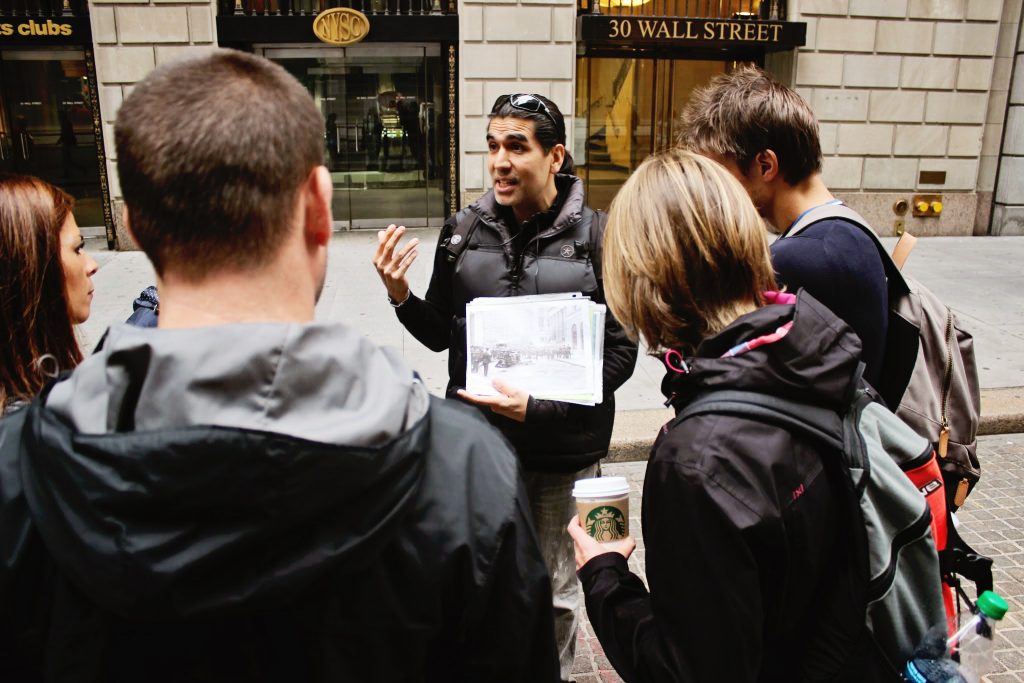
Hopefully, you now have an idea of if booking a tour is right for you. Clearly, there’s a lot to consider, and at the end of the day, it’s all about personal preference.
You might find that sometimes you like taking tours and sometimes you don’t, and that’s fine, too.
A guided tour might not be right for every day or every trip. But it might be just what you need to really get to know a neighborhood or make the most of your time at a world-famous landmark. So think about how you personally enjoy traveling, do your research on the pros and cons of guided tours, and get out there and enjoy the world, however you choose to experience it.
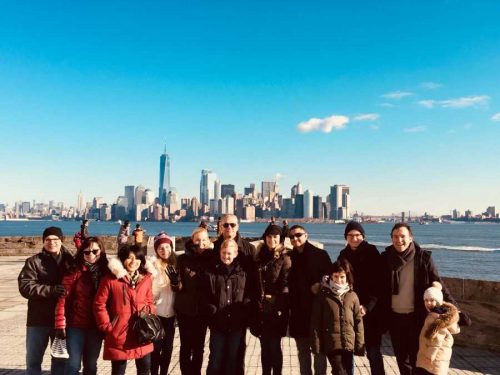
3 Reasons to Take a Guided Walking Tour
There’s a lot that goes into planning a trip. Especially in a city as dense and entertaining as New York. No doubt, amidst…
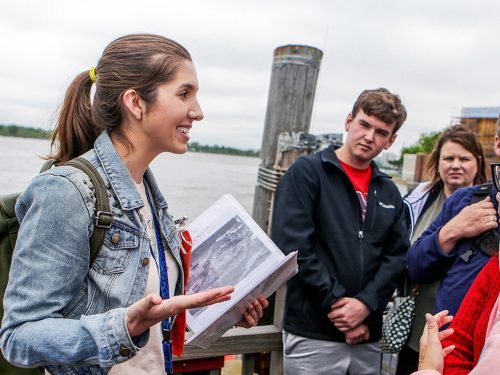
How Much To Tip a Tour Guide in the U.S. and Europe
Let’s face it. Tipping can be a delicate topic, and how much to tip a tour guide can seem especially ambiguous. What’s the…

12 Attractions You Must Not Miss in NYC
So you’re ready to explore New York! Whether you’re planning for a weekend or you’ve been here for years, there’s so much to…
Top Qualities of a Good Tour Guide for Amazing Experiences
The difference between an ordinary tour and an unforgettable experience relies on the qualities of a good tour guide. For that reason, finding an amazing tour guide is not easy, and being one also requires effort.
This blog post is as much for those who aspire to become the best tour guides, as is for tour operators. If you run a tour business, you should know what skills to look for in a good tour guide . If you are a tour guide, you should know how to deliver the best experience for your guests.
The qualities of a good tour guide
A good tour guide is made of a combination of qualities related to personality traits and professional skills .
Of course, if you are a tour guide, you don’t need to have them all to shine in your profession, let alone be born with all of those characteristics. Most of it you can learn and improve with experience.
Now let’s take a look at those traits.
Most desirable tour guide personality traits

Many of the qualities of a good tour guide are related with their personality.
When attending a tour, the guest wants to be involved by the story they are being told. Hence, the person who is telling it needs the ability to transmit all the knowledge and emotion of it.
- Mastering the Art of Storytelling Is All Tour Operators Need in 2021
To delight the guest, a good tour guide needs to be:
1. Enthusiastic
It’s pretty much safe to say that enthusiasm is the most important part of this job. The tourists will sense if you don’t feel passionate when you’re talking to them.
Also, when tour guides are enthusiastic about their subject, they are inclined to acquire more knowledge about it. It doesn’t hurt to mention it helps the guides to withstand mentally and physically exhausting experiences.
2. Engaging
Great tour guides will share their knowledge in an engaging, interactive and entertaining way. Effective tour guides also invite questions and interaction from tour members, rather than treating the tour as a one-person show or a school lesson.
The tourists themselves should be interested in the subject matter because they need to be enthusiastic about what the tour guide is saying.
Let’s not forget that the success of a tour often relies on the members of the group getting on well and enjoying the shared experience. The guide can do a huge amount to make that happen by making sure everyone gets to know each other.
3. Communicative
Having strong communication skills is one of the most important qualities of a good tour guide and a must for tour guide personality traits . You could say they need to have extremely good people skills. As much as tour guides need to be able to speak loud and clear, they need to know how to listen.
Good listening skills mean they can understand what the group is interested in. The conversation between the tour guide and guest has to be an interactive relationship, not just one way. Tour guides have to talk to new people daily, and it has to be in an easy-to-understand way.
4. Outgoing
Well, the trait mentioned above leads us directly to this one. It takes communication skills to a whole new level.
There can be a bit of social awkwardness when a new group of strangers shows up, and a guide should be able to break that immediately. That helps people feel comfortable talking to each other and their guide. This ensures, later on, they feel open to add comments or add questions along the way.
The ability to entertain people with stories and anecdotes would be hard for someone with an introverted personality.
A sense of humor is one of the most welcome qualities of a good tour guide. Intrepid Travel’s Dheeraj “Monty” Bhatt, who won the Wanderlust award for outstanding achievement cited “a good sense of humor” as one of the strongest weapons in a guide’s armory.
It especially helps if you can crack a joke in a crisis. Just like being outgoing and enthusiastic, humor can be the perfect tool to cut any tensions. And as always, add an extra layer of entertainment for guests.
6. Decisive
Leadership and decisiveness are important skills of a tour guide. Although they have to be friendly and funny, at the same time they should maintain a certain level of authority.
There will probably be many unpredictable occasions where they’ll need to make a decision. And make it fast. That has been put nicely in the book Conducting Tours: A Practical Guide .
“Tour leaders translate experience and common sense into firm, quick actions.”
Professional tour guide skills

Every tour company will want that their tour guides leave a professional appearance. It instills trust and confidence in travelers. That way, it makes them feel safe and like they made a great tour company choice!
It will certainly help with your goal if your staff has those qualities of a good tour guide:
1. Organized
It comes almost without saying. Tour guides, responsible for organizing and leading a whole group of people, have to be well organized.
Among other things, this involves setting expectations before the tour – informing customers of the location, time, and length of the tour, what should they bring, and/or any rules or special considerations (if your online booking system doesn’t automate this for you).
For tourists, the tour should seem effortless and seamless.
2. Punctual
Punctuality comes hand in hand with organizational skills. Nobody would be happy about having displeased customers if a tour guide didn’t show up on time to meet them.
3. Able to handle the crisis
Improvisational skills are always needed, not just in crisis situations and tour guide traits. Whether it’s just a minor hiccup in the plan or something bigger happened.
A quality of a good tour guide is to always find a way to calm down people, explain everything in the right way and make them feel better. The same goes for preparedness in case of medical emergencies. Some kind of tours can be much more dangerous than others.
Patience is the kind of virtue that any tour guide without it, usually, won’t be very successful. Jonny Bealby, founder of Wild Frontiers came into guiding following a career as a travel writer. He cited “patience, and lots of it” as the premier quality of a tour guide.
Tour guides will sometimes have to be taking time to explain a complicated historical event. Answer questions they’ve already answered multiple times in their speeches. Walk as slowly as is humanly possible, while waiting for a part of the group to catch up with them. A tour guide needs to be comfortable taking things slowly and to do so with a smile.
5. Sensitive
A great tour guide should be sensitive towards the needs of the group. Tour guides must be aware that what is obvious to them may be completely new for their tourists.
Their clients come from different backgrounds and they are presumably in unfamiliar situations. A perfect guide will be attentive and respectful to everyone in the group, making sure that everyone can see and hear well.
They should make sure everyone is as safe and comfortable as possible. It’s important for the tourists’ satisfaction with your tour.
Other qualities of a tour guide: Be well-informed and interested in the location
There’s no need to state the obvious—tour guides have to know what they’re talking about. Ideally, they would be experts in that area. It helps a lot if they are personally interested in what they are presenting.
Travelers will sense it in the enthusiastic tone of their voice. Tour guide presentation style and tone give a unique touch to the tour experience and an irreplaceable sense of authenticity!
These are a few things they should aspire to be:
1. Multilingual
Speaking multiple languages is, if not a necessity, then just an excellent quality in all the tour guide traits. Ideally, your tour guide should speak a range of languages, including your own, as well as the local lingo.
At the very least, tour guides must have a conversational grasp of commonly encountered languages. This knowledge becomes extremely useful if someone has an emergency.
2. Knowledgeable
Knowing a local is truly an asset when it comes to tour guide traits. They must be able to recite facts from memory and be clear on delivering them.
Facts, of course, have to be accurate—otherwise, they should be able to say they aren’t sure and get back to the customer asking.
Guides provide information about the area, including facts that may be of interest to the group. Which means, they should get to know the group.
Storytelling is a key part of the job. A great storyteller will make any story sound like it’s their own.
3. Willing to learn and improve

The great tour guides should continuously work on fine-tuning the tour to make it an exceptional one.
They pay attention to what guests enjoy the most and the least about the tour. They ask the guests some questions and answer theirs. And they encourage guest feedback at the end of a tour.
This trait can help realize what further steps need to be taken to enhance the tour.
These were some of the most important qualities of excellent tour guides. Sure, for even better success, one could always add a few more. For example, a good sense of direction, good pacing (not too slow, not too fast), good health, etc.
Well, if you find a tour guide who’s got all this or if you are this guide—you don’t have to worry about the success of your tour.
Which quality would you add to this article? Feel free to share your thoughts in our LinkedIn group .
ORIOLY on April 26, 2022
by Lidija Šomodi
Subscribe to our newsletter
Receive the latest news and resources in your inbox
Thank you for subscribing the newsletter

Low Budget Digital Marketing Strategies for Tour Operators
In this ebook you will learn strategies to boost your digital marketing efforts, and the best part, at a low and even zero cost for your business.

The Ultimate Guide to Mastering Trip Advisor
TripAdvisor is an excellent tool to sell tours and activities online and this guide will teach everything you need to know to master it.

A Simple Guide on How to Sell Tours With Facebook
Zuckerberg’s platform is by far the most popular among all social media. So why not selling tours and activities with Facebook help?

Comprehensive Guide on Digital Marketing in Tourism for 2021
Online marketing is a new thing and it changes fast, for that reason we made this eBook where we compiled the latest online marketing trends in tourism!
Other resources

Live Virtual Tours: Everything You Need

5 Channel Ideas to Sell your Tours
How to start a food tour business, related articles.

How to Use TikTok to Promote Your Travel Business
Learn how to showcase your tours and activities on TikTok to convert potential customers into new guests for your travel business.

7 Tips to Get More Bookings From Gen Z Travelers
As Gen Z’s influence in travel grows, adapting to these shifts is not just advantageous—it’s imperative to success in the travel industry.

Unlocking Global Reach: The Ultimate Guide to OTAs for Tour Operators
Explore key strategies for tour providers to partner with OTAs like GetYourGuide and Viator, enhancing visibility and bookings.

8 Ways to Choose the Perfect Tour Company
Last Updated: November 3, 2023
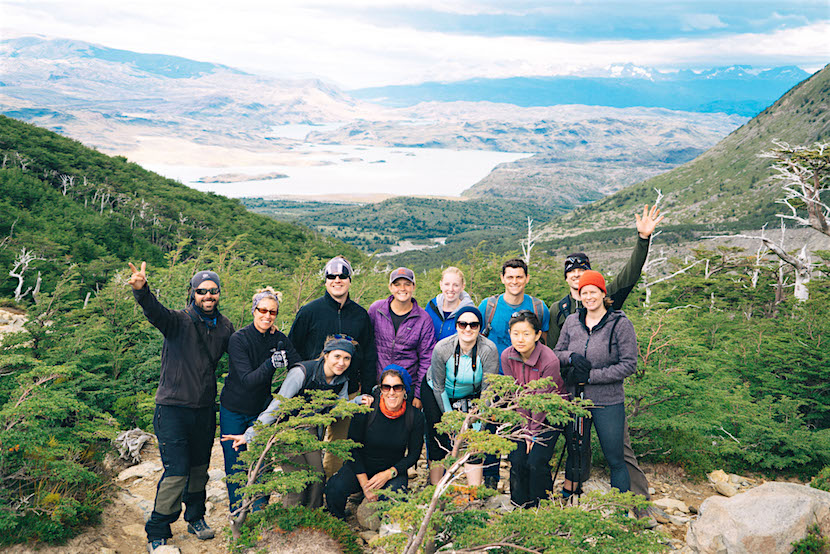
That idea of tours being bad is an old and outdated perception.
These days tour groups have become more adept at the changing landscape. They feature smaller groups, more authentic experiences, a better environmental impact, and more local guides.
I love group tours.
Even though I am an independent traveler, I find group tours super fun, a great way to meet people, learn more from an informed guide, go to places you normally can’t, and wet your feet in travel. My first trip overseas was on an organized tour. I didn’t know the first thing about travel and that tour gave me the confidence to travel on my own. It was the taste test I needed to become hooked on travel. Tours give a lot of people time to adjust to the “travel lifestyle.”
Unlike in the past, today’s tours are eco-friendly, cater to all travel styles, over cheap, and make a point to use local transportation and guides. And many destinations (like Halong Bay, the Galápagos Islands, the Serengeti, Machu Picchu, Antarctica, Everest) are virtually inaccessible without an organized group tour!
In this article, I am going to tell you how to find the best tour company so you get one that is inexpensive, eco-friendly, provides local guides, and gives back to the local community:
1. Research the costs
With tour companies, it’s not always true that you get what you pay for. Many tour companies nickel-and-dime you, while some are really good at maximizing value for your every penny. Ask how your money is spent to find out if you are really getting the best value for your money. How much of your fee is their overhead? Are you paying for top-notch hotels but staying in two-star guesthouses? You want a company that is transparent with why prices are the way they are.
Moreover, make sure you ask if there are added fees to pay when arrive. Many companies require you to pay additional money when the tour starts or don’t include park or attraction entrance fees. That cheap tour won’t be so cheap if you have to pay for everything while you’re there!
2. Make sure you are the audience
Is the tour geared toward older couples? Young people? Families? You don’t want to end up on a loud Contiki tour full of drunk twenty-year-olds when all you want is a quiet holiday.
There’s a tour company for everyone — just make sure you don’t end up on one that isn’t yours. Most tour companies list their guest demographics on their “About” page, and you can usually see from the photos of their tours who goes on it.
You can also tell the audience based on accommodation: if it’s hostels or guesthouses, it’s usually for backpackers and budget travelers; if it’s fancy digs, it’s for older travelers and families.
This is very important because these are the people you’ll be traveling with so you want to make sure it’s the kind of people you are traveling with. I’m still friends with the people from my first tour in 2003 because they were people like me. The tour in Japan that was filled with older families? Not so much. We didn’t have much in common. Wonderful people but we didn’t connect.
So, I always look for tours that have my demographic in them.
3. Get local guides
Guides can make or break your trip. They are going to explain everything to you and keep the flow of the tour going. I don’t want them hiring some young kid, non-expert, or someone who doesn’t know the place well. I’ve been on tours where the guide was a walking encyclopedia, and on somewhere the guide was a glorified timekeeper.
Make sure the company uses knowledgeable, local guides. The guide should be a local or at least a long-term resident, know the local language, have travel experience, and know life-saving techniques.
If you are unsure about the guides, call the customer service line and ask them about their guides.
4. Safety record
Make sure the company follows all the proper safety requirements and is accredited by the local government, the government where they are registered, and any other appropriate trade organizations.
5. A balanced schedule
You’re paying for them to fill most of your day. How do they do that? Are they doing that? Do they have a lot of activities organized, or do they leave you to your own devices?
That said, you don’t want a schedule that is crammed with things to do. Make sure you get a schedule of all the activities and pick a tour that is balanced. Running around will leave you wishing you had a holiday from your holiday, but you don’t want to be sitting around all day, either.
I love taking small group tours because they generally have a good balance. Any tour that requires you to be on a huge bus and hits 6 cities in 5 days is not a tour to take!
6. Environmental impact
There’s a growing trend among travelers called ecotourism . It’s about more responsible travel, not only toward the environment but also toward the locals in an area. This means using local guides, hotels, and services, and making sure to reduce waste and your footprint on the local habitat.
Moreover, these companies tend to offer better and more interactive tours that also give you a good degree of autonomy.
I think it’s important to pick a company that provides great value and gives back to the place you are visiting. After all, did you go there to ruin it for others? Doubtful.
Check with groups like the International Ecotourism Society for a list of companies that have been certified “eco-friendly.” With so much money pouring into the industry now, you have a lot of companies fraudulently saying they practice ecotourism but end up being involved in terrible labor practices, animal abuse, and waste.
7. Group size
Tour companies that have smaller groups tend to be much more mindful of the environment and the impact they are leaving. It’s a lot easier to meet people in a group of 10-15 than it is in a group of 60. I don’t like to go on tours with more than 15 people on them. However, I have friends who love Contiki tours with 40-50 people. Know what you are getting yourself into, so you don’t find yourself with a group too small or too large for your tastes.
Just remember larger groups tend to stay at bigger, more impersonal accommodations (they can only accommodate the numbers), eat at more touristy restaurants, and tend to travel to more destinations quicker.
In my expert opinion, small group tours are the best.
8. Check their reputation
How have other travelers enjoyed their time? Look for online reviews to see what a company’s reputation is. It might not always be what they claim, and it’s important to find out the truth before you book.
Remember that MOST people only write a review if something goes wrong. Someone might give a tour company one star just because their eggs were runny. Find the average. Someone might hate a tour because the weather was hot. Seriously. These are actual negative reviews from the tour operator company, Thomas Cook:
“On my holiday to Goa in India, I was disgusted to find that almost every restaurant served curry. I don’t like spicy food.”
“We went on holiday to Spain and had a problem with the taxi drivers as they were all Spanish.”
“We booked an excursion to a water park but no-one told us we had to bring our own swimsuits and towels. We assumed it would be included in the price.”
“No-one told us there would be fish in the water. The children were scared.”
“Although the brochure said that there was a fully equipped kitchen, there was no egg-slicer in the drawers.”
“When we were in Spain, there were too many Spanish people there. The receptionist spoke Spanish, the food was Spanish. No one told us that there would be so many foreigners.”
“We had to line up outside to catch the boat and there was no air-conditioning.”
So how can you trust the reviews you read online?
Take them with a grain of salt. You can read reviews on websites TrustPilot . The approval rating should look like a bell curve but with more A’s and B’s than C’s. I look for companies that average 85% or higher (or 4 out of 5 stars). If a company is that highly rated, the negative reviews are probably just outliers.
My Recommended (Best) Tour Companies
Here are some of my favorite small, day-tour, or backpacker bus tour companies:
- Take Walks – This is my favorite walking tour company. They run a wide variety of insightful and entertaining tours around Europe and the US. What makes them so good is they get you inside access to attractions and places you can’t get elsewhere. Their guides rock too!
- Get Your Guide – A massive marketplace for tours, activities, and excursions. If you’re looking for something niche, you’ll find it here!
- Devour Food Tours – My go-to tour company for tasty food tours around Europe and the US.
- Kiwi Experience – A hop-on, hop-off bus tour company in New Zealand for backpackers!
- Baz Bus – A hop on, hop off again bus tour company in South Africa for all travelers.
- New Europe – Free walking tours throughout Europe.
- Free Tours By Foot – Pay-what-you-like tours throughout Europe and the United States. They are one of my favorite free walking tour companies in the world!
THE #1 COMPANY FOR MULTI-DAY SMALL GROUP TOURS
When it comes to multi-day, multi-week tours (think trips through Morocco, sailing in the Galápagos, etc.), I highly recommend using Intrepid Travel .
Intrepid is my favorite and best small group tour operator out there! I really love their guides, their small groups, off-the-beaten-track itineraries, and their commitment to the local environment and community. I always have an incredible time on their tours. They are my favorite multi-day tour operator and the only one I use now (the picture at the top of this page is me on their Patagonia trip). Intrepid is environmentally friendly, uses local guides and transportation, doesn’t rush their tours, and are quite inexpensive. I don’t even consider anyone else when it comes to multi-day trips.
I love tours. They are a great way to meet people, get a local to add value and knowledge, and see places you can’t get to alone! I don’t take them often but I do take them. And, since I follow the above rules, I always have a good time. Some of my favorite travel memories were when I was on a group trip. If you follow my tips above, you’ll never go wrong either.
GET YOUR FREE TRAVEL STARTER KIT
Enter your email and get planning cheatsheets including a step by step checklist, packing list, tips cheat sheet, and more so you can plan like a pro!

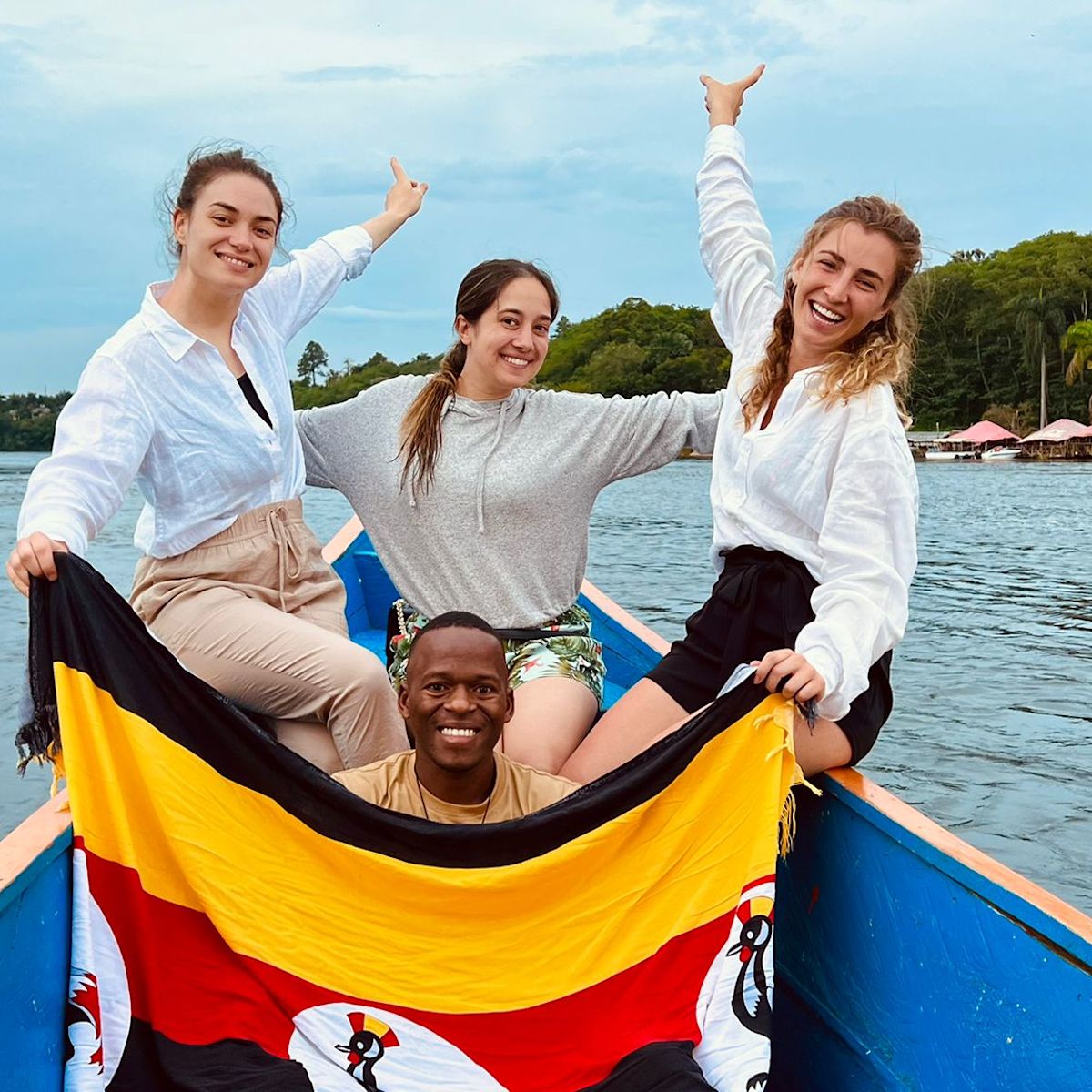
12 reasons why good tour guides are so important
Ah, the tour guide. That special person who welcomes you to their country and looks after you, ensuring you have a fabulous trip! But how and why exactly are they a great addition to a trip? We enumerate ...
1. Tour guides navigate for you
Wondering if you've missed your bus connection is frustrating. So too is getting off at the wrong stop. And fuming at a loss of signal at the very moment you need your app to tell you which exit to take ... nobody needs that.
So yes, primary among the benefits of a tour guide is having someone to do all the navigating for you.
Navigating can include:
- Getting your from the airport to your hotel without hiccough.
- Leading you through the warren of streets in an old town.
- Taking the lead on a trek so you don't go in a circle.
- Even just ensuring you find your way out of that enormous botanic garden.
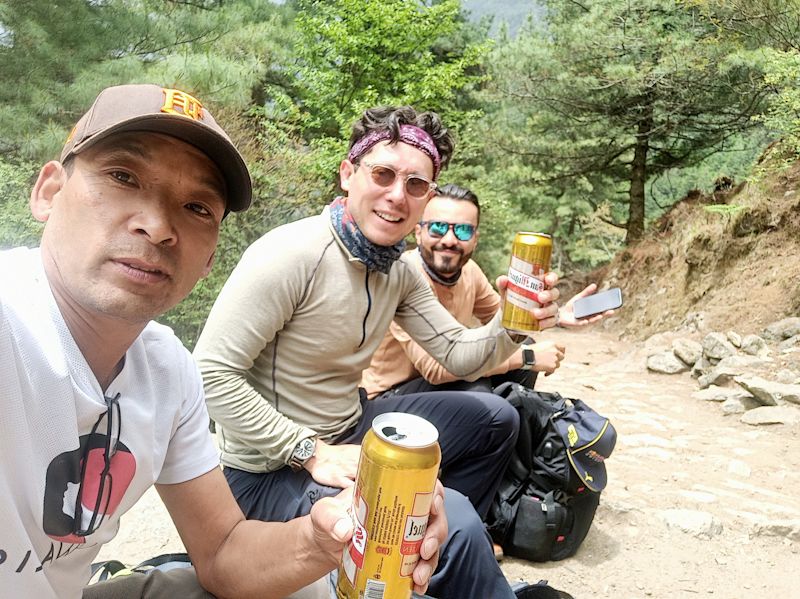
Some of our trekkers with their selfie-taking guide Angelu on the EBC trek
Navigating can include driving you
A tour guide also often drives you around. Or in some cases, they'll acquire a vehicle and driver for you.
This is a big help, saving your from the hassle of a car hire. You also won't have any heart-stopping moments when you pull out and realise you're facing oncoming traffic. And you won't ever come back to your vehicle to discover you didn't feed a hidden parking meter.
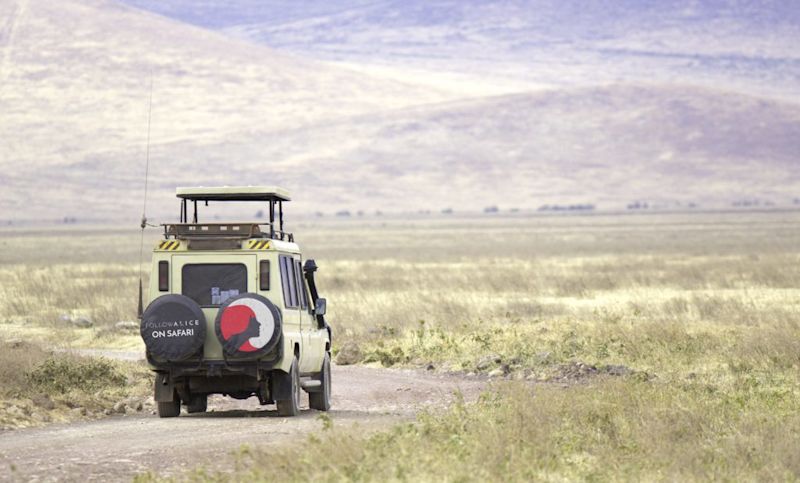
On safari, your tour guide is also your driver
2. Tour guides do your admin for you
This is a biggie. Tour guides take care of all of your admin for you, like:
- Preordering permits and pre-booking accommodation.
- Paying admittance fees beforehand, saving you the need to queue.
- Coordinating travel times for buses, trains, flights, etc.
- Overseeing the transfer of luggage.
- Ordering and collecting packed lunches, drinking water and the like.

Some of our trips, like Kilimanjaro climbs, involve a LOT of admin!
3. Tour guides keep you safe
If safety was the only benefit of a tour guide, we think it would be enough for us to be super pro tour guides! A tour guide looks after you from arrival to departure.
It's worth pointing out that at Follow Alice we believe tour guides should be locals. One of the reasons for this (although there are certainly others as well) is that only locals can truly know the do's and don'ts of their society and environments in order to keep you safe.
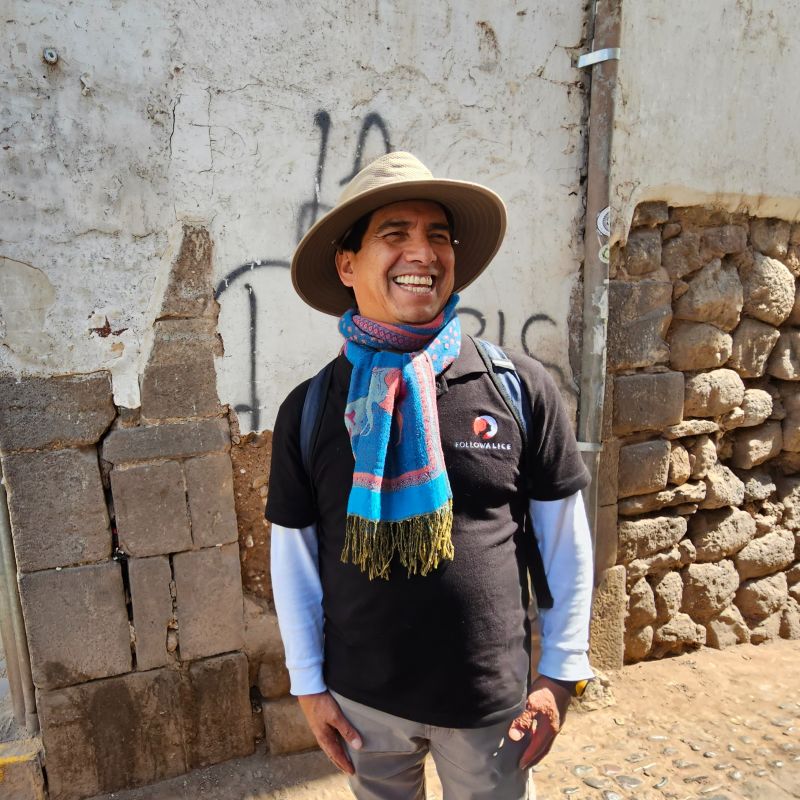
Mario is our Cusco and Inca Trail lead guide
Local tour guides are there with you to ensure:
- You don't go into any dangerous areas.
- You're not accosted by overly zealous vendors.
- Your belongings are kept safe.
- You don't get bamboozled by shysters.
- You don't pick a poisonous plant, or pet a treacherous animal.
The list could go on.
Tour guides also ensure you don't get 'little things' wrong, like wearing sandals on a day when they know you need closed, sturdy shoes.
Adventure tour guides are especially important
The adventure tour guide offers a whole other level of safety and security. Whether it's guiding you safely through islands on a kayaking adventure, or leading you through thick forest on a trekking trip, they're there to ensure you:
- Set out with the right clobber to protect you from the elements.
- Stay on path and don't get lost.
- Don't push yourself too hard (sometimes by monitoring your vitals).
- Receive timely and appropriate treatment (medical or otherwise) should you need it.
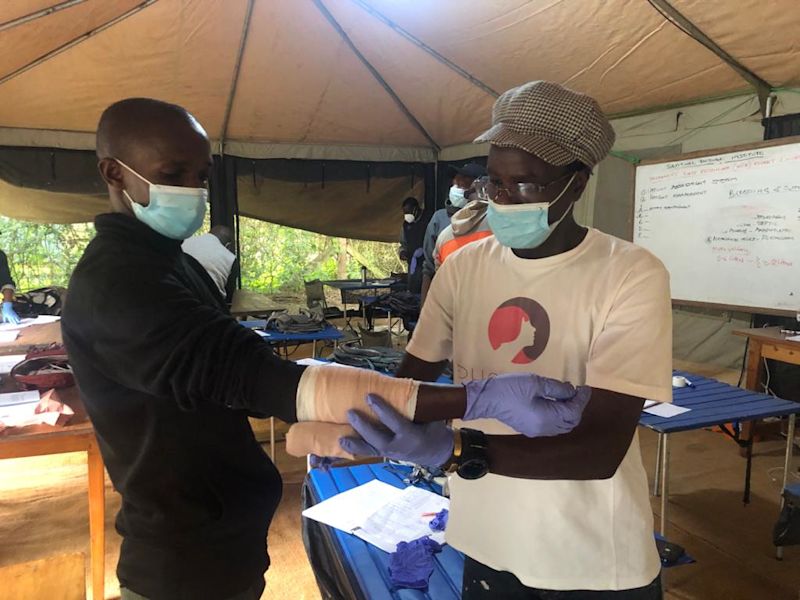
Chris, our Tanzania local leader, doing his refresher mountain first aid course
It's impossible to overstate the value of a tour guide in keeping you safe, especially on an adventure trip.
4. Tour guides are interpreters
A tour guide speaks the language of the locals, and as such is your ever-present translator. Without a tour guide, you wouldn't be able to communicate with some locals. You'd also miss out on many interesting insights and some beautiful moments of connection.

Brad and Rebecca opted to do a homestay in Rwanda through Azizi Life
Remember to always ask before taking photos of locals; your tour guide can assist in this to ensure nothing is lost in translation.
5. Good tour guides explain things to you
It's easy to find out the name of the bridge you're walking over. But do you want to know why it's called that? And yes, you can take a pic of a gorgeous tree and use an app to tell you it's name. But do you want someone there to explain why, for instance, the bark is stripped away near the base?
Tour guides are there to answer your questions, and also supply answers to questions you hadn't even thought to ask!
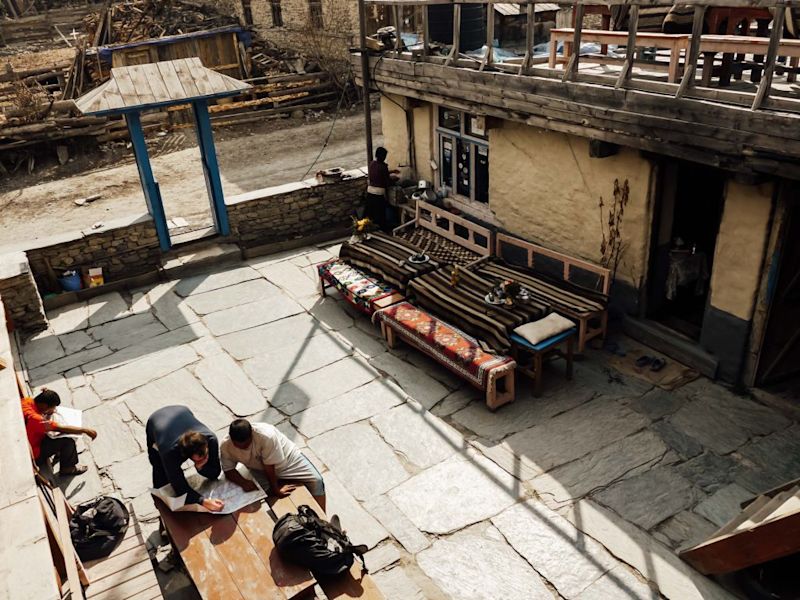
An Annapurna Circuit trek guide explaining tomorrow's route
Tour guides have intimate knowledge of the area and can drop all sorts of fabulous knowledge bombs.
Tour guides also give you insights into how locals feel about what's going on in their country and around the world. So from them you get to learn about some truly local perspectives. And we all know that logic isn't universal – what seems logical to one culture can be very different in another, and it helps to have a guide with you to illuminate such things.
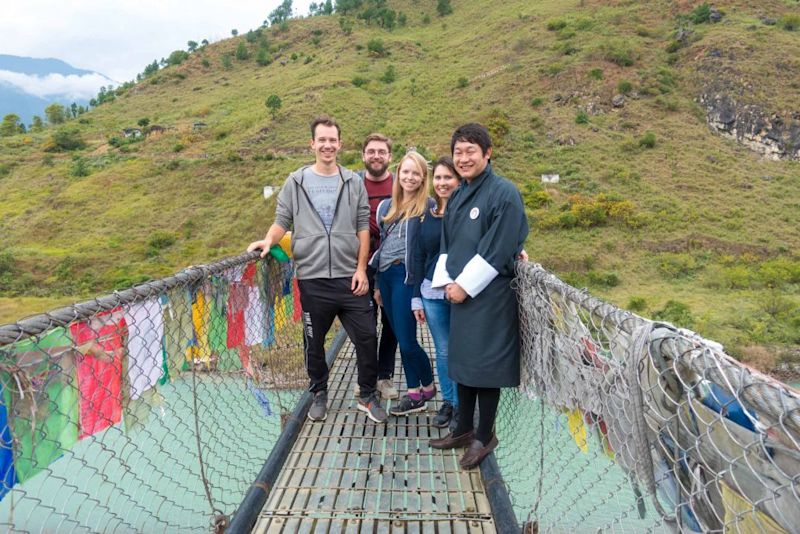
A Follow Alice group with their Bhutanese tour guide
Finally, tour guides are there to ensure you don't blunder unnecessarily in terms of local customs and sensitivities. They can also advise you ahead of time if you need to dress smartly or cover up in order to enter certain places.
6. Good tour guides get you good deals
When you travel with a tour guide, they (and the tour company they work for) are able to get you the best deals. They know which days have cheaper admittance fees, for instance. They can also sometimes get tour guide discounts that aren't available to tourists.
Finally, when you join a tour guide who's leading a large group, they're often able to get some sweet group discounts.
7. Good tour guides are photographers
Sometimes it's great to hand the camera to someone else to take a photo with you in it. 📸
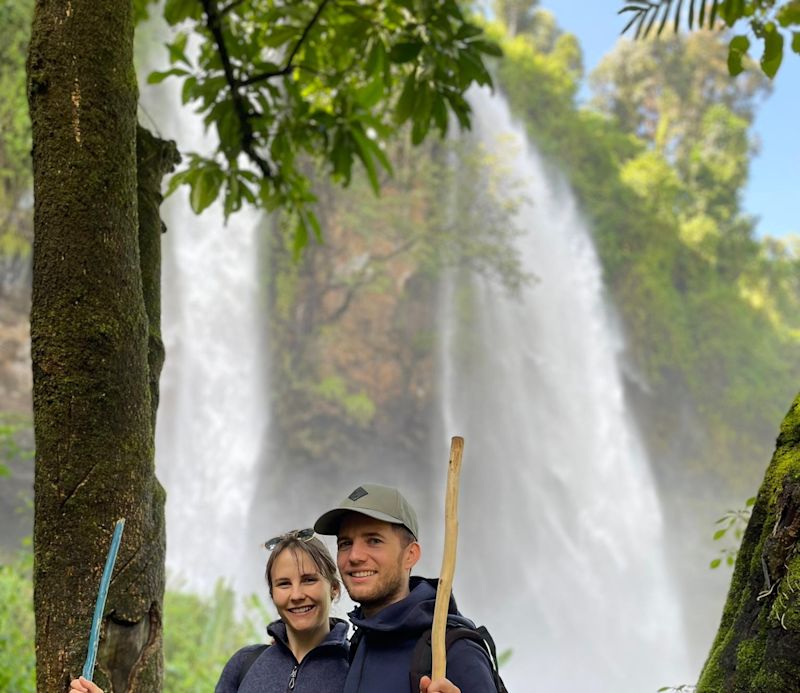
They can take a snap for you ...
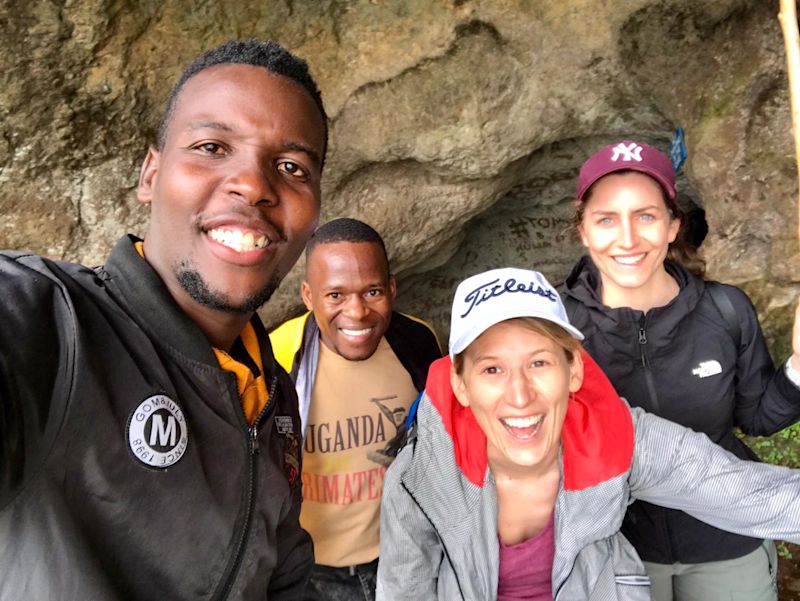
... or a selfie with all of you in it!
8. Good tour guides encourage you
On tough adventures like high-altitude trekking, most of us end up in need of some encouragement when the legs tire and the mind starts to tell you sneaky lies like you can't keep going. Your guide is invaluable is encouraging you in such moments. They can also provide little tips for the mind and body to help you to keep going.

One of our groups tackling the tough Kala Patthar near Everest Base Camp
A good tour guide believes in you and knows how to help you to believe in yourself.
We can't tell you how many folks have told us that they would literally not have made it to the summit of Kilimanjaro if it hadn't been for the support of their guides.
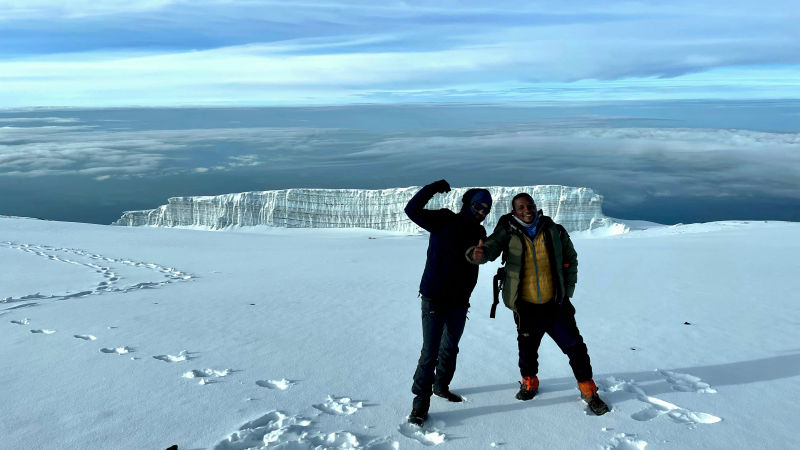
Our client George K. took this fab pic of two of his Kilimanjaro crew members
9. Good tour guides ensure you miss nothing
A tour guide knows the area intimately and knows of people, quiet spots and experiences that aren't discussed on any website. They're there to ensure you get the most out of your time, and have the most authentic experience possible.

Dean with his safari guide Heri on a walk near Lake Natron
This includes seeing animals!
Safari guides are trained to spot hard-to-see animals that city-dwelling mortals would surely miss. It's amazing the number of camouflaged animals and birds that safari guides are able to point out to clients.
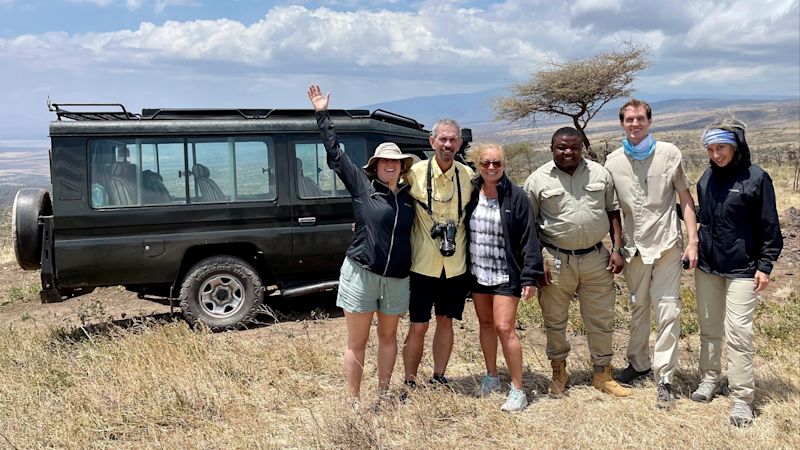
Dannielle took this pic with her group's safari guide in Tanzania
They give you recommendations
A tour guide can also be invaluable in terms of recommendations for markets and shops to pop into, museums, galleries and palaces to visit, gardens and parks to explore, and so on.
And the reverse is true too. They know what places to avoid because they're actually letdowns, overcrowded or overpriced.
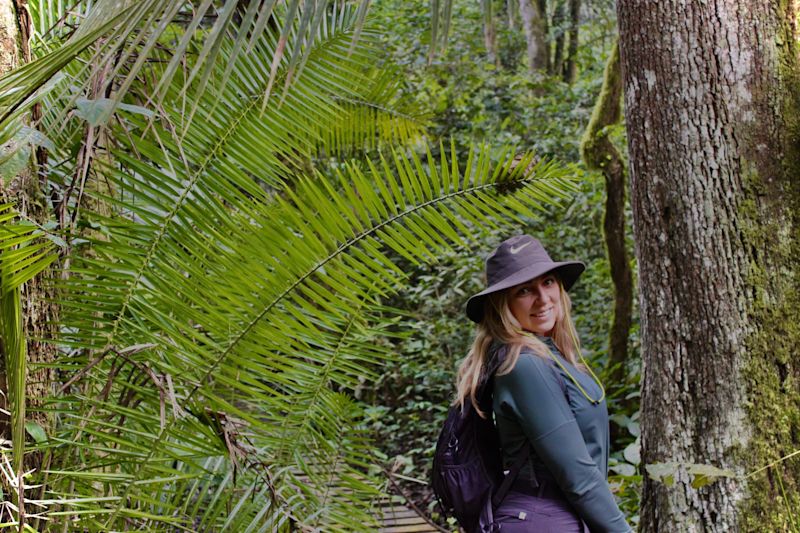
Amber on a chimp trek in Uganda
Tour guides also know where the locals like to eat – and those are often the places with the tastiest and best-prices meals. And when you have a local with you, there's no possibility of feeling awkward, like not knowing if you should seat yourself or wait to be seated. (Your tour guide is also a good person to ask about tipping customs.)
10. Good tour guides pivot when necessary
If you arrive somewhere and it's closed for renovations, or unexpectedly overcrowded, then your tour guide is able to pivot and suggest the next best option, or an alternative, to ensure you still maximise your time in the destination.
They really do take the headache out of travelling!
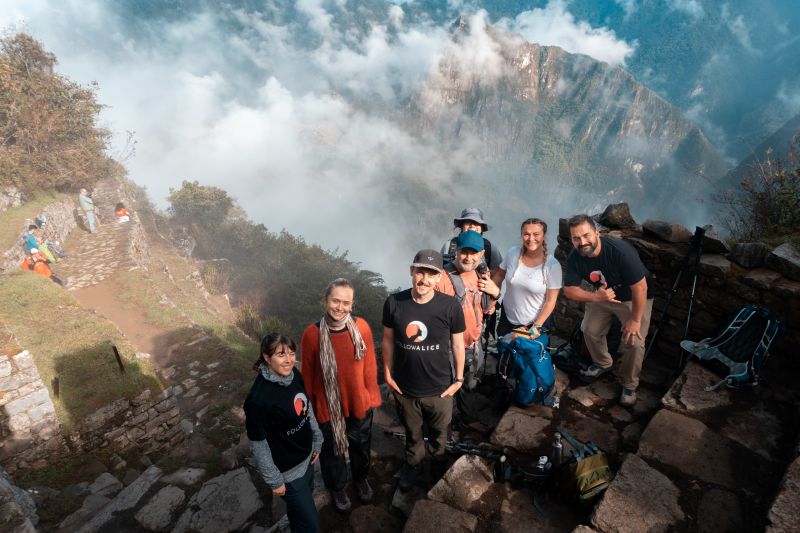
An experienced guide can pivot when necessary in a way that still gives you a memorable trip
11. Great tour guides celebrate your wins with you
A really great tour guide is invested in your trip. They want you to get the most out of the experience. And if it's an adventure trip with a set goal in mind, they want you to succeed in that!
Then, when you reach your mark, or push yourself beyond what you thought possible, a great tour guide is there to celebrate with you! They add to the victory moment by high-fiving you and generally making a fuss. 😄
Also, if you're a solo traveller, then it's especially wonderful to have another person there to make a noise about your win with you.
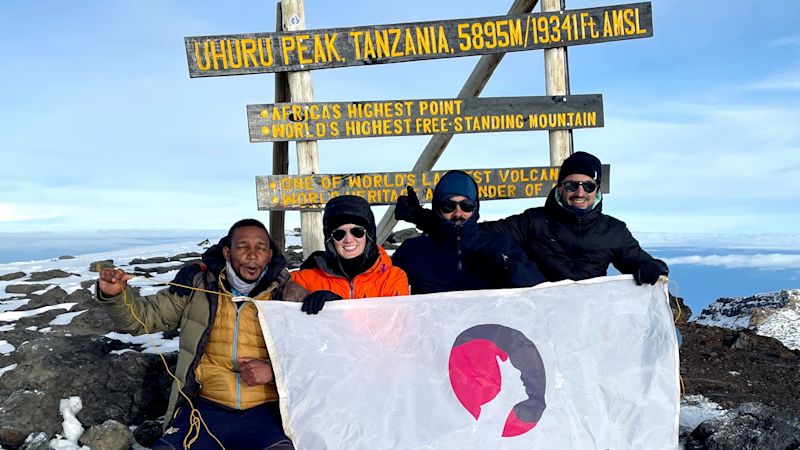
Tour guides are there to celebrate your achievements with you!
12. Great tour guides can even become friends
Sometimes, your tour guide adds so much to your trip, and you spend so much time together, that you end up becoming friends!
We cannot begin to tell you how many times this has happened on our trips. In their post-trip feedback, our clients often express not just gratitude for the encouragement and support of their guides, but also a genuine affection for these special people with whom they bonded and shared an incredible adventure.
One picture that perhaps best sums this up is this one below of Jack with one of his Kilimanjaro crew members at the end of the climb ...
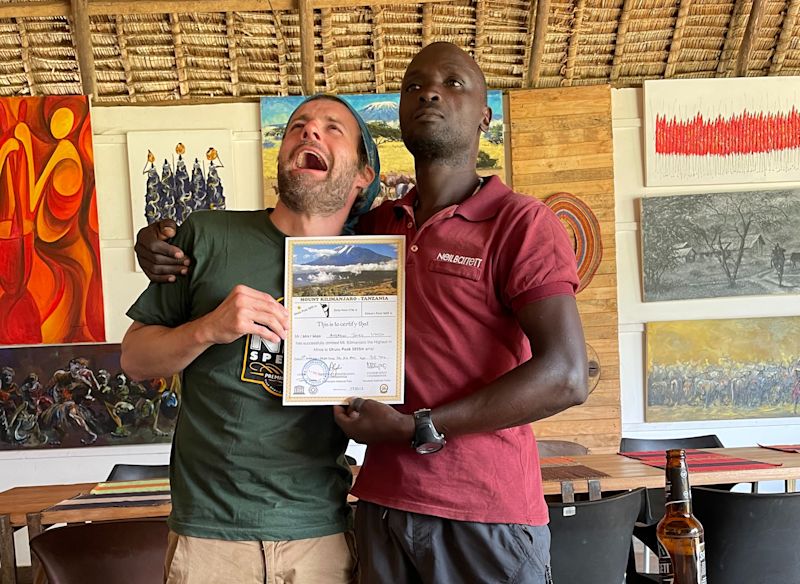
Jack and David celebrating with Jack's summit certificate
Traveling as a Tour Guide: Pros & Cons
For travel fanatics like me, working as a tour guide seems like a dream job. You mean, someone will pay me to travel?! Yes, please 🙂 I’ve worked as a tour guide in a couple of different capacities. There are certainly a lot of cool perks to the job, but it’s not all fun and adventure, that’s for sure! This post will explore the life of tour guide, including both the pros and the cons. If you’re thinking of trying out this profession or are interested in the guide’s perspective on the tours you take, read on!
Tour Guide v. Tour Director/Manager v. Trip Leader
First off, a definition clarification. I’m using the term “tour guide” as a broad classification, though “tour director” , “tour manager” , or “trip leader” would be better terms for what I’m talking about in this post. All three of those titles basically describe the same position: someone who travels with a group of tourists to multiple destinations, coordinates their travel, hotels, and activities, and is with them the entire multi-day trip. Technically, a “tour guide” is a better description for a slightly different role: someone who is a specialist in one destination, sight, or activity, who stays in one place, sharing the same information with multiple different tour groups who visit that place.
I have experience in both of these roles. I was a zip line tour guide, leading three groups a day through a 2.5-hour treetop canopy tour. I followed the same course, giving roughly the same information to each group, tailored slightly to their interests. I was a tour guide . In another position, I lead groups of foreign tourists on adventure camping tours lasting 1 to 3 weeks each, to multiple destinations on a road trip across the United States. I drove the group in a van, gave them basic information about each of our itinerary stops, and coordinated all meals, hotels, campgrounds, and activities. I was a trip leader , though could also be called a tour director or manager. The pros and cons in this post will focus on this style of trip leader role, though some may also relate to a tour guide role.
Free Travel
I mean, this is the main pro, right? Gotta love free travel! There are lots of ways to get some aspect of your travel for free ( travel hacking , house sitting , hitchhiking , work exchange , Couchsurfing , free-food bins , to name just a few I’ve written about…) but to combine them to have every aspect of your trip free would be a bit of a challenge. That’s basically what you get as a tour director, though. You may have to pay for some of your own meals, while others are included, and, of course, any souvenirs or personal items you buy would be at your own expense. But all transportation and accommodation are completely free for the trip leader.
Opportunities for Amazing Experiences
As a budget traveler, I often have to choose which sights and experiences are most important to me. I can’t afford to do everything and some things are eternally out of my price range. As a tour manager, you don’t get to do everything your group does, especially optional excursions, but you do get to do most of them. And sometimes, the vendors will want the trip leaders to have experienced their optional excursions so that they can better sell them to their guests. This means they let the trip leaders try them for free.
In just one summer leading groups around the US, I got to take helicopter flights over the Grand Canyon and the Las Vegas strip, multiple “party limo” rides up the Vegas strip, and multiple sunset catamaran sails under the Golden Gate Bridge. I attended two difference Cirque du Soleil shows, slept under the stars after a Native American dinner and performance in Monument Valley, and got free entry into 20+ national parks. All incredible, once-in-a-lifetime experiences that were essentially perks of my job.
Meet People from All Over the World
You never know who you’re going to meet in your tour group. People from various countries and backgrounds come together in a situation where they are regularly having conversations with you and asking you questions. It’s a great way to get to know a lot of different cool people who are specifically interested in what you have to say and getting to know you. It’s a great way to learn about other cultures and sometimes you can make friends and stay in touch.
No Expenses
Depending on how long your trips are and how many you do back to back, you may be able to get away with not only no travel expenses, but no living expenses also. I was on the road as a trip leader for months on end and I did not maintain a residence or vehicle during that time. No rent or mortgage, no utilities, no car payments, gas or insurance. I didn’t need them! For some tour directors, however, trips can be spaced far enough apart or you only do them seasonally in the summer, for example, so you do want to maintain a permanent residence. In that case, you can’t cut living expenses entirely, but perhaps you can reduce them by looking for a tenant, subletting, or getting someone to help you run an Airbnb rental while you are away.
Earnings Can Be High (+ Tips!)
Depending on the style of trips you do, tour managers typically make between US$100 and US$200 per day. Plus tips! And having limited or no expenses mean you can save everything you earn. It can be a great way to save a lot in a short amount of time.
Great Learning Opportunities
As a tour director, you are the first authority your group will go to for any and all information about your destination in general and all of the specific sights on your itinerary. Some tour companies arrange for “hop on” local guides who come in just for the day or lead your group around one particular attraction and can provide much more detailed information. Even if this is the case, as the trip leader, you need to have some basic facts about everywhere you go. This means a lot of research but also a lot of cool new knowledge. And if you do get local guides, you’ll learn even more from them!
Potential to Rack Up Major Credit Card Points
This one is not always the case, but can sometimes be a cool bonus perk. Tour managers are given a certain amount of money to cover expenses (entrance fees, tips, meals, etc.) as they come up on the tour. You might have a company credit card, a prepaid credit card, cash, or some combo. The company I worked for gave us our allotted budget for each trip upfront and allowed us to deposit it into our own personal bank accounts if we wanted.
We could then put all tour related expenses (which could be thousands of dollars per trip) on our personal travel rewards points credit card. The company cash would then be in our accounts to pay for the credit card bill when it came. This way we could “spend” a ton of money and gain a lot of points quickly , which we could then translate into free flights and hotels for personal trips. If you are allowed to do this, you will still have to be accountable for every penny. Keep track of all expenses as you go so that you never overspend and can withdraw any unused funds to return to the tour company at the end of the trip.
It’s a LOT of Work!!!
People travel with group tours for convenience. All the work is done for them and they can just enjoy the trip. As the tour manager, you are the one doing all that work. You are coordinating all travel, vendors, sights, tours, hotels, not just for yourself, but for a large group. And that is on top of all the hours interacting with the group, planning, doing paperwork, and researching each destination. The company I worked for had their trip leaders double as drivers, so I couldn’t do paperwork, relax, or sleep in the van like my passengers. I had the added work of planning a route, gas and rest stops, navigating to places I’d never been before, and keeping the van clean.
Plus, my tours were adventure camping tours, so we cooked many of our meals over a camping stove or fire at the campgrounds. This meant I also had to meal plan and grocery shop for 2-3 meals per day for up to 12 people, some with particular dietary requirements. Any time I had away from my group was spent doing the extra planning, research and shopping that was “behind-the-scenes” of my job. There are no lunch breaks as a trip leader. It was so much more work than I ever thought it would be! This is probably an extreme example of a particularly taxing travel style, but even luxury tours require a ton of work than the group never sees.
You’re Not a Tourist – No Time for Sightseeing
Even though I was traveling to tons of cool places and bringing my group to amazing sights, a lot of the time I did not get to enjoy them myself. In order to accomplish my other tasks, if the style of attraction allowed, I would drop groups off to explore on their own while I got the van cleaned, went grocery shopping, looked up where the heck we were supposed to go that afternoon, or sometimes tried to get a quick power nap. When I did go with my group, I was supposed to be the authority on the sight, showing them the highlights. There was no time to explore different areas I might want to see. This can vary, depending on the tour company, the tour itinerary, and if you get local guides or not. In some cases, you may be able to play the tourist to a point but it’s not your role. You won’t have time to take photos and selfies everywhere. In fact, you’ll probably be taking tons of group shots for your travelers on their cameras instead.
Always “On”
This was one of the biggest cons for me. From the moment you pick up your group to the moment you say goodbye to them, you are “on” 24 hours a day. Even when they have time to explore on their own or after you are in your hotel room for the night, if they have a question or an issue, they will come to you and you have to deal with it. You can’t say, “Sorry, I’m on a break,” or “I’m off duty for the evening.” As a camping trip leader, I had the further obligation of hanging out around the campfire with my group every night. I couldn’t close a hotel door and at least have some privacy and downtime. Tents are not soundproof… Even if you are generally enjoying the trip and your group, this can get super exhausting. I was already burnt out from being “on” all the time about a month into my job. As an introvert who absolutely needs my alone time to recharge, this was especially difficult.
Don’t Get to Choose Your Group
You never know who will be in your group. Most of my travelers were nice people having fun but there were often one or two people who were… difficult. From making off-color jokes or getting drunk every night, to being extra inquisitive and demanding or just clashing personalities. You still have to be nice, friendly and accommodating to these people while attempting to manage their behavior so it doesn’t negatively affect the rest of the group. You can’t walk away and you’re the one people will complain to.
Don’t Get to Choose Your Itinerary
While there may be some freedom within certain trips, for the most part, the itinerary will be set by the company. This is to make sure everything is booked and that everything they’ve promised their clients will be included. If you particularly want to visit a place that’s not on the itinerary, you most likely can’t. If you absolutely loathe one of the stops, you can’t skip it. There’s not a lot of travel freedom or room for spontaneous choices, as you would have on your personal travels.
Must Solve Not Just Your Travel Problems, But Everyone’s
Inevitably, something will go wrong when you travel. A flight will be delayed. It will rain on your nature walk. Someone in your group will get lost or hurt or robbed. As a tour manager, their problems are your problems! You have to deal not only with any issues you personally come across but those of your entire group. Sometimes dealing with one person’s problem creates a larger problem for everyone else, such as a delay, detour, or missing an activity. It can be tricky to balance everything so everyone is happy.
Earning Can Be Low (Per Hour)
I know, I know, I listed a high wage in my pros column, and that’s totally true. As a whole, you can make and save a lot. But if you look at it in comparison to the hours you work and the amount of responsibility you have, it’s actually not that great. Let’s say you make US$150 per day. That sounds pretty decent, right? And it absolutely would be for a typical 8-hour workday. But as a trip leader, you work much longer hours and are technically “on” 24 hours a day. US$150 for 24 hours of work is only US$6.25 per hour. That’s way less than minimum wage! You’ll have tips, too, but even then, the hourly breakdown is very low and they are not guaranteed.
Bottom Line
Your success and ability to handle the intense demands of a trip leader position will probably be dependent on your personality. If you are outgoing, love being around people all the time, and are good with stress-management, it can be a really cool job. For those people, the benefits would probably outweigh the drawbacks. For me, as an introvert and a very independent person, however, it actually turned something I absolutely love, travel, into a total nightmare. Tour guiding , on the other hand, where I could share a cool experience I was very knowledgeable about with different people each time, then say goodbye and clock off, was a total blast. If considering a tour director job, think about not just the free travel, but if your personality and stamina are suited to the role. Or next time you take a tour, you’ll have more insight into your guide so hopefully both you and they will have a better experience.
*This post includes one or more affiliate links. I earn a small commission (at no extra cost to you!) if you purchase a product or service through one of these links. Find out more here . *
Related Posts
- 5 Ways to Work Abroad
- Become a Digital Nomad: 5 Jobs Anyone Can Do Anywhere
- Teaching English Abroad: DOs & DON’Ts
Want more from The Global Gadabout? Sign up for the newsletter and get access to exclusive printable freebies!
Leave a Reply Cancel reply
Your email address will not be published. Required fields are marked *
- Skip to main content
- Skip to secondary menu
- Skip to primary sidebar
- Skip to footer
ZigZagonEarth
Plan unforgettable road trips!
The best & worst of Tour Guides
Last updated on February 23, 2016 by Claire Robinson - this article contains affiliate links. If you purchase through them, I get a small commission ( more )
As a solo traveler, I often use group tours for just Day tours or week-long trips
And what makes the tour unforgettable (except for the place…) is not so much the organization, equipment, weather etc… it is the tour guide!
Some are exceptionally good… but some can be horribly bad. I have decided to share with you some of the best and worst tour guide experiences I had.
Australia – Red Centre: the one with whom it did not click
During my 5 day tour around Uluru , the guide was quite impressive taking care of driving, getting the wood, cooking etc… especially as it was pouring rain. However I had a reallz hard time as we did not have the same style at all. He was completely free, things will happen when they will happen and, as you know, I am a crazy planner.
So when he told us we could go walking around Uluru, I said ‘great, where and where are you picking us up?’ And his answer was ‘oh I will tour Uluru many times and find all of you!!!!’ Ahhh, driving me crazy!
Japan: the replay-guide
I joined an organized day tour to Mount Fuji. This was sadly a huge bus, and I prefer small group tour.
Well, it was not that bad. He had drawings and maps to explain but he was repeating all of his sentences twice word for word the whole time! Also driving me crazy!
Thailand: worst situation ever
I booked a day tour at the hotel to go & visit the amazing ruins of Ayutthaya. This is a beautiful place, but if I had taken a bus to go there it would have been exactly the same
Also the hotel guaranteed an English speaking guide, the guide actually did not speak a word of English… he could not even tell us at what time we were supposed to be back to the bus! We had to draw a clock on a piece of paper…
Australia-Great ocean road: in the heart of the action
In Melbourne for the weekend, I booked a small group tour to the Great ocean road and this was one of the best tours I’ve ever done. First the scenery was stunning.
And on top of that the guide was really great: funny, knowledgeable, helpful. At one point we stopped and head down to the beach at Loch Ard Gorge where he had some of us climbed on a big rock and re-enact the history the place was famous for. It was the wreck of the Loch Ard and its 2 survivor ( check the story here ). Strangely he picked the good looking blond girl to be the survivor… 🙂
Namibia: YoYo Quality
On my second week of Namibia, we had a very nice guide that was exceptional for some part and terrible for others.
For example, explaining history was not really his thing. We arrived at Twyfelfountein, famous for its engravings, and he started telling us how the New Zealand people requested that site to be on the World Heritage Site List with 31 votes etc… 2 min later I read the sign and found out the real story, LOL :
However, he did something so fantastic for us that week, that we awarded him with a card of best tour guide ever!
He got us to look lions in the eyes. Go check the story here !
So yes, a guide can change your experience, but I found that when booking a small group tour, you are almost assured to have a good guide even if he is not your style!
And you, do you have some good stories about tour guides?
ZZOE from ZigZag On Earth Travel Blog
Reader Interactions
June 21, 2014 at 6:41 AM
I appreciate your blog well written by you. We can find both worst and best tour guides. In this blog you discussed about good thing which is useful for everyone especially for the people those who loves to travel. I’ll share this through my blog and thanks for sharing this informative post. Keep up blogging.
September 23, 2014 at 11:39 AM
This is a great blog and I have got inspiration on this blog for tour to Western Australia. It is helpful tips are really helpful for me.Thanks for sharing this valuable article. ……..
Leave a Reply Cancel reply
Your email address will not be published. Required fields are marked *
Par Claire Robinson Region Lovers SARL 76600 Le Havre FRANCE VAT FR21845103191
Follow ZigZag on Facebook
Follow ZigZag on Pinterest
Website in French: ZigZagvoyages.fr
Website in German: ZigZagreisen.de
Website in Spanish: ZigZagviajes.com
And discover the French regions:
Normandielovers.fr LoireLovers.fr CorsicaLovers.fr Provencelovers.fr
Privacy / Terms of Use / Disclosure Policies / Refund policy
Become an affiliate for the ZigZag road trip guides
As an Amazon Associate I earn from qualifying purchases. ZigZagOnEarth.com is a participant in the Amazon Services LLC Associates Program, an affiliate advertising program designed to provide a means for sites to earn advertising fees by advertising and linking to Amazon.com, Amazon.uk and Amazon.ca

30 Major Pros & Cons Of Being A Tour Guide
“I was a food tour guide – I took people on a tour to different restaurants in the area.”
Kelly Marie Tran, Actress
Pros and Cons of Working as a Tour Guide
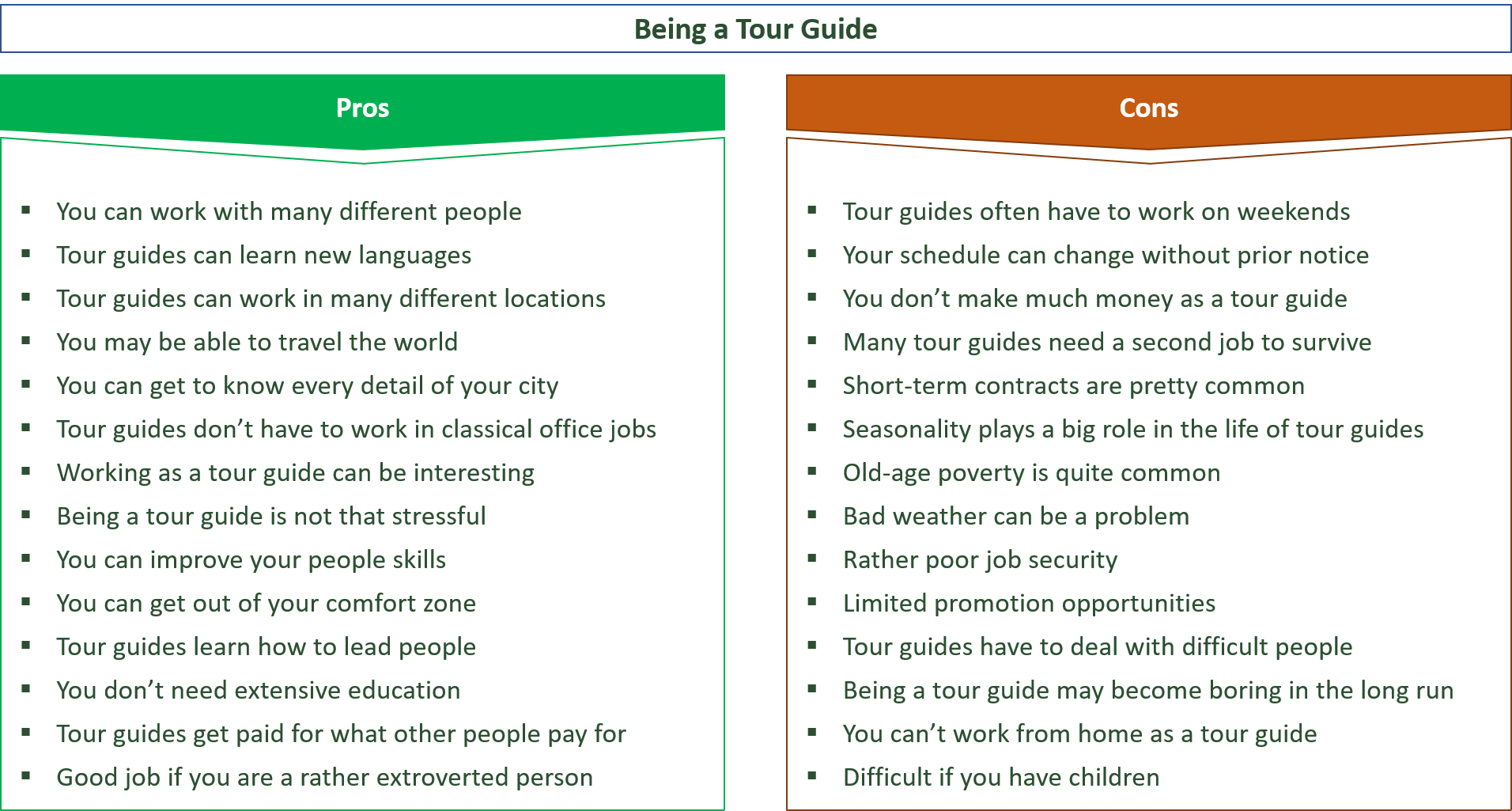
You think about becoming a tour guide?
While working as a tour guide can be great, there are still some issues related to this career path.
Thus, make sure to check out all the pros and cons of being a tour guide in this article.
After evaluating all the arguments, you may change your mind and go for a different job instead.
Table of Contents
Tour Guide Job Profile
Advantages of being a tour guide, you can work with many different people, tour guides can learn new languages, tour guides can work in many different locations, you may be able to travel the world, you can get to know every detail of your city, tour guides don’t have to work in classical office jobs, working as a tour guide can be interesting, being a tour guide is not that stressful, you can improve your people skills, you can get out of your comfort zone, tour guides learn how to lead people, you don’t need extensive education, tour guides get paid for what other people pay for, good job if you are a rather extroverted person.
One advantage of being a tour guide is that you can get to know many different people.
This can be pretty interesting, especially if you have an international audience and can talk to many people from all over the world.
Not only will this give you the opportunity to see the world from a different perspective and to hear many different opinions about politics and about what’s going on in the world right now, it also gives you the chance to make many new friendships over time.
In fact, it is pretty easy to stay in touch over social media thanks to our modern technology and you can easily stay connected with the clients you liked most.
Who knows, maybe you’ll visit them in their home countries one day?!
Having those contacts always helps since you only get to know the real experience on your travels if you know locals in foreign countries and can rely on their expertise.
Since you will meet so many different people from all over the world during your career as a tour guide, you will also be able to learn new languages in a pretty natural manner.
Sure, chances are that your grammar and your pronunciation will not be perfect.
Yet, you will still learn some new words and even this limited knowledge can greatly help you out during your travels since locals will be pretty impressed, especially if you learn some words in a pretty exotic language that almost no tourist speaks at all.
As a tour guide, you can also work in many different locations.
While you might start your tour guide career in your home town, you could also work in many different locations across the country or even work in foreign countries all over the world.
If you are really good at what you are doing and are also able to speak English fluently, you will be able to work in almost every country of our planet as a tour guide.
In fact, many people decided to quit their office jobs and to travel the world.
Many of them now work as tour guides to earn some money while they are able to see many beautiful places and make unique experiences while loan officers and many other people often just work in boring office environments.
This can be pretty nice, especially in case you are still young and don’t have a family yet since you will be free to make your own decisions without having to care about any other opinion than your own.
Another upside to being a tour guide is that you can learn a lot about your own city.
Even though you might have lived in your home town for your entire life, I bet there are still many places you haven’t seen yet.
In fact, many people just stay in certain favorite places in their city, yet they don’t know that there is so much more to experience.
As a tour guide, you will get to know almost every spot of your city since you will always have to provide new experiences for your clients to stay competitive in the long run.
Due to that, you will really get to know every secret spot and this can make your life much better since you will find many new places to spend your time in.
By working as a tour guide, you can also avoid working in front of a computer screen all day long.
Even though some people like working in classical office jobs, many people just don’t like the office world at all.
Hence, if you are the type of person who rather wants to do some exercising during work and doesn’t want to sit on an office chair all day long, working as a tour guide can be much more suitable for you compared to working the classical corporate world.
Another benefit of working as a tour guide is that you can experience so many new things every day.
In fact, no day will look the same and you will often also have to change plans in a rather spontaneous manner.
While this might be annoying to some people, others love this kind of uncertainty.
Your life as a tour guide will also not be that stressful.
Yes, you will sometimes have to deal with difficult clients and some days will just not work out as you want them to be, yet there are many other jobs out there which are far more demanding on both a mental as well as on a physical level.
As a tour guide, you will not have that much time pressure.
You also don’t have a boss who watches you all day long. Instead, you can just work rather independently as long as you are good at what you are doing and your clients are happy with your work.
As a tour guide, you will also be able to greatly improve your soft skills.
Since you will deal with many different people every day of your tour guide career, you will soon figure out how to motivate people and what really drives them.
This is quite important, not only for your life as a tour guide but also on many other occasions of your private life since only if you understand the nature of people, you will be able to push them in certain directions to make your life easier.
Consequently, working as a tour guide also gives you the great chance to really understand human psychology and what happens on a subconscious level.
While many people don’t like getting out of their comfort zones, this can be really beneficial for them since only if you get out of your daily routine, you will be able to really learn new things.
In fact, we as humans learn the most when we do things we have never done before. Even if we fail, we still get plenty of experience out of it.
Through your job as a tour guide, you will experience some failures and you will sometimes also feel uncomfortable, especially when clients are not happy with your work.
However, instead of seeing only the negative, you can also learn a lot from those experiences and can really grow as a character who learns to deal with adversity.
As a tour guide, you will also be responsible to lead people.
While many tour guides are not born with characteristics of a leader, they soon develop those character traits.
In fact, many tour guides start out as rather shy persons.
However, after a while, they realize that there is nothing to be fearful of and that having a leading role can be quite a lot of fun if you know how to handle all of the things that come along with it.
If you learn how to become a true leader, you will have many advantages, not only in your professional but also in your private life and working as a tour guide can really get you to the next level in this regard.
You also don’t have to get fancy education or even a college degree for becoming a tour guide.
In most states, it will be enough to finish high school and you are good to go.
For being a good tour guide, it is much more important that you are really passionate about what you are doing since your clients will feel this and your tour will also be much more authentic.
In fact, most people would rather book a tour guide who hasn’t even finished school but is really passionate about his job compared to someone who has a doctor’s degree but just does not have any drive for what he’s doing.
Therefore, you can avoid spending many years of your life in college to get a fancy degree.
You can also avoid student loan debt that often comes along with college education.
Instead, you can even earn money right after finishing high school and this can give you the opportunity to become independent of your parents pretty soon in your life.
Through your career as a tour guide, you will also be able to see many nice places.
In fact, you can work in locations and make trips for which other people often have to spend plenty of money.
Not only will you be able to see all those nice places for free, but you will actually even get paid for it.
Hence, becoming a tour guide can be great for you if you have a natural interest in seeing many different places since you can follow your passion and can earn money from it at the same time.
Especially if you are the type of extroverted person who loves to talk to people all day long, working as a tour guide can be great for you since you will just meet so many new people and can share your ideas and opinions about many different things with others and you may also learn a lot from those conversations.
While you might think that working as a tour guide is a dream job due to all the advantages that come along with it, there are still some downsides related to this career path which are discussed in the following.

Disadvantages of Being a Tour Guide
Tour guides often have to work on weekends, your schedule can change without prior notice, you don’t make much money as a tour guide, many tour guides need a second job to survive, short-term contracts are pretty common, seasonality plays a big role in the life of tour guides, old-age poverty is quite common, bad weather can be a problem, rather poor job security, limited promotion opportunities, tour guides have to deal with difficult people, being a tour guide may become boring in the long run, you can’t work from home as a tour guide, difficult if you have children, rather low social standing, tour guides have a hard time switching fields.
One disadvantage of being a tour guide is that you often have to work on weekends.
This means that you will just not be able to make nice weekend trips with your family compared to roofers and many other people who have free weekends quite often.
Instead, you will just have to work while many other people out there enjoy their leisure and this can be really frustrating, especially if you see their nice pictures on social media.
You also have to be pretty spontaneous as a tour guide.
Schedules may change unexpectedly since your clients might be late and you may have to work many extra hours due to that.
In fact, many tour guides work extra hours for what they don’t even get paid for and this can be extremely unsatisfying, especially if you really put in the effort and work hard to provide the best experience possible for your clients.
Another downside of working as a tour guide is that you will just not make that much money.
In fact, many tour guides struggle to pay their bills, especially those who live in rather expensive metropolitan areas since rents are often far too high to be affordable for tour guides.
Thus, be prepared that you will just not be able to afford any luxury as a tour guide.
In extreme cases, tour guides may even need a second job to cover their basic expenses.
This is especially true in regions where living costs are quite high and the average income is far above the income of most tour guides.
Hence, be prepared that working as a tour guide may not be enough to stay out of debt, especially if you live in one of those fancy neighborhoods and that you are willing to work in a second job to pay your bills.
Many tour guides also only have short-term contracts with travel companies.
In fact, it is hard to forecast how many tour guides will be needed in the future and you may just get laid off in case you are no longer needed.
Your contract may also just expire and may just not get renewed.
Working as a tour guide is also often pretty seasonal.
Especially if you work in a field where you offer summer activities, you will be basically unemployed in winter since you will just not find any clients who want to book your activities during this time of the year.
Thus, try to find an evergreen niche where you can offer activities all year long if you really want to work as a full-time tour guide for an extended period of time.
Due to the rather low salaries of tour guides, you will also not be able to save enough money for your retirement.
Consequently, many tour guides suffer from old-age poverty and may even end up homeless once they retire since they may simply no longer be able to pay their rent.
As a tour guide, you will also often have to work outdoors.
This means that you will often be exposed to rather bad weather like rain or snow and you will just not have the same comfort level as someone who just works in a cozy office and does not have to worry about outside conditions that much.
You can also never be certain that you will keep your job for an extended period of time.
In fact, tour guides are pretty replaceable and if you are not exceptionally good at what you are doing, chances are that you will just get fired sooner or later and may struggle to find a different job that pays enough to cover your basic expenses.
Another problem with being a tour guide is that you will also have rather limited promotion opportunities.
Even if you do your job pretty well and your clients are happy with your work, you will still not get promoted and will do almost the same work after a decade like someone who just starts out with his career as a tour guide.
While many clients will be nice and you will really enjoy working with them, a minority of people is just difficult and always find reasons to complain about.
Hence, make sure that you are also willing to deal with those difficult people and that you have a stable mindset so that their comments just don’t bother you.
While working as a tour guide can be exciting at first, this excitement can quickly vanish.
In fact, many tour guides get bored with what they are doing sooner or later and secretly wish they had learned something different.
Thus, make sure that you are really passionate about working as a tour guide before deciding for this career path.
While many people who work in classical office jobs for big corporations will have the option to work from home, you will just not have this luxury since you will be present at a specific location to do your tours.
In turn, you will be less flexible to manage your private life since you can’t work location-independently.
In general, being a tour guide is not the best job option in case you have children.
Not only will you make rather poor money, but you will also have to work on weekends pretty often and will just not have time to spend enough leisure with your kids.
Tour guides are also not that appreciated by the general public.
Sure, it is ok to be a tour guide.
Yet, you will not be admired the same way as doctors since you will just not save the lives of many people.
It is also not easy for tour guides to switch fields.
Since tour guides often don’t have high levels of education in different fields, they often get stuck in their jobs.
Therefore, make sure that a career as a tour guide is really what you want to do long-term so that you can avoid any problems in this regard in the future.

Top 10 Being a Tour Guide Pros & Cons – Summary List
Should you become a tour guide.
Now that I have shown you all the advantages and disadvantages of being a tour guide, you should evaluate all the pros and cons of working as a tour guide to make a profound decision in this regard.
If you come to the conclusion that a career as a tour guide is not for you, don’t be discouraged.
There are many other job options out there that you can choose from instead.
If you still want to become a tour guide, you should also get detailed information on salaries, job prospects, future outlook, educational requirements, work-life balance, duties and job satisfaction of tour guides .
Also make sure to check out the following articles:
Advantages and disadvantages of working as a fundraiser
Advantages and disadvantages of working as a comedian
https://en.wikipedia.org/wiki/Tour_guide
https://www.statista.com/statistics/917089/number-of-tour-and-travel-guides-us/
About the author
My name is Andreas and my mission is to educate people about the different career paths that are possible in our current state of the world. In my opinion, people often make the mistake to choose their profession solely based on how much money they can earn from it instead of doing what makes them really happy.
This is quite sad and I just want to give people a more objective picture of how a fulfilling career could look like. I did the same when I started working in consulting after finishing my Master’s degree in Economics. However, I’ve quit pretty soon after that since I haven’t found true meaning in my job.
Now I can do what I really love to do and I want to enable as many other people as well to go this exciting path towards happiness instead of money.
I conducted various interviews with employees to give you a good impression of what working in different fields will look like and that you can make the best possible decision regarding your future career choice.
Wanna support my blog? Share it!
Terms & Privacy Policy

Pin It on Pinterest
clock This article was published more than 8 years ago
How to be the kind of tourist that tour guides love
The kind of tourist you are determines the kind of tour you get, but unfortunately, I have learned, sometimes good people are bad tourists.
In my 2 1 / 2 years leading bicycle tours of Paris, I've met them all: the social-media addict who takes selfies in the middle of traffic, the whiny cyclist who complains about the hills, the happy-go-lucky adventurer who takes off on her own and immediately gets lost.
Here are a few simple tips about how to avoid common mistakes on group tours and be the kind of tourist that tour guides love.
Engage with your guide. Unlike at the theater, there is no fourth wall in tour guiding, and guides will watch you just as attentively as you watch them. Guides who sense that their group is uninterested will quickly go into autopilot, downgrading the experience for everybody. So get involved. Answer their questions, laugh at their corny jokes and stand close so they don't have to strain their voices.
Carrying a ‘throwaway’ wallet and other tips in avoiding travel scams
“A tour is a dialogue between you and the guide. An interactive tour is a fun tour,” says Stephanie Paul, a tour guide and specialist on Franco-Jewish history. “Put your phone away. . . . Look, listen and enjoy interaction with a real human being.”
Be prepared. Sometimes there truly is nowhere to buy water, a sweater or gloves once the tour has begun. Come prepared, dress appropriately and don't expect your guide to "Mary Poppins" extra supplies out of thin air. If you don't know what to wear or bring, ask — before the day of the tour. Should you find yourself woefully underprepared, try to bear it graciously.
Paris guide Ellen Quinn-Banville sees plenty of underprepared tourists in her job. “I know you want to wear your best outfit because it’s Paris but, like, you will be freezing — and can you walk in those shoes?”
One person in a T-shirt complaining about being cold when the season calls for a parka puts unfair pressure on the guide and spoils the mood for everybody else.
Use your noggin. Don't distract your guide when she is doing something tricky, such as negotiating a busy traffic intersection on a bicycle tour or setting up safety lines during a rappelling excursion. Your safety may depend on her concentration.
Be a team player. Majority rules when it comes to group tours, so be prepared to make compromises. If you can't play nice with others or have legitimate special restrictions or needs, book a private tour. A guide giving a private tour will generally bend over backward to suit your needs and has the ability to make major changes to the tour according to your liking. Bicycle tour guide Mark Daly puts it bluntly: "You want a private tour that caters to your special requests and desires? Pay for it."
Simply being on time is the first thing you can do for your team. April Pett, owner of Paris for You Luxury Tours, explains: “Being on time for a tour is not only important from a guide’s view but also for the others in the group. . . . If everyone arrives on time, everyone will be happy, and people won’t feel like they are missing out on any of the action or having to rush through parts of the tour.”
Be discreet. Your guide almost certainly knows a bunch of great little restaurants, speak-easies and local joints that you would love. But he won't share them if he thinks they might end up on a tourism-review website (TripAdvisor, Yelp, etc.) and subsequently become overrun. If you want a truly local experience, gain the trust of your guide by quietly asking for off-the-record advice, and tell him you'll keep it a secret.
Corpse in the garden: A worst-case guide to vacation rental nightmares
Continue to be a parent. This should go without saying, but a guide is not a free nanny. No matter how well the guide seems to get along with kids, she already has a job. Your children are your responsibility, and you must be quick to pull them into line if their enthusiasm or bad behavior is dominating the guide and the rest of the group.
Randa Akhras, an American tour guide and owner of walking-tour company Paris Uncovered, says: “Please, parents, step in if the kids are monopolizing the guide’s attention with nonstop questions. I love kids being engaged, but know when to tell them to save questions till the end so it doesn’t affect the tour for the entire group.”
Let your guide eat. If you are on a tour that includes a meal break, try not to pepper your guide with questions. It's fun to chat, but it's also impossible to eat at the same time.
Sarah Braun, a specialist in sustainable heritage tourism, explains: “Usually it comes easy to stay enthusiastic about my work, but people run the risk of getting a sub-par tour because my brain is still back at the restaurant thinking about the other half of my sandwich.”
Your hardworking guide needs the energy and may want to use the quiet time to plan his next move or muse over that historical question somebody asked earlier.
Don't take it personally. Understand if your guide doesn't talk about herself too much or gently deflects personal questions. It is natural to want to get to know your guide, but even a rookie will have been asked, "Why did you move here? How long will you stay? Do you have a boyfriend?" thousands of times. If you feel a need to keep a conversation going, chat about yourself. Tell the guide about your vacation, your experiences, your opinions on the local sites. She'll appreciate your views and insights.
Review right. If you had a great tour, try to remember the guide's name and write it at the beginning of your glowing online review. Managers read these attentively, and some agencies even award bonuses or incentives based on good reviews. Guides also love seeing feedback and knowing what people liked or didn't. But resist writing a blow-by-blow of the tour or transcribing any great jokes or facts they shared (see "Be discreet"). Let future tourists be surprised and delighted, too.
From bon voyage to bon appétit: When travel is all about food
Be respectful. Understand that being a guide is hard work. You know that expression "You don't notice good makeup"? The same is true of guiding. If your day went smoothly, it's because your guide worked hard. Quinn-Banville can attest to that. "I wish people would stop asking if I'm a student. . . . That's the most familiar reason for a young person to be living abroad, but I'm not a student. I'm an adult, and this is my job." If you're having a great time, tell the guide you appreciate how well he's managed things. Above all, don't ever ask a guide, "So, what's your real job?"
Hartley is a tour guide and writer. She writes travel, sports and lifestyle articles from her adopted home in Paris. Her website is annahartleywrites.com .
More from Travel :
Discovering the City of Lights — and each other — on a mother-son trip to Paris
Americans can plan 'people-to-people' trips to Cuba, but what does that mean?
Vacationing with kids: Travel hacks for babies, teens and everybody in between


Guided tours: to go or not to go?
G uided tours are a great way to explore various travel destinations. They can offer useful information on the country you are visiting and the opportunity to meet new people. But there are also disadvantages to booking a guided tour. Such a packed itinerary can be stressful, especially if your ideal holiday is to feel as relaxed as possible. Below are some pros and cons of choosing a guided tour, and why safety should be your top priority.
One of the many benefits of a guided tour is that it requires little-to-no planning. Before you arrive at your destination, a tour company will often send you a pack containing all the relevant information you will need for your trip. Questions such as “what time are we leaving?”, “what sights are we going to see?”, and “when will be back?” are all outlined in the travel itinerary. So, for those of us that hate planning, guided tours are a great of way of seeing the highlights of your chosen destination without the hassle.
In countries where it is not safe to travel alone, guided tours can provide a safer alternative to exploring your chosen destination
Another benefit of taking a guided tour is the opportunity to meet new people. The characters you meet on these trips can make for a lifetime of funny stories. Whether it’s a cheesy joke made by the tour guide, or a man snoring loudly on the coach ride home, guided tours bring people together from all walks of life with a shared interest in travelling the world.
Travel safety is the most important issue when deciding whether or not to book a guided tour. In countries where it is not safe to travel alone , guided tours can provide a safer alternative to exploring your chosen destination. This is especially the case for women who could be seen as vulnerable in countries where the local laws and customs are different from our own. A guided tour could educate you on these issues, helping you to stay safe during your trip.
A guided tour might take away the hassle from planning a trip but it does not allow for much spontaneity, especially if you are not interested in visiting the typically ‘mainstream’ tourist sites. Free time is also not a luxury you can afford on guided tours. The small amount of time you do spend away from the group is often cut short by tour guides shouting and holding up a large sign, ushering you back into the coach for your next activity.
You cannot immerse yourself properly in a culture if you spend all your time in ‘touristy’ destinations
If your ideal holiday is to live like a local, then guided tours are not for you. You cannot immerse yourself properly in a culture if you spend all your time in ‘touristy’ destinations. After all, eating steak and chips from a set-menu in Rome is not exactly sampling the local cuisine, and an ‘I LOVE NYC’ keychain might not be the perfect local souvenir. If you choose to book a guided tour through a travel agency, it is important to make sure they are also supporting the local businesses in your chosen country.
Finally, whilst guided tours can educate you on the dangers of travelling in a specific country, they can also be dangerous in themselves. Tourists are the perfect targets for pick-pockets and petty criminals, and a strict schedule means they know exactly where you are at all times. The Foreign & Commonwealth Office has some great advice on how to stay safe whilst travelling abroad, including relevant information on 225 countries.
Guided tours are a great way to explore a chosen destination, so long as you are aware of their limits
Overall, guided tours are a great way to explore a chosen destination, so long as you are aware of their limits. It is important to remember that whilst a guided tour can educate you on local laws and customs, they can not always guarantee your safety . If you like to meet new people, guided tours are perfect for that. However, do not expect to be immersed in the local culture, and be prepared for several ‘touristy’ activities.
For those of us that like to relax on our holidays, guided tours are both good and bad. On the one hand, they take the guesswork out of planning your trip, and on the other, they often involve a strict time-schedule with very little ‘free time’. Whatever you choose to do, travel is a fantastic way to explore new destinations and experience new cultures. Just remember that whoever you’re travelling with, the most important thing is to stay safe.
Leave a Reply Cancel reply
Your email address will not be published. Required fields are marked *
This site uses Akismet to reduce spam. Learn how your comment data is processed .

The Good or Bad Tour Guide
At the suggestion of Ellen Jacobson of Centennial, Colorado, we asked readers, “What makes a good guide and why and what makes a bad guide and why?” We threw in the questions “What are some constructive ways to communicate with a guide or help him or her better their performance, deal with a specific expectation of the group or improve the progress of the tour?” and “Have you come up with ways to salvage a tour led by a poor guide?”
We requested comments of a general nature, excluding names of specific guides, but allowed that if there were a particular tour company whose guides have been consistently great, it would be okay to mention it along with when the tours were taken. Shown below are replies from readers — an experienced bunch of tour takers.
If you have something to add, write to The Good or Bad Tour Guide, c/o ITN, 2116 28th St., Sacramento, CA 95818, or e-mail editor@intltravelnews . com (please includse the address at which you receive ITN). Remember, photos are always welcome, and ITN prints no info on destinations in North America or the Caribbean.
Having taken dozens of guided tours (among them an hour’s visit to a president’s boyhood home, a 2-hour city highlights tour and a 3-week multicountry trip), my husband and I have experienced the skills (or lack of same) of many guides. Fortunately, we can honestly say that we have had far more good guides than poor ones. Whether they work for Grand Circle, Trafalgar, Viking, Vantage, Globus or Cosmos or independently, in general they seem to be well trained.
A good guide is cheerful, good-natured and confident. She (or he) has good communication skills and speaks clearly. If English isn’t her native language, she must speak it well enough to be easily understood. She may, however, teach the group some words in her own language or even a song or two, as our Norwegian guide did.
Guides should not single out any individual or couple for special attention. Usually, guides do follow this rule and do not sit with the same people at every meal, instead often eating with the driver (probably a company policy), but we have had some who consistently got into long conversations with one or two people, ignoring the rest of the group.
Flexibility is important. On a Scandinavian trip, we told our guide that we really would like to see a stave church. Other members of the group agreed, and she took us a few miles off the planned route to accommodate our request. Seeing that church was a highlight of our tour, and many of the group were able to take wonderful pictures.
On the other hand, sometimes far too much time is allowed for a planned activity. Unfortunately, many guides (tour companies) have bought into the notion that most women like nothing better than to spend most of their vacation time shopping. It is very disconcerting to be dropped off in a small village for three hours and in less than 30 minutes to have visited every little shop within walking distance. Whether or not it is true that guides get a percentage of everything purchased by their group, tour members should have some say in the length of time allotted for shopping.
When taking a group on a walking tour, the guide should be careful to include everyone in her comments and to speak loudly for those in the back. The best system I have seen of communicating with a large group of walkers was on a March ’04 tour with Globus (Littleton, CO; 800/221-0090 or www.globusjourneys.com ) in Italy, where the guide had a small microphone and we all had earphones. The guide was very careful to be sure that we all knew how to use our earphones before we started out. He could speak in his normal voice, and even if we were 20 or 30 feet away we could hear him. Even in the Sistine Chapel, where quiet is mandatory, he could talk to us softly and unobtrusively.
If a tour covers several days, the guide should explain a seat-rotation system on the first day and then stick to it, allowing everyone a chance at the front seat. Otherwise, there will be one couple who will pitch their tent on the front seat and remain there for the entire trip.
A good guide is an expert on the area covered by his tour, whether it is a single house or an entire country. He must transmit a lot of information and not allow too much “dead” time between information bites. He should also know the territory well enough not to get hopelessly lost, as our guide and also the driver did in Brussels when we were trying to find our hotel for the night.
If it is necessary to vary from the published itinerary, the guide should explain clearly what is happening. Although tour companies, not guides, make decisions about alternatives and/or compensation for promises not kept, it is up to the guide to communicate what has happened. On a cross-country rail trip in Canada, our train sat on the track without moving for several hours before our guide finally explained that we had to wait for a delayed freight train.
A good guide keeps his group on schedule. If some people are consistently late for morning departure or in returning to the bus during sightseeing excursions, the guide needs to deal directly with them and explain the consequences that could occur.
If the subject of tipping must be broached, the guide’s comments should be tactful and concise. Nearly all tour members are aware of what is expected and should not have to hear the lengthy guilt-trip lecture. Extraordinary guides deserve to be well rewarded. Those who do only what is required do not.
To salvage a bad situation, such as a guide who is too chummy with a small faction of the group, honest one-to-one communication is the best policy: “Some of us are feeling left out. Could you come and talk to us for a while?” or “I would really like a chance to sit in the front one day. Could you arrange that?”
Guides have a huge responsibility, and travelers certainly appreciate those who take their job seriously and help make the experience one to remember.
Audrey Henry Newberry, SC
During the past 30 years, I’ve enjoyed superb tour guides and endured the opposite.
The superb guide is enthusiastic and knowledgeable about his country, demonstrates great interpersonal skills and is organized. To be more specific, the superb guide. . .
• shares a broad knowledge about his country’s history, sights and contemporary culture, including religion, the economy, education, etc.;
• desires his guests to “love” his country as much as he does;
• is sensitive to the special interests and needs of each individual in the group while creatively keeping the tour flowing positively for the welfare of the group;
• provides maps, introductions to public transportation systems, and suggestions for optional sights, restaurants and experiences that might be missed;
• enables independence for those who want to explore and “find their way back to the hotel” rather than staying with the group;
• can manage the difficult traveler — the tardy, the know-it-all, the obnoxious — without detriment to the group;
• is flexible and open to serendipity or the bringing in of extra experiences, such as watching net fishermen or witnessing a Buddhist ordination ceremony;
• provides helpful information about a site before arrival so that time at the site may be better used to savor the essence of the place, and
• loves life and the world he lives in.
When enduring a poor tour guide, I learn as much as I can from hotel staff, information services, etc., as well as from my own guidebooks and maps. I seek out the travel-savvy, like-minded, compatible members of the group and share insights and experiences.
When enduring a prolonged shopping experience, a wait for the tardy or the eternal lecture at a site, I explore and appreciate the world around without disrupting the group flow.
The simple question “When should I be back at the bus?” grants time away from a poor guide at a site or store. Furthermore, the statement “I’ll find my way back to the hotel from here” nearly always results in interesting experiences.
Most importantly, I try to keep a positive attitude and make happy memories. I can’t change others; I realize I am responsible for my own happiness.
Wanda Bahde Summerfield, FL
I am sure that everyone will mention the obvious qualities — a professional manner, knowledge of the area, good grooming, punctuality and reliability — all necessary requirements for a good tour guide.
However, the attributes that make a tour and a tour guide especially memorable are those “extras”: a genuine enjoyment of the job; a great sense of humor; giving that little bit more than what was expected or paid for, whether it be time, energy or personal contact, and dealing with unscheduled, unexpected events (good or bad) with a calm and professional manner — in short, giving the tour participants the best possible travel experience. These are the hallmarks of excellence in guided tours.
I have had the good fortune to travel extensively using various tour companies, and the company that comes to mind when I think of consistent excellence is Midway Motor Travel (800/214-8738) in Great Britain. Having made more than a dozen tours with this company (at least one tour annually since 1998), I can say with confidence that their guides possess all of the necessary characteristics found in great tour guides.
Judy Prentice Markham, Ontario, Canada
Thankfully, there are more good guides than bad guides in the world, and in over 20 years of traveling I can think of only two instances where I’ve had a really bad guide.
• In Azerbaijan in 2001, I was with a group organized by Regent Holidays (15 John St., Bristol BS1 2HR, U.K.; www.regent-holidays.co.uk ), a British company that specializes in the Commonwealth of Independent States. The young lady worked for a reputable travel company in Baku and spoke excellent English, which I suspect is why she got the job. But she knew very little about the history or culture of her own country. The bus driver kept prompting her (he didn’t speak English but fed her the info), and she would repeat what he said. Our “full day sightseeing” ended right after lunch each day, at about 1:30 p.m.
What do to? I consulted my Lonely Planet guidebook and contacted a guide mentioned. I explained the problem, and on the four days thereafter he picked me up at the hotel at 1:30 p.m. for another six to eight hours of guiding. He told me more in the first hour we were together than the assigned guide had told us in three days.
He and I didn’t have the luxury of a car/driver, so we used taxis and public transportation and did walking tours. Yes, it cost me extra, but I feel I salvaged that week, which was part of a 3-week trip in Georgia, Armenia (both of which had excellent guides) and Azerbaijan.
About a month after returning home, Regent Holidays sent a letter acknowledging the problem plus a check for the “inconvenience.”
• In India in November ’05, it was just bad luck. I was with Explore (U.S. contact, Adventure Center, Emeryville, CA; 800/227-8747 or www.adventurecenter.com ), a British company known for its excellent itineraries and young, energetic, well-informed tour leaders. We had a last-minute substitute guide for a 17-day trip in Rajasthan which included the Pushkar Camel Fair, the reason I had selected that particular itinerary.
He was a very nice man, but I suspect his experience was with FIT passengers (guiding single travelers or a couple). He had very poor group skills and never had anything to say to our group of 17 beyond “toilet stop” or what time we were leaving the hotel in the morning. He was pleasant to talk to one on one but clearly could not handle a group.*
In four instances, when problems arose en route, some people on the tour used their cell phones to contact Explore’s London offices to complain. Luckily, local guides and a company representative stationed at the Pushkar Camel Fair filled in the gaps and answered all of our questions.
I learned an important lesson here: don’t let a poor guide ruin your trip.
A good guidebook is one of the most cost-effective and essential purchases you can make. I like Lonely Planet or Rough Guides, as they are geared more toward independent travelers who want to see everything and do everything.
Do a bit of research and bring magazine and newspaper clippings on the area. Use the information from these sources to plan your activities.
Talk to hotel personnel and have them help you arrange day tours and trips to museums or archaeological sites. If you want to be more independent, ask the hotel to organize a taxi or tuktuk and get out there and do things. It will cost you extra money, but it will salvage your trip.
Esther Perica Arlington Heights, IL *In a follow-up letter to ITN, Ms. Perica said that she asked Explore for a credit voucher to assist in taking the India trip over again and received one for $174.
I have taken probably 30 or more trips using Trafalgar (Long Island City, NY; 800/854-0103 or www.trafalgartours.com ), the last over Thanksgiving 2005 to Scotland, and have always found their tour guides more than satisfactory. The company makes a real effort to please, and I have never had a really bad trip with them. Their guides are very knowledgeable and seem to love their jobs.
David Williams Dallas, TX
I became a “tour guide” in 1952, at first leading grand tours of Europe. In 1974 I organized a Spanish travel seminar from the University of Wisconsin-Eau Claire and my husband and our three children went along. Our university had a yearly trip nearly every year. So here I am, 79 and going on 60, still taking groups to Spain, Portugal, Central America and on cruises.
My wonderful assistant on the last several tours has been our son Peter, who has taken university groups abroad. Our son Paul has also led tours. They, of course, rate among my good guides. Why? In addition to language, teaching and leadership skills, they are clearheaded in emergencies.
On a bike trip in the north of Spain, a bike spill sent the carry-on holding all the passports into a ravine. Paul had to scramble to find people with mountain-climbing equipment to rescue the bag.
Peter’s ability to read maps, train schedules and signs saved us kilometers and time when our driver ventured off the scheduled route.
Guides — local guides or tour leaders — need to be calm in emergencies. Contacting a doctor is often not enough. The guide often has to take a prescription to a pharmacy, make a hospital visit if a physician cannot go to the hotel, and even help with plans for evacuating a tour member, all the while keeping the rest of the tour moving smoothly.
Roma Hoff Eau Claire, WI
My husband and I travel extensively and prefer to work with individual guides and drivers. Our experiences have varied widely, but there are a few “musts” we believe make the trip a pleasure rather than a disappointment. All of these traits, we believe, are equally important.
First, the guide must speak understandable and relatively fluent English. Our guide in Beijing spoke English so poorly that he could not understand us nor we him. We finally gave up trying. However, on that same trip, our guide in the far-flung city of Urumqi spoke near-perfect English and took us through a fascinating itinerary.
Second, the guide should love (or at least pretend to love) what he or she is doing. Our guide in Bulgaria was so outstanding, because of her love for her country and her work, that we asked her to dine with us each evening of our stay. We laughed our way through dinner and couldn’t wait for the next day’s touring.
Conversely, our guide in Romania was moonlighting to pick up extra money and had virtually no interest in even staying with us at a site. We took to calling him Waldo after the children’s book “Where’s Waldo?” because after taking us to a site he would disappear.
Third, the guide needs in-depth knowledge of his or her itinerary. Granted, guides can’t be expected to know everything; nevertheless, we have never had a guide in Israel who wasn’t totally knowledgeable about every aspect of the history, geography and politics of the country.
Fourth, a guide needs to be a good storyteller. A pure recitation of facts is mind-numbingly boring. Our Peruvian guide in Machu Picchu made the Incas come alive for us as our guides in Vietnam and Cambodia did for their peoples.
Next, a guide should try to go “above and beyond.” This does not have to be a gigantic act. For example, we loved some Peruvian CDs that the driver played in our car, and the next day our guide found them for us.
Finally, a guide should be a human being, not an automaton. Granted, we spend time with our guides on a one-on-one basis, so we have a closer relationship with them than do most travelers, but we have gotten to know many of these people as not merely professionals but family men and women willing to discuss their countries and their lives quite candidly with us. Our guide in Laos was a charming young man who shared with us his rather touching and, ultimately, inspiring life.
All in all, we have been more than pleased with those who have led our travels. Guiding is not an easy task, and we have been fortunate to have had some of the best men and women in the field.
Judith Beiner Boca Raton, FL
Good guides. . .
• are technically competent. They are well informed about their country, the locale and the sites they guide people through. Equally important, they can speak the language of their clientele well and are easily understood.
• have the discipline to be well organized, alert, on time, conscientious, energetic and flexible. They follow through on what they say they’ll deliver.
• have the personality to be outgoing, to like people and to enjoy their work. At they same time, they can skillfully manage opposing interests in a group setting, set limits and keep everyone on time and on task.
• have the judgment to gear the information they present to the interest level of their clientele, the resourcefulness to adapt activities for varying physical abilities, and the experience to provide alternatives when well-laid plans go awry.
• have the maturity to not take things personally and to maintain composure, professionalism and a high level of service even when clients are having a bad day.
Bad guides. . .
• lack knowledge. A local guide on a trip to China gave us no information about the places we were visiting but launched instead into how she overcame immense difficulties to become a tour guide when she lacked the usual formal training.
• lack adequate language skills, for example, having a really limited vocabulary or a heavy, difficult-to-understand accent.
• are lackadaisical in their attitude, such as being late, appearing disinterested or not following through on what they offer. Recently, I had a guide who tried to cut short an itinerary.
• try too hard to be liked by everybody, such as catering to a small but vocal subgroup instead of the group as a whole, or not firmly keeping the group on time.
• allow self interest to precede the interest of the group. I had a guide who tried to rush us through a museum and into the gift shop. I have also been in groups where we were dragged from one overpriced factory to another, at the expense of free time for us to browse small shops or markets at our own pace.
• are immature and unable to accurately gauge their position or their impact on others. I had a group leader once who joined in the group dynamics and ostracized one of the travelers rather than try to defuse the situation. Another group leader, a professor, fancied us his adoring students rather than paid customers. His knowledge and great lectures did not compensate for his talking down to us and freely interrupting and correcting. On a recent tour, a guide had a wealth of knowledge but rigidly gave us all of the information, in excruciating detail, before we entered an archaeological site. When we suggested he save some of the details for when we were at the specific locations so we could better utilize the information, he sulked for two days.
Since I happen to be an atmosphere junkie rather than an information junkie, on a group tour I usually just wander away and do my own thing when bored, when I’ve had enough or when I’m otherwise not enjoying what is happening. There is always something else to get interested in, even if it’s just reading a book, taking a walk or attempting a conversation with the driver while others are going through the second or third carpet shop. My expectations are different when traveling in a group.
This is more difficult on private tours, as there are no buffers between the guide and me. Over the years, I have learned to take deep breaths and communicate calmly but firmly, asking for what I know I have a right to expect. I have learned that as long as the words are polite and the tone of voice calm, there’s not much that cannot be addressed.
I’ve also found that it’s much better to tell the other person the solution I want rather than just recounting the problem, which is far more likely to elicit a defensive response. I keep it short and simple, without explanations or reasons.
Do not expect guides to understand you, but be satisfied instead with getting the service you need. Then let it go and don’t allow any grudges to mar your trip.
Nancy Tan Fresno, CA
For what it’s worth, here are “Tourist Guide Ethics & Standards” as adopted by the National Federation of Tourist Guide Associations - USA (Vicky Schwartz, President, NFTGA-USA, 2242 North Columbus St., Arlington, VA 22207; 703/524-4448 or www.nftga.com ).
1. A professional tourist guide provides a skilled, knowledgeable presentation; informs, interprets and highlights the surroundings; maintains objectivity and enthusiasm in a courteous and polite manner.
2. A professional tourist guide ensures that all information presented is factual, and makes a clear distinction between what is true and what are stories, legends and opinions.
3. A professional tourist guide keeps current on changes throughout the area s/he works, including but not limited to seasonal events, new exhibits, traffic laws and facilities, and follows the rules and regulations at all sites where tours will be conducted.
4. A professional tourist guide is prepared for each tour when the itinerary is furnished in advance; reports on time and is responsible for facilitating the smooth, safe, efficient and timely movement of the tour.
5. A professional tourist guide is sensitive to the interests and values of the tour group and does not share his/her personal views on controversial subjects such as religion, politics or lifestyles.
6. A professional tourist guide knows and follows the policies of the company that contracts him/her and does not solicit a job from that company’s client without the consent of the company; maintains loyalty to the company and protects the confidentiality of proprietary information. Also, s/he strives to establish a friendly and helpful rapport with the client, and uses discretion in the conduct of the personal business while on tour.
7. A professional tourist guide dresses appropriately for the type of tour being conducted.
8. A professional tourist guide extends professional respect and a spirit of cooperation to fellow guides, and strives to establish a good working relationship with all service providers on the tour route.
9. A professional tourist guide accepts each tour as a serious commitment and cancels only when absolutely necessary, providing as much advance notice as possible.
I found the above list in the Arizona Guides Association newsletter.
Kent Spriggs Tallahassee, FL
Several years ago while visiting one of those remote islands in the South Pacific, my wife and I, along with two other couples, engaged a driver, his ancient van and a female he referred to as a guide.
Upon introducing the guide, she said, “Hello,” and three hours later when we departed she said, “Good-bye.” But each time we got out of the van to visit a site, she held the doors open for us; while we were gone, she swept the seats and swept the sand from the floorboards, and, upon our return, she held the doors for us and shut them once we were inside.
Upon completion of the tour, I looked over to my wife and said, “My God, that may have been the best tour guide we ever had.”
All was not lost, though, for the driver drove on with a very nice commentary, and we tipped them both.
Richard T. Skinger Swansea, MA
- Electric Cars
- Electric Bikes
- Electric Boats
- EV Conversions
- Electric Flight
- Electric Transport
- Hydrogen Fuel Cell
- Readers’ Questions

The good, the great, and the really bad: A review of an EV charging network
- June 17, 2024
- No comments
- 4 minute read

During a recent drive through South Australia we got to experience the very best of the recently installed RAA charging network, starting just south of the Northern Territory border, through the Flinders Rangers and then across to Ceduna.
In all, we used 10 different Kempower 150kW DC chargers (3 of them twice). We visited 11 different charging stations and gave it a score of 10/11.
Why only a 10/11 score? I’ll get to that later, but let’s highlight the positives first. Here’s a brief summary of each:
Pimba Located at Spuds Roadhouse on the T-junction between Coober Pedy, Port Augusta and Roxby Downs. Well positioned at a busy Roadhouse with toilets nearby.
Hawker Located in the carpark of the Teague Motors service station and shop, and what a great little shop it is, partly mini supermarket, with hardware and camping supplies, so much useful stuff packed into a building smaller than a house.
Leigh Creek Located 540kms north of Adelaide this DC charger provides access east to Arkaroola Wilderness retreat 140kms to the east or the Farina Bakery 60kms to the north. I’m calling this the best planned DC charger in SA with forward, reverse and sideways parking for those towing (see pic at top). It also has 4 x type 2 charging bays.
Port Augusta Located close to Woolworths, Coles and Big W, 2 seperate DC units with 2 cables each. This site is already getting busy but fortunately the RAA are adding a similar set up at the Puma service station 5kms to the south.
Cowell Located on the Foreshore 180kms south-west of Port Augusta. Toilets are close by, food shops a bit of a longer walk.
Tumby Bay Sideways parking if needed plus a Bakery one block behind, this one ticks the important boxes.
Port Lincoln The first time we charged at Port Lincoln 7 years ago it was via a three phase outlet near the Makybe Diva statue on the Foreshore, this time it was so fast via the Kempower 150kW DC unit that we unplugged and moved the car before taking a walk around town.
Elliston Located approximately halfway between Port Lincoln and Streaky Bay on the south-west coast of the Eyre Peninsula. Sideways parking, a small Supermarket nearby.
Streaky Bay Located across from the Tourist Park approximately 800 metres from the town centre. If you’re planning a trip across the Nullarbor I highly recommend you make this an overnight stop, it’s a beautiful little waterside town with a great pub looking north over the water.
Ceduna If you’re heading across the Nullarbor or just returning this Kempower 150kW DC charger is a welcome sight. It’s located in the rear car park of the Ceduna Foreshore Hotel.
The IGA store is a 5 minute walk away for those that need to stock up on reasonable price groceries before the long trek West, just don’t buy anything that won’t be permitted into Western Australia.
Over the 3 day time frame we used the 10 different RAA DC units the cars battery percentage stayed between 20% and 75% due to the good spacing between charging stops. The exception was Ceduna, where a 90% charge was needed to safely get to the Nullarbor Roadhouse including a detour to Lake McDonnell.
The connection via Chargefox was sharp, a vast improvement in the past 12 months. Reliable public charging and a fast connection is essential to further EV adoption in this country.

The Lowlight
Marla is a small settlement and a very busy Roadhouse 150kms south of the NT border, it’s the halfway point and previously was the only 3 phase charging along the 414km drive between Kulgera Roadhouse and Coober Pedy.
This location has a list of problems, I guess the RAA thought no one would bother going that far north so no one would notice, here’s a summary in order:
The charge points are behind the main building hidden amongst the accommodation; it takes some searching to eventually find it. Some basic signage with arrows out the front would help.
Placing the charge points in an accommodation carpark is going to result in blocked chargers from early afternoon right through to check out time the next morning.
There are 3 charging outlets, only two are on the Chargefox app.
The identification numbers on the charger posts don’t match the numbers on the Chargefox app for the location.
Only one of the two chargers on the Chargefox app worked, not a problem you say because it’s the middle of nowhere, doubtful if this place gets one EV visit per week, no one will notice. Less than an hour into our charging session a KIA EV9 drives in with no hope of charging until we unplugged.
Lastly and worst of all Marla previously had 32amp 3 phase charging, it now has 32amp single phase charging, potentially 3 times slower, two years ago we charged at 22kW, this trip we charged at 7.2kW, it’s not just about downtime, it’s about safety.
EV drivers soon learn it saves time to drive slower and be more energy efficient when charging can’t replace energy as fast as an EV can consume it at highway speeds.
The RAA should be well aware that EVs hypermiling at 80kmh in a 110kmh zone is not safe.
The simple solution here would be to remove the 3 single phase posts (2 that don’t work) and replace them with a 32amp phase 22kW Delta DC charger similar to those placed along a few of the Nullarbor locations, this is not a long term solution but would provide a reliable and safe method of charging until EV traffic increased enough to justify fast DC charging.
Overall, the RAA of SA charging network will suit the vast majority of EV journeys but treating Marla as a near enough is good enough is not acceptable.
Input your search keywords and press Enter.
Bad Bunny concert in Phoenix: What you need to know before you go to Footprint Center
Bad Bunny made history in 2023 as the first Spanish-language artist to headline Coachella, where as Billboard noted, "he was received as the icon that he is."
Promising fans an unparalleled spectacle, the Most Wanted Tour is among the most anticipated live events of 2024.
The tour is in support of “Nadie Sabe Lo Que Va a Pasar Mañana,” which topped the Billboard album chart in mid-October, his third consecutive release to do so.
The Puerto Rican hitmaker is doing two performances at Footprint Center in downtown Phoenix on Tuesday and Wednesday, Feb. 27 and 28.
This marks the global icon’s first metro Phoenix appearance since September 2022, when he played Chase Field .
Need a break? Play the USA TODAY Daily Crossword Puzzle.
Here’s everything you need to know before you go to the Most Wanted Tour in Phoenix, including where to park, the clear bag policy and whether tickets are available.
World's Hottest Tour flashback: How Bad Bunny's Phoenix concert lived up to the tour name
Where is the Bad Bunny concert in Phoenix?
Bad Bunny will play Footprint Center, 201 E. Jefferson St., in downtown Phoenix, on Tuesday and Wednesday, Feb 27-28.
Bad Bunny Phoenix tickets
A week out from the concerts, verified resale tickets were available for both performances at Footprint Center on Ticketmaster's website .
How much are Bad Bunny tickets in Phoenix?
As of Feb. 19, verified resale tickets for the Bad Bunny concert Tuesday, Feb. 27, at Footprint Center ranged from $155-$2,000 at ticketmaster.com .
Verified resale tickets started at $156 for the second night.
What time should I arrive for Bad Bunny's Phoenix concert?
Doors open at 7 p.m.
The concert starts at 8 p.m.
Can I bring water or food to Footprint Center?
No outside food, beverages, coolers, bottles or cans may be brought into Footprint Center, although one sealed plastic water bottle is allowed per guest for Suns, Mercury and Rattlers games. Sealed water bottles may be prohibited for select concerts.
Children's items such as baby bottles and formula will be allowed.
Is Footprint Center heated?
According to its website, Footprint Center "maintains certain temperatures during all events." These temperatures are determined event by event.
Footprint Center bag policy: Can you bring a purse or backpack?
Standard backpacks are not permitted inside Footprint Center.
Single-compartment drawstring bags, purses and diaper bags that have the appearance of a standard backpack and media backpacks are allowed as long as they meet the NBA bag-size requirements of 14 by 14 by 6 inches.
Guests with bags larger than 4 inches by 6 inches are required to be screened through X-ray machines. Guests with no bags or clutches smaller than 4 inches by 6 inches can use Evolv express entry lanes for the quickest entry.
What is prohibited at Footprint Center for concerts?
The following items are not allowed inside Footprint Center for concerts:
- Backpacks (with the exception of single-compartment drawstring bags that meet the NBA bag-size requirements and media backpacks that have been screened at the media entrance. Purses and diaper bags are allowed provided that they meet the size requirements.
- Bottles, cans and coolers.
- Video and recording devices including Go Pros & Google glasses.
- Illegal substances.
- Laser pointers.
- Outside food and beverages.
- Whistles, horns or other noise makers.
- Weapons of any kind (no knives or mace/pepper spray of any size).
- Computers and laptops.
- Halloween-style masks may not be worn upon entry and in concourses but will be permitted when guests are in seats.
- Selfie sticks.
- Offensive clothing or masks.
Footprint Center reserves the right to amend the above list without notice.
Can I bring a sign to let Bad Bunny know how much I love him?
Banners and signs are allowed at Footprint Center; they must be constructed of flame-retardant material. Signs must be made of a soft material that can be folded (e.g. poster board or cloth). Banners or signs may not be commercial in nature, obscene or cause any disturbance to other fans.
Banners and signs must be hand-held and may not obstruct the view of other guests, Footprint Center advertising signage or be temporarily or permanently affixed to the building structure. Footprint Center reserves the right to remove any banner or sign. Signs should not be larger than 11 by 17 inches.
Footprint Center is a cashless venue
Cash is not accepted at Footprint Center. Use Visa, Mastercard, American Express or Discover during your visit.
You can convert cash onto a preloaded Mastercard by visiting one of the venue's reverse ATMs near the Ticket Office or Section 218.
Footprint Center smoking policy
Footprint Center is a smoke-free facility with no designated smoking area outside. Smoking of all kinds, including e-cigarettes, is prohibited. Guests who fail to comply will be asked to stop. Those continuing to violate the policy will be ejected, so you do not want to take it to that limit.
Footprint Center reentry policy
Reentry is not available for any games, concerts or events at Footprint Center.
Footprint Center lost and found
Contact a Footprint Center staff member for assistance. Found items may be turned in to the Guest Services Office. Guests may also call the Footprint Center security department at 602-379-2055.
First aid at the Bad Bunny concert
In the event of an emergency, notify any Footprint Center representative or uniformed police officer to ensure that emergency personnel are notified.
Paramedics and EMTs are present during all events at Footprint Center. First aid is on the main concourse across from Section 116.
Footprint Center parking
Footprint Center has more than 700 parking spaces, including parking for guests with disabilities. Parking prices vary by event. Call the Footprint Center Parking Office at 602-379-2003 for specific information.
You can purchase parking at Footprint Center and nearby lots in advance at parkwhiz.com .
Footprint Center driving directions
Footprint Center is at 201 E. Jefferson St. in downtown Phoenix.
If you're coming from north Phoenix/Scottsdale:
Take State Route 51 south to Interstate 10 East interchange. Exit I-10 at Washington/Jefferson Street. Turn right on Washington Street to Third Street. Turn left on Third Street to Footprint Center.
If you're coming from west/southwest Phoenix:
Take Interstate 10 East to the Seventh Avenue exit. Turn right on Seventh Avenue to Jefferson Street. Turn left on Jefferson Street to First Street. Footprint Center is on the corner of Jefferson Street and 1st Street.
If you're coming from east Phoenix :
Take Loop 202 west to I-10 west. Take I-10 west to Seventh Street exit. Turn left on Seventh Street to Washington Street. Turn right on Washington Street to Third Street. Turn left on Third Street to Footprint Center.
If you're coming from northwest Phoenix/ Glendale:
Take Interstate 17 south to Jefferson Street. Turn left on Jefferson Street to First Street. Footprint is on the corner of Jefferson Street and First Street.
If you're coming from the East Valley :
Take I-10 west to Washington/Jefferson Street. Turn left on Washington Street to Third Street. Turn left on Third Street to Footprint Center.
Valley Metro light rail to Footprint Center
In partnership with Valley Metro light rail, Footprint Center and the Phoenix Suns have established the Rail Ride Event program, which allows guests who purchase a ticket to an event at Footprint Center to ride Valley Metro light rail at no additional cost on the day of the event.
Valley Metro will recognize Footprint Center event tickets as valid light rail fare on the day of the event for four hours prior to the start of the event through the end of the transit day.
Two important things to know:
- You must have your event ticket on your person when riding the light rail and must show your ticket to a fare inspector upon request. Failure to show a valid ticket can result in fines ranging from $50 to $500.
- Footprint Center event tickets are good for light rail only; they are not valid as bus fare.
Is park and ride available?
Here's a list of Valley Metro park and ride lots:
Phoenix: 19th and Dunlap avenues, 19th and Montebello avenues, 19th Avenue and Camelback Road, Seventh Avenue and Camelback Road, Central Avenue and Camelback Road and 38th and Washington streets.
Tempe: Dorsey Lane and Apache Boulevard, McClintock Drive and Apache Boulevard, Loop 101 and Apache Boulevard.
Mesa: Sycamore and Main Street; Mesa Drive and Main Street; Gilbert Road and Main Street.
Where are Uber and Lyft at Footprint Center?
There are four recommended pickup/dropoff spots for ride shares: First and Jefferson streets (Footprint Center Plaza); Second Street (The Ryan); Third Street (Phoenix Convention Center) and Jefferson Street (Hotel Palomar/Arrogant Butcher).
World's greatest venue? This iconic Phoenix bar is the world's best small music venue, Billboard says
Reach the reporter at [email protected] or 602-444-4495. Follow him on Twitter @ EdMasley .
Support local journalism. Subscribe to azcentral.com today.

- Things to Do
- Real Estate
- Sponsored Columnists
San Diego Union-Tribune
Ucsd commencement is largely free of political protests that marked the academic year.
![A year marked by protests tied to the Israel-Hamas war in Gaza ended on a softer note June 15 at UC San Diego, where the joy of receiving a degree seemed to conquer all else. Comparatively few of the roughly 3,000 students who filed onto RIMAC Field in La Jolla for the first major nighttime commencement in university history displayed political messages. The ceremony also dominated the attention of roughly 6,000 spectators who turned out amid heightened security linked to the recent protests at the university, as well as the appearance of former Vice President Al Gore, the keynote speaker. […] A year marked by protests tied to the Israel-Hamas war in Gaza ended on a softer note June 15 at UC San Diego, where the joy of receiving a degree seemed to conquer all else. Comparatively few of the roughly 3,000 students who filed onto RIMAC Field in La Jolla for the first major nighttime commencement in university history displayed political messages. The ceremony also dominated the attention of roughly 6,000 spectators who turned out amid heightened security linked to the recent protests at the university, as well as the appearance of former Vice President Al Gore, the keynote speaker. […]](https://www.sandiegouniontribune.com/wp-content/uploads/2024/06/sut-l-ucsd-commencement-013_196699768-1.jpg?w=524)
La Jolla Light La Jolla Light News
![With the first day of summer just days away, local lifeguards are advising beach-goers to do the “stingray shuffle” when stepping into the water. Of the 19 cases of medical aid that San Diego lifeguards provided in May, “a large number” were for stingray-related injuries, lifeguard Lt. Lonnie Stephens said at the La Jolla Shores […] With the first day of summer just days away, local lifeguards are advising beach-goers to do the “stingray shuffle” when stepping into the water. Of the 19 cases of medical aid that San Diego lifeguards provided in May, “a large number” were for stingray-related injuries, lifeguard Lt. Lonnie Stephens said at the La Jolla Shores […]](https://www.sandiegouniontribune.com/wp-content/uploads/2024/06/ljl-l-stingray.jpg?w=281)
Lifeguards’ advice to La Jolla beach-goers: Do the ‘stingray shuffle’
![Honoring a request from the La Jolla Shores Association to postpone a utility undergrounding project in the area until after summer apparently means a push beyond what the board was expecting — to a date unknown. During its May meeting, LJSA voted 8-4 to ask the city of San Diego to retain the summer coastal […] Honoring a request from the La Jolla Shores Association to postpone a utility undergrounding project in the area until after summer apparently means a push beyond what the board was expecting — to a date unknown. During its May meeting, LJSA voted 8-4 to ask the city of San Diego to retain the summer coastal […]](https://www.sandiegouniontribune.com/wp-content/uploads/2024/06/ljl-l-shores-powerlines-e1718510154100.webp?w=283)
La Jolla Shores undergrounding project postponed to 2025
La jolla light news.
![After months of foreshadowing, new San Diego Police Chief Scott Wahl announced just days into his tenure that sweeping changes are being made to the department’s decades-old organizational model. The new structure is leaner at the top, with four fewer assistant chief spots, and weaves in more civilian professionals at the department’s highest levels, including an assistant director of finance. The shifts mean some of the agency’s top leaders will be demoted — something that hasn’t happened in decades. The chief has been teasing his plans for a reorganization since his nomination by Mayor Todd Gloria in March. He’s noted […] After months of foreshadowing, new San Diego Police Chief Scott Wahl announced just days into his tenure that sweeping changes are being made to the department’s decades-old organizational model. The new structure is leaner at the top, with four fewer assistant chief spots, and weaves in more civilian professionals at the department’s highest levels, including an assistant director of finance. The shifts mean some of the agency’s top leaders will be demoted — something that hasn’t happened in decades. The chief has been teasing his plans for a reorganization since his nomination by Mayor Todd Gloria in March. He’s noted […]](https://www.sandiegouniontribune.com/wp-content/uploads/2024/06/SUT-L-1458415-Wahl-sworn-XOL-008-1.jpg?w=524)
New SDPD chief makes sweeping changes to department structure
La jolla summer concerts music to span buffett to big band, la jolla town council spotlights adu rules in coastal areas, ex-ljcpa leader speaks out on need for adaptive reuse and affordable housing ordinances, drone show returning to la jolla shores, but donations are still sought, la jolla light things to do.

Best Bets: A quick guide to La Jolla entertainment and experiences
Community calendar: la jolla meetings and more, june 13-21, la jolla music society’s 2024-25 season will feature music and dance luminaries in nearly 70-show schedule, ‘sacred architecture’: la jolla historical society exhibit to showcase the design behind houses of worship, la jolla light sports.

La Jolla High’s Tom Atwell completes 300-mile ride and run for breast cancer research
La jolla surfer mike hynson to be inducted onto walk of fame, high school playoff roundup: bishop’s and country day fall in boys volleyball quarterfinals, sports roundup: bishop’s and country day advance in boys volleyball playoffs, high school playoff roundup: la jolla lives up to championship pedigree with cif division i boys tennis title.
- India Today
- Business Today
- Harper's Bazaar
- Brides Today
- Cosmopolitan
- India Today Hindi
- Reader’s Digest
- Aaj Tak Campus
Your guide to repairing a broken friendship
Some friendships are so special that even after substantial time passes since things turned sour, you may find yourself thinking about that special friend on good and bad days..
Listen to Story

Breakups hurt. But they pierce your heart even deeper when it is a breakup from a close friend.
Friendships, like every relationship, can have rifts and eventually fall apart. Maybe your friend started dating your ex, you found out about their plans to settle abroad only after they landed there, or perhaps you refused to let them attend a special event for an XYZ reason that hurt them badly.
We've all been there - hurt feelings, misunderstandings, or just the drift of time creating rifts. When these cherished connections fray, they can bring along feelings of loneliness, guilt, and bitterness. But some friendships are so special that even after substantial time passes since things turned sour, you may find yourself thinking about that special friend.

On Assignment For HuffPost

This article includes material from HuffPost’s weekly culture and entertainment newsletter, The Culture Catchall. Click here to subscribe .
Hey, everyone! It’s Ty Cole with another edition of The Culture Catchall. Summertime is here, so the newsletter will hit your inboxes on Tuesdays for a bit. We should all be outside, touching some grass and shaking some ... margaritas by the pool on Friday evenings anyway!
Let’s get into the story of the week.
For all the naysayers who thought Will Smith wouldn’t and couldn’t do numbers after that incident, how are you feeling now? “Bad Boys: Ride or Die” is absolutely crushing the box office, proving that Smith and Martin Lawrence — who returned as detectives Mike Lowrey and Marcus Burnett in the fourth installment of the successful, high-octane franchise — are still a dynamic duo.
The film has shattered Hollywood’s expectations, reminding everyone that these actors are still box-office heavyweights. The movie earned $56 million from 3,885 theaters in its domestic debut and opened with $48.6 million internationally. That put its global total at $104.6 million, surpassing its production budget.
After an interactive press tour and hyping up fans by sharing behind-the-scenes moments, you would think the world would be singing Smith’s praises. Unfortunately, that wasn’t always the case here.
On social media, The Hollywood Reporter shared an article under the title “Box Office Upset: Will Smith’s ‘Bad Boys 4’ Delivers Huge Victory for Actor With $56M U.S. Debut, $104.6M Globally.” The post sparked negative reactions online, with users questioning what was so “upsetting” about the film’s impressive performance.
So let me get this straight. For weeks it’s been doom and gloom for theaters and now because it’s Will Smith you’re upset the film did well? The racism is blatantly showing. https://t.co/M23Zm2360A — Sharronda Williams (@payorwait) June 9, 2024
Yall better have the same energy for when Brad Pitt next movie comes out — The Heir For A Day (@tha_jerk2012) June 9, 2024
‘Upset’ because yall thought that the slap had upended his career. Don’t think so much next time, it doesn’t pay well. — RSJ. (@TheOnlyRSJ) June 9, 2024
Can’t just let the man live without bringing up that slap huh - had to add in that “Huge Victory for Actor” line instead of just saying its performing well. — Kari (@SneakerPhetish) June 9, 2024
Naturally, public figures had to weigh in, too. Stephen A. Smith shared his thoughts on his YouTube show . While conceding that he’s still a fan of Will Smith, the sports commentator went on a tangent about not wanting to see the “Hitch” actor in movies. Instead, he wants Smith to sit down for an interview and explain why he struck Chris Rock at the 2022 Academy Awards.
“I’m just saying a lot of folks ain’t get over what happened,” he said in his rant. “A lot of folks find it hard to just go to the movies to watch you. I’m one of those people, and I never missed a Will Smith movie.”
Well, Stephen, you and everyone else who can’t seem to move past the slap will just have to wait on that.
Quite frankly, it’s 2024 — and I’m ready for this discussion to be over. It’s interesting that we can’t just celebrate the success of the “Bad Boys” franchise without diminishing its accolades by bringing up old news. Will Smith already apologized to Rock for the slap incident. His new film even makes a nod to the slap in a pitch-perfect moment during the fourth act. (Notably, the movie also nods at Lawrence’s infamous 1996 incident in which he walked into traffic and yelled at cars.)
The only person who should have any sort of feelings or response to Smith is Rock himself. If you are not him, it’s OK to stay quiet. It’s time to MOVE ON! I don’t care nor want to hear it anymore.
Subscribe to The Culture Catchall to stay up to date on all things entertainment.
Popular in the Community
From our partner, more in culture & arts.
- Share full article

How Healthy Are Avocados?
Here’s a highlight reel of their biggest nutritional benefits, plus delicious recipes to help you enjoy them.
Credit... Bobbi Lin for The New York Times
Supported by
By Caroline Hopkins
- June 5, 2024
Ripe, creamy avocados are great on toast , salads and burgers , or just sprinkled with salt. Plus, they’re healthy — but how healthy?
“Avocados are no regular fruits,” said Dr. Frank Hu, a professor of nutrition and epidemiology at the Harvard T.H. Chan School of Public Health. “They’re nutrient dense with very little carbohydrates and high amounts of healthy fats and fiber.” And they make plant-based meals more filling.
Here are some of their healthiest attributes, plus a selection of recipes from New York Times Cooking to inspire you to eat them more often.
Avocados can help keep your cholesterol in check.
Avocados’ better-known benefits stem from their heart-healthy fats, said Elizabeth Klingbeil, a registered dietitian and assistant professor at the University of Texas at Austin. Most of the fats in avocados are monounsaturated, which differ from the saturated fats abundant in meats and dairy.
“Saturated fats can gunk up your blood vessels and increase your heart disease risk,” Dr. Klingbeil said. If left unchecked, this gunk, called LDL or “ bad” cholesterol , can lead to heart attacks or strokes.
While saturated fats increase LDL cholesterol, unsaturated fats can lower it. For this reason, avocados can help manage blood cholesterol levels, especially when you eat them in place of foods like meat, cheese and butter.
They may lower your heart disease risk.
In a study that followed more than 110,000 adults over 30 years, Dr. Hu and his colleagues showed that people who ate at least two servings of avocado per week had a 21 percent lower risk of coronary heart disease.
The researchers used statistics to account for other factors that could have affected people’s heart health. Still, Dr. Hu said, it’s impossible to say if avocados directly reduced the risk.

Zeroing in on one food as the cause of health outcomes is challenging, explained Dr. Martin Kohlmeier, a professor at the University of North Carolina Nutrition Research Institute.
Because avocados make great substitutions for less healthy foods, studies showing their benefits might in part reflect the benefits of cutting back on other stuff — like using avocado instead of mayonnaise on a sandwich, or adding more avocado, and less beef, to a burrito.
“Many reported effects are replacement effects, not necessarily avocado effects,” Dr. Kohlmeier said.
Dr. Hu added that people who eat avocados might be more likely to have a healthy diet in general.
They can support your gut microbiome.
Avocados are high in fiber, Dr. Klingbeil said, which can help you maintain a healthy weight and promote a healthy gut .
When gut bacteria digest fiber, they release small molecules called postbiotics that affect our overall health, said Dr. Zhaoping Li, a professor of medicine and chief of the division of clinical nutrition at the University of California, Los Angeles. Healthy bacteria can also signal to our brain when we’re full, Dr. Klingbeil said.
Dr. Hu said avocados can help you meet your daily fiber goals, which is important since studies show most people don’t eat enough fiber.
People should aim for at least 21 to 38 grams of fiber daily , depending on their age and sex. A whole avocado clocks in around 10 grams .
They’re rich in micronutrients.
The vitamin E in avocados may support healthy skin, Dr. Klingbeil said. According to Dr. Kohlmeier, the lutein in avocados may help keep your vision sharp.
And while bananas tend to get all the credit for potassium, avocados contain even more of the important mineral . Potassium helps your body reduce high blood pressure , Dr. Hu said.
Here’s how to enjoy them.
No single food makes your diet healthy or unhealthy. The real benefit comes from eating avocados as part of a diverse, balanced diet filled with fruits, vegetables, whole grains and healthy protein.
These recipes from NYT Cooking will help you do just that.
Recipe: Avocado Soup With Chile Oil
As delicious cold as it is room temperature, this silky soup gets a hit of heat from chile oil and crunch from toasted pepitas.
Recipe: Smashed Cucumber, Avocado and Shrimp Salad
The creaminess of avocado balances the tangy rice vinegar and soy dressing in this sesame-flecked shrimp salad.
Recipe: Salt and Vinegar Kale Chips With Fried Chickpeas and Avocado
Silky against the crackle of kale chips, avocado brings richness to this vegetarian brunch dish that tastes just as good at dinner.
Recipe: Quinoa Salad With Chicken, Almonds and Avocado
In this easy make-ahead lunch, tiny quinoa cling to the avocado, mellow against the mustard vinaigrette.
Recipe: Garlic Chicken With Guasacaca Sauce
Spicy guasacaca sauce — a blend of cilantro, parsley, jalapeño and avocado — makes garlicky roasted chicken (and just about any other meat, seafood or vegetable) utterly delicious.
A Guide to Better Nutrition
Avocados are great on toast, salads and burgers, or just sprinkled with salt. Plus, they’re healthy — but how healthy ?
Ultraprocessed foods are clearly linked to poor health. But scientists are only beginning to understand why .
Calorie restriction and intermittent fasting both increase longevity in animals, aging experts say. Here’s what that means for you .
A viral TikTok trend touts “Oatzempic,” a half cup of rolled oats with a cup of water and the juice of half a lime, as a weight-loss hack. We asked the experts if there was anything to it .
Sodium is everywhere in our diets. But how much salt is too much ?
Patients were told for years that cutting calories would ease the symptoms of polycystic ovary syndrome. But research suggests dieting may not help at all .
Advertisement

IMAGES
VIDEO
COMMENTS
This is because clients' schedules changes, there are cancellations, and often no-shows. This can be incredibly frustrating when you need to make rent payments or have a major purchase approaching. 3. Low Job Security. Being a tour guide has low job security, which can last for an extended period.
They should be knowledgeable about the history, culture, landmarks, and other significant aspects of the place. Tour guides should be able to answer questions, share interesting facts, and engage their guests in informative discussions. 2. Interpreter: Tour guides bridge the gap between different cultures and languages.
The Pros of Guided Tours. 1. You get to see all the major points of interest. We took a tour bus to Mount Rainier National Park and were able to see all the items on our bucket list: Mt. Rainier (of course) Grove of the Patriarchs. Reflection Lake. Christine, Myrtle and Narada Falls. 2.
Book unique experiences with local guides and craft personalized itineraries with our app. Become a Guide. A Guide to Choosing the Perfect Tour Guide. At Wegetherwe know the importance of choosing the right tour guides. They can elevate your experience and make it truly memorable or leave you with that bitterness taste of disappointment.
Advantages of Being A Tour Guide. Meet people from around the world - Being a tour guide lets you interact with folks from various corners of the globe, enriching your understanding of their unique backgrounds and perspectives.; Learn about different cultures - You can delve into diverse cultures, learning about their traditions, customs, and ways of life, which broadens your worldview.
10. Avoid these traps: "12 (or 20…) people on the tour is the max.". Rather, let the space and tour guide set the scene. "You MUST plan everything out ahead of time.". In fact, a little spontaneity is good. "Don't do outdoor tours in the winter.". People will still come, even in the snow. "Always have a backup plan in case it ...
1. Be present, punctual and full of personality. There are few things worse than a tour guide who isn't engaging, especially when guests arrive with high expectations. Show a vested interest in your guests during the first meeting — especially if you have a few early bird arrivals.
Here's 8 reasons why being a tour guide is the best way to travel the world and still earn a living. A tour group travelling through Morocco. 1. You'll learn a valuable skill set for a future career. Tour Guides wear multiple 'hats' while running a trip. It may look like your guide is having a relaxed holiday alongside the group, but ...
Tour guides must be able to lead a group of people without being condescending, snobby, or aggressive. If something unexpected happens on the tour, a good tour guide will be able to take charge in an assertive manner to ensure that all customers receive the right directions. 9. A good sense of humor.
3. Face guests when sharing information. When you're discussing something, it's natural to point and look at the object. As a tour guide, you'll engage your audience better by facing them. This strategy allows them to see your gestures and hear you better. You can teach yourself to turn toward the group.
Integrates personal anecdotes. Action Step: Tell your group your personal thoughts on the good, the bad, and the ugly of your city - trust me, they'll laugh! 5. Local Knowledge. A Good Tour Guide: Is familiar with the city and/or country of the tour. A Great Tour Guide: Is a traveller.
Good and bad. They definitely aren't for everyone. But there are plenty of reasons why taking a tour is the perfect way to travel. It all depends on what you prefer and how you like to travel. Since I've been a tour guide for the past four years (at one of the best tour companies), I'm here to break it down for you. In this post, I'll ...
3. Communicative. Having strong communication skills is one of the most important qualities of a good tour guide and a must for tour guide personality traits. You could say they need to have extremely good people skills. As much as tour guides need to be able to speak loud and clear, they need to know how to listen.
7. Group size. Tour companies that have smaller groups tend to be much more mindful of the environment and the impact they are leaving. It's a lot easier to meet people in a group of 10-15 than it is in a group of 60. I don't like to go on tours with more than 15 people on them.
4. Tour guides are interpreters. A tour guide speaks the language of the locals, and as such is your ever-present translator. Without a tour guide, you wouldn't be able to communicate with some locals. You'd also miss out on many interesting insights and some beautiful moments of connection.
Pros: Getting the chance to practice a second or third language. I've been able to improve my English language skills significantly, ever since I started working as a tour guide. My Brazilian Portuguese as well. Being able to show the beauty of your country or the area you currently live, in a very dynamic way.
Tour Guide v. Tour Director/Manager v. Trip Leader. First off, a definition clarification. I'm using the term "tour guide" as a broad classification, though "tour director", "tour manager", or "trip leader" would be better terms for what I'm talking about in this post. All three of those titles basically describe the same position: someone who travels with a group of ...
London Bridge, Great Ocean Road. And on top of that the guide was really great: funny, knowledgeable, helpful. At one point we stopped and head down to the beach at Loch Ard Gorge where he had some of us climbed on a big rock and re-enact the history the place was famous for. It was the wreck of the Loch Ard and its 2 survivor ( check the story ...
Advantages of Being a Tour Guide. You can work with many different people. Tour guides can learn new languages. Tour guides can work in many different locations. You may be able to travel the world. You can get to know every detail of your city. Tour guides don't have to work in classical office jobs.
The kind of tourist you are determines the kind of tour you get, but unfortunately, I have learned, sometimes good people are bad tourists. In my 2 1 / 2 years leading bicycle tours of Paris, I've ...
A guided tour might take away the hassle from planning a trip but it does not allow for much spontaneity, especially if you are not interested in visiting the typically 'mainstream' tourist sites. Free time is also not a luxury you can afford on guided tours. The small amount of time you do spend away from the group is often cut short by ...
Having just done all these with a tour guide, I'd say they're good and bad. Good is they can often get you in to see certain things (back hallways at the Vatican for example) that the general public don't see, and it's nice having some commentary. Bad in that it tends to be rushed and you're left wanting to stay longer/know more.
Shown below are replies from readers — an experienced bunch of tour takers. If you have something to add, write to The Good or Bad Tour Guide, c/o ITN, 2116 28th St., Sacramento, CA 95818, or e-mail editor@intltravelnews. com (please includse the address at which you receive ITN). Remember, photos are always welcome, and ITN prints no info on ...
During the tour. Do the tour in uncomfortable places: avoid explaining where travelers may be uncomfortable (smell of garbage or restaurants, crowded places, near a noisy water fountain, where there is a lot of traffic, …). If there is no other way, perhaps it's better to explain a bit earlier and then go to the place with travelers.
Overall, the RAA of SA charging network will suit the vast majority of EV journeys but treating Marla as a near enough is good enough is not acceptable. We did a tour of the newly upgraded RAA charging network. They are mostly great, and one even includes sideways parking for those EVs towing something. But one key site is a big disappointment.
Here's a fan guide to the 2024 Most Wanted Tour concerts in Phoenix. ... World's Hottest Tour flashback:How Bad Bunny's Phoenix concert lived ... Footprint Center event tickets are good for light ...
Best Bets: A quick guide to La Jolla entertainment and experiences. The La Jolla Light presents this continuing listing of local in-person events and online activities.Lectures & learning• The ...
advertisement. Be patient: "Healing takes time. Be patient with yourself and your friend," says Ruuh. Empathy: Try to understand your friend's feelings and perspective. Consistency: Show that you are committed to repairing the friendship through consistent actions. Communication: Keep the lines of communication open.
On social media, The Hollywood Reporter shared an article under the title "Box Office Upset: Will Smith's 'Bad Boys 4' Delivers Huge Victory for Actor With $56M U.S. Debut, $104.6M Globally.". The post sparked negative reactions online, with users questioning what was so "upsetting" about the film's impressive performance.
The vitamin E in avocados may support healthy skin, Dr. Klingbeil said. According to Dr. Kohlmeier, the lutein in avocados may help keep your vision sharp. And while bananas tend to get all the ...